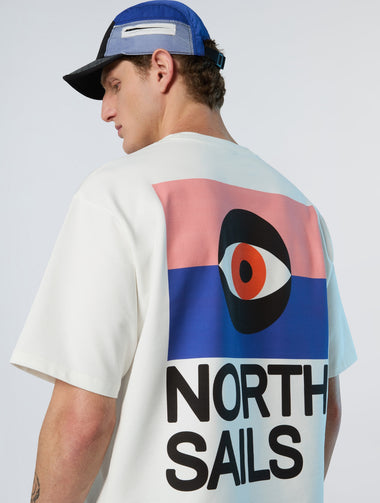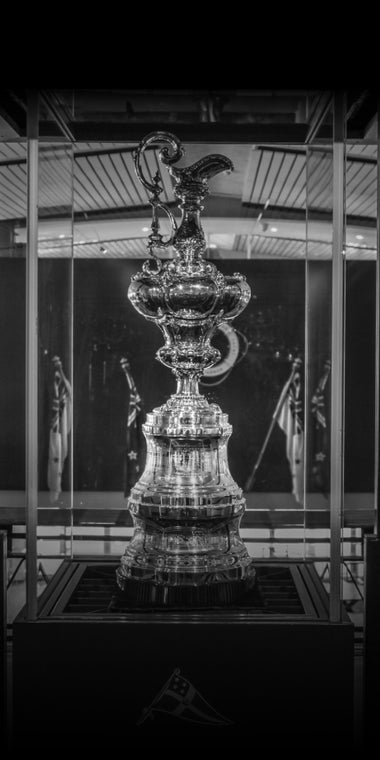NORTH SAILS BLOG
All
Events
Guides
News
People
Podcast
Sustainability
Tech & Innovation
Travel & Adventure
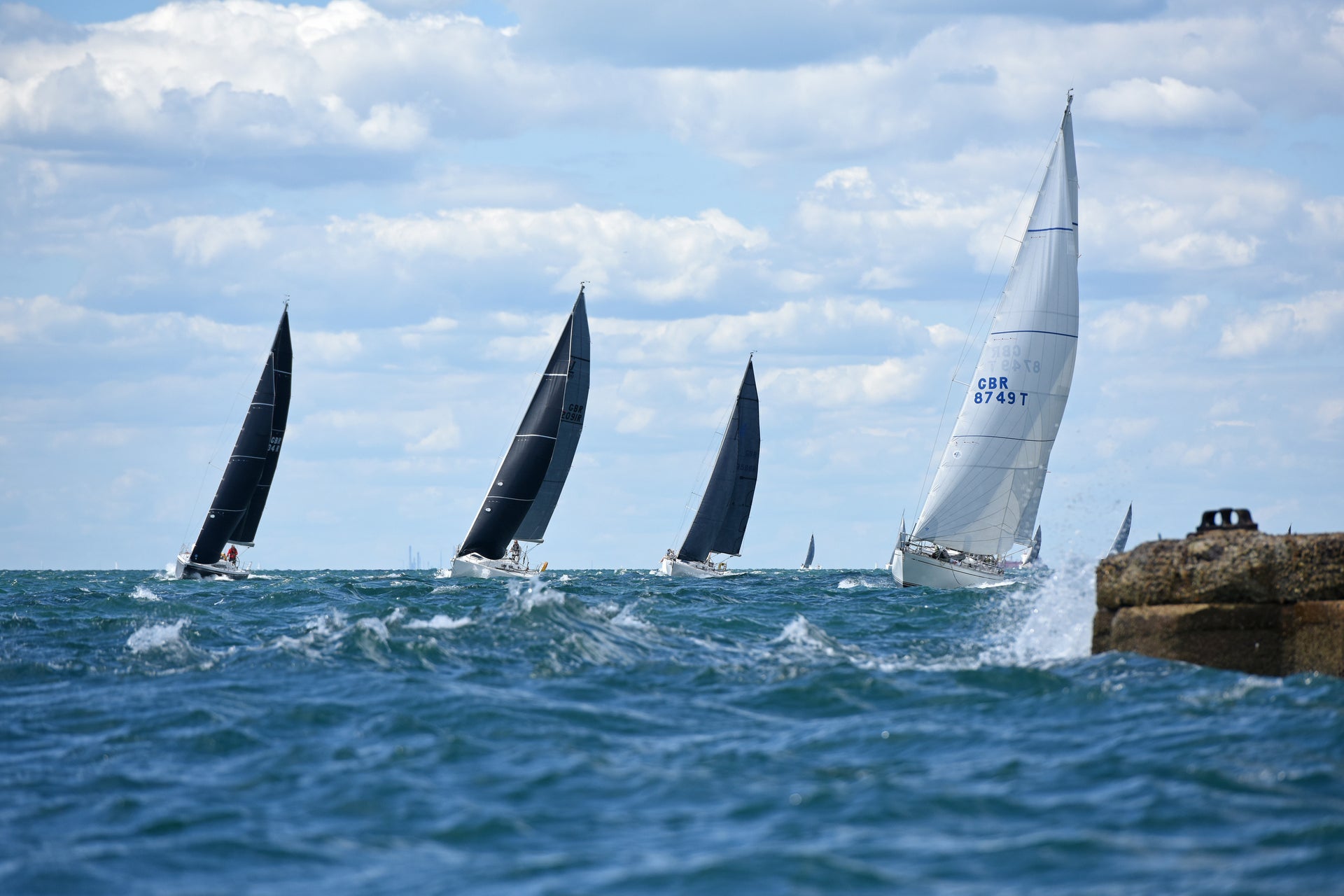
LOCAL SPOTLIGHT: CLUB RACING RESULTS WITH 3Di RAW
LOCAL SPOTLIGHT: CLUB RACING RESULTS WITH 3Di RAW
J/88 Tigris Takes the Lead in Class 1
The fleet racing towards the Nab Tower 📸 Rick Tomlinson
136 boats made up three classes who raced on the Solent last weekend for the Junior Offshore Group (JOG) Lonely Tower Race, marking the most entries for a local regatta so far this year. The 35 nm course had the fleet racing to and from Cowes, sailing around the Nab Tower which lies just offshore to the east of the Isle of Wight. Built for anti-submarine protection in World War I, the tower marks the deep-water entry into the Solent for sailors. As well as providing an amazing spectacle for all those on the water, the day also proved to be a great success for North clients. We talked to 26-year-old Sam Cooper who, alongside main trimmer Mike Haliburton, took the top spot with Gavin Howe’s J/88 Tigris in Class 1 after a total elapsed time of 5 hours, 45 minutes and 24 seconds.
The Race Course
The conditions at the start were not easy as converging air made conditions light and changeable. “The start was hard as we were one of the smallest boats on the line, with the shortest mast,’’ Sam says. “We knew the wind was going to be fickle, so we just set our course and tried our best to make the sails work around that. We could see some spinnakers flying close to the mainland shore which matched our 1km weather model, so we headed there, sacrificing the good tide. It paid off as we reached a light 5-8 knots of wind and had a good battle with Mark Spearman’s JPK 1180 Dawn Treader.’’
Dawn Treader flying their North Sails Code Zero 📸 Rick Tomlinson
The breeze eventually reached a steady 13-18 knots, and the pair rounded the Nab Tower just astern of Chris Jones’ J/111 Journeymaker, who they battled with throughout the race. After rounding Winner Buoy, Sam and Mike made the tactical decision to sail towards Portsmouth to escape the lighter air close to the Isle of Wight. “We sailed within 20m of the beach at Stokes Bay. The tide gave us good gains there, but the challenge with this leg was changing gears whilst maintaining good speed.’’ The pair followed the breeze and shifts on the upwind beat home before tacking onto starboard outside Cowes and finishing on the JOG line. Having sailed the race two times before, this result was their best. “We had said during the race that it didn’t matter much where we finished as long as we were happy with our performance in the boat. We were happy and it just so happens that we got a good result too!’’
The Sails
With a full North Sails inventory, the team raced with a 2016 3Di RAW 680 Mainsail, 2014 3Di RAW 670 J2, and a 2014 A2. “The 3Di RAW Mainsail is remarkable; we’ve pushed it since our very first outing in 2016’s Round the Island Race. It remains fast and the shape has held up extremely well. We’ve never had a sail repair either.” Team Tigris works closely with Ronan Grealish and Sam Richmond at North Sails UK. “We find them both to be full of knowledge and always there to help with our questions,”, Sam says.
“The 3Di RAW Mainsail is remarkable; we’ve pushed it since our very first outing in 2016’s Round the Island Race. It remains fast and the shape has held up extremely well. but it remains fast and the shape has held up extremely well. It has also never been repaired.’’
Winners of JOG Lonely Tower Race Class 1, Sam Cooper and Mike Haliburton with J/88 Tigris 📸 Rick Tomlinson
Shorthanded Sailing
The J/88 is different from today’s trend of doublehanded boats. It is fairly light, has moderate ballast and low form stability, with less power than the Sunfast 3300, JPK 1010, or even the J/99. “You have to sail the J/88 differently, with a focus on efficient maneuvers and sail selection,’’ Sam says. “Doublehanded sailing is great as you are freer to sail the boat exactly how you want. It also gives you a good feel for every role onboard, which I think ultimately improves each crew member onboard. For this race, I helmed, trimmed the mainsail, and had the spinnaker sheet in the hoists. Mike focused on the spinnaker drops, as well as headsail and spinnaker trim.’’
Singlehanded or Doublehanded?
Sam got involved with shorthanded sailing as his parents owned a J/92/S which they won the doublehanded class in the JOG Cowes-Dartmouth Race with. He is also known to sail solo, so we were interested to know which he preferred: “Both singlehanded and doublehanded sailing has its merits and I change my mind all the time! The J/88 is exhausting to sail solo as it is harder to keep it sailing fast compared to a wider, more stable boat. Right now I’m enjoying doublehanded sailing but ask me in a month and it could change…’’
Looking Ahead
Up next for Sam and the J/88 Tigris is this weekend for the JOG Great Escape Race where he will be racing with bowman/mastman Tim Villain. Good luck!
North Sails expert Neil Mackley at the start line on the North RIB
North Sails designer Kevin George sailing with Chris Frost onboard the Swan 36, Finola 📸 Rick Tomlinson
📸 Rick Tomlinson
North Sails expert Pete Redmond sailing with Dave Bart on the Cape 31, Tokoloshe 📸 Rick Tomlinson
Sign Up for North Sails News
READ MORE
READ MORE
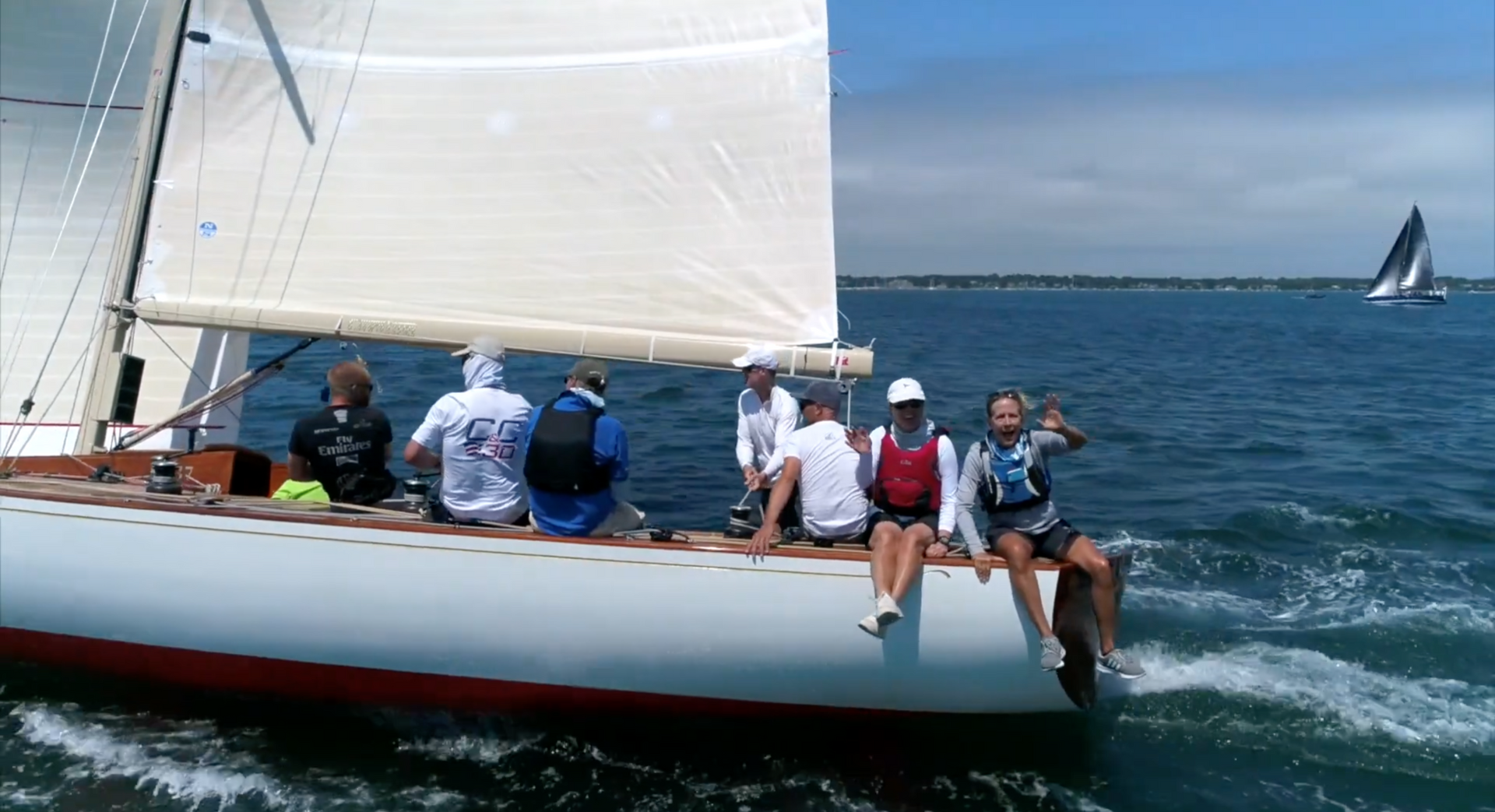
FEELS LIKE SUMMER IN RHODE ISLAND
FINALLY FEELS LIKE THE SUMMER SAILING SEASON IN RHODE ISLAND
Local Sailing Finds Perfect Conditions on Narragansett Bay
It took until mid-July but it finally feels like summer on Narragansett Bay. This past weekend 24 boats of various shapes and sizes participated in IYAC’s 2020 Newport Cup to race around Conanicut Island. Local talent, short-handed sailing, and solo kiteboarding sessions were all on display in an effort to do whatever it takes to get back out on the water.
Skipper of Class40, First Light, Sam Fitzgerald said, “it was great to get back out on the bay today and race against some new faces. Today’s conditions were challenging, especially in the beginning of the race but we had an awesome day nonetheless! We are just glad to be out here!”
The around Conanicut Island clockwise course started in a fresh southerly gradient which slowly shifted to a southwest sea breeze. The 18 mile “around the island” is a classic racecourse with upwind, downwind and reaching legs. Jason Carroll’s Mod 70 Argo was first to finish in just under 90 minutes.
“Never a bad day when you get to line up with a Mod 70 on the kite foil,” said local kiteboarder Casey Brown. ” I let Argo get a clear start, then started reeling them in as we ripped through the fleet before the wind faded approaching beavertail. Shoulda gone with a bigger kite! It was a great day on the water! Lots of stoke.”
“It doesn’t get much better than this,” remarked North Sails expert Mike Toppa. “It’s easy to take local sailing for granted but, we are lucky enough to be out sailing on one of the nicest pieces of water in the world. Schooners, kiteboarders, multihulls, classics, double handers, 12 Metres, PHRF champs, and everything in between were competing. This is different from what we all had planned for our 2020 season, but summer is short and you don’t want to miss out.”
Meanwhile, on the bay, Newport Yacht Club held their Offshore 160 Single-Handed Challenge. 15 short-handed boats set off on a 114 mile, overnight, offshore course to a buoy off Montauk Point and back. The biennial Offshore 160, held in the off-year from the Bermuda ONE-TWO, is a 160-mile qualifier for the ONE-TWO. This low-keyed, bare-bones event provides a chance for new skippers’ singlehanded to hit their qualifying passage in the off-year, and to provides past competitors with a long-distance racing “fix,” something we all need this summer
There is still plenty of racing in and around Rhode Island this summer for anyone interested in getting on a racecourse this summer. Check out the schedule below or get in touch with the North Sails loft in Portsmouth for questions or expert advice.
Contact Loft Find Your Expert
Events Coming Up Around the Bay:
M32 Midtown Cup – Jul 18-19
GSBYRA Southbay Regatta – Jul 18-19
Sail Newport Part I – July 25-26
MOHOSA Wednesday Night Worlds – July 29th
Around Martha’s Vineyard – July 30-31
Edgartown Yacht Club ‘Round the Island Race – Aug 1
Sail Newport Part II – Aug 1-2
MOHOSA Part II – Aug 2
Ida Lewis Distance Race – Aug 15-16
J/Fest – Aug 15-16
Herreshoff Museum Leukemia Cup –August 22
166th Annual Regatta & NYYC One-Design Regatta – August 28-30
Sail Newport Part III – Aug 29-30
CYC ATI Race – Sept 6
Queen’s Cup – Sept 2
Sail for Hope – Sept 12
Race Week at Newport presented by Rolex – Sept 23-26
Melges IC37 National Championship – Oct 2-4
Laser Masters – Oct 10-11
READ MORE
READ MORE
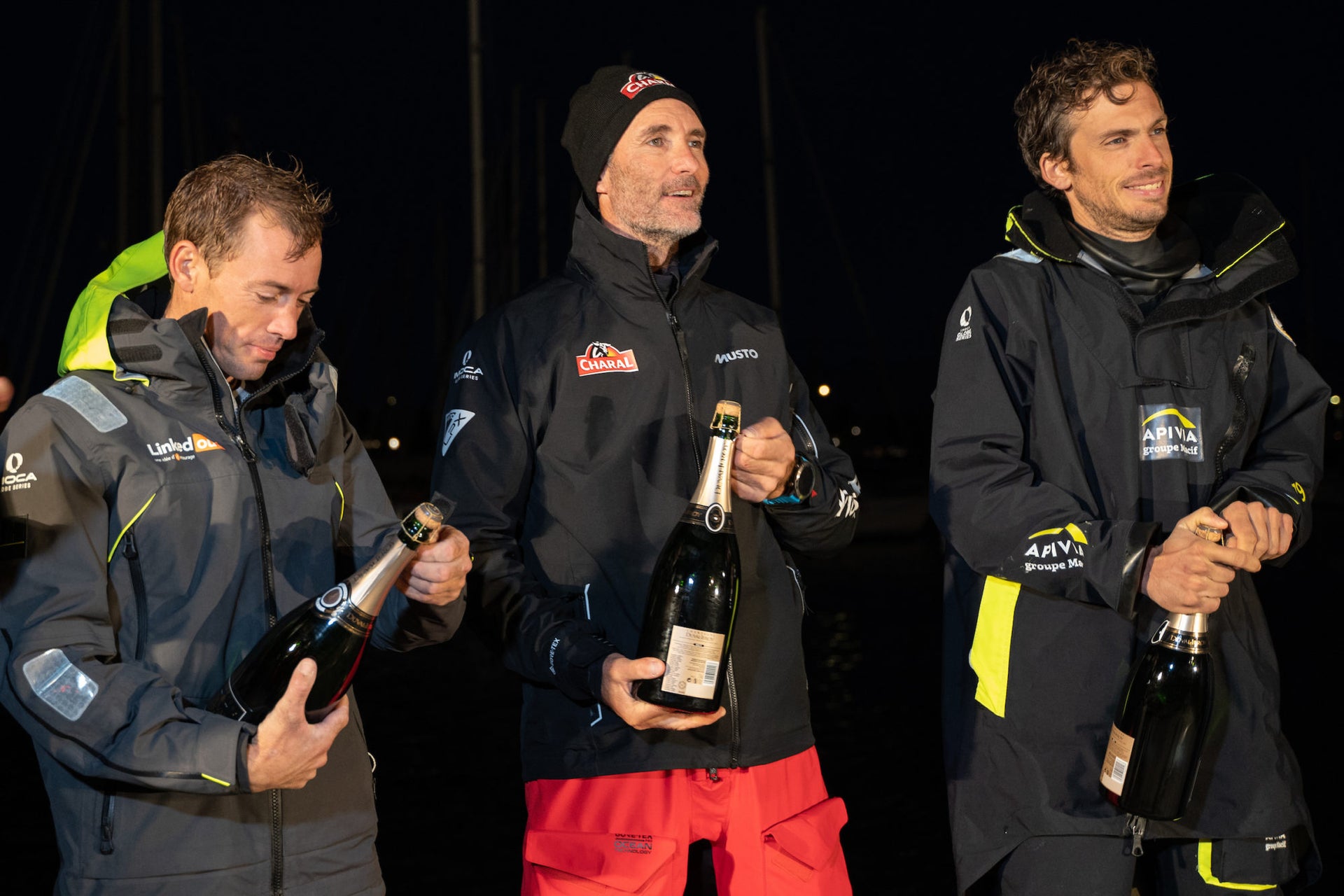
#NSVICTORYLIST: RACE RESULTS FROM AROUND THE WORLD
#NSVICTORYLIST: OFFSHORE OCEAN RACERS, LOCAL HEROS, AND ONE DESIGN CHAMPS
A Collection of Results from Around the World is Motivation to Get On The Water
Call us competitive but sitting down to write this article is very exciting because it’s the first week in a while where we have a healthy dose of race results. The noteworthy point in sharing this news is the results below are a mix of high-performance offshore racing, close to home buoy racing, and ultra-competitive one-design racing. The summer sailing season is in full swing and the #NSVictoryList is back on the board.
North Powered Teams Top the Podium for Vendée-Arctique
Over 10 days, the battle for first was well-fought amongst IMOCA skippers in a highly competitive and closely matched fleet; but it was ultimately Charal, skippered by Jeremie Beyou who claimed first, followed by second-placed Charlie Dalin on Apivia and Thomas Ruyant on LinkedOut. The North-South racecourse meant crossing a number of weather systems and a variety of conditions, making the race the perfect test of boats and sailors in the lead up to the Vendée Globe. The racing felt more ‘around-the-buoys’ than offshore, with the talented IMOCA fleet staying closely packed and lead changes happening constantly.
“I didn’t feel like setting off on the Vendée Globe without at least having done a test race single-handed,” said second-placed Charlie Dalin on Apivia. “To do that the Vendée-Arctique fulfilled its role perfectly as we had lots of situations to deal with, transitions and sail changes. It was a perfect training race to prepare for the Vendée Globe and thus validate all the work undertaken on the boats.”
Over the next few months, teams will be downloading data learned during the Vendée-Arctique to fine-tune for the Vendèe Globe in November. Stay tuned!
Local Spotlight on the Lonely Tower Race
136 boats made up three classes racing on the Solent last weekend for the Junior Offshore Group (JOG) Lonely Tower Race. The 35 nm course had the fleet racing to and from Cowes, sailing around the Nab Tower which lies just east and offshore of the Isle of Wight. Built for anti-submarine protection in World War I, the tower marks the deep-water entry into the Solent for sailors.
A win-win for local sailing, the Lonely Tower Race saw the most entries for a Solent regatta this season, and the day also proved to be a great success for North clients. 26-year-old Sam Cooper who, alongside main trimmer Mike Haliburton, claimed the top spot with Gavin Howe’s J/88 Tigris in Class 1 after a total elapsed time of 5 hours, 45 minutes and 24 seconds.
Tigris gets her speed from a great crew and a 3Di RAW Mainsail, 2014 3Di RAW J2, and A2. Cooper commented: “The 3Di RAW Mainsail is remarkable; we’ve pushed it since our very first outing in 2016’s Round the Island Race. ”
Up next for Cooper and the J/88 Tigris is the JOG Great Escape Race this weekend, where he will be racing with bowman/mastman Tim Villain. We are looking forward to seeing more boats racing on the Solent – good luck to all competitors!
Competitive Sailing, Close to Home
Narragansett Bay (Rhode Island, USA) filled with a variety of vessels to compete in two different regattas, the 2020 Newport Cup and the Offshore 160 Single-Handed talent. Local talent, short-handed, and solo kiteboarding sessions were all on display in an effort to do whatever it takes to go sailing this summer.
“It doesn’t get much better than this,” remarked Newport RI based North expert Mike Toppa. “It’s easy to take local sailing for granted but, we are lucky enough sail on one of the nicest pieces of water in the world. Schooners, kiteboarders, multihulls, classics, double handers, 12 Metres, PHRF champs, and everything in between were for this past weekend. This is different from what we all had planned for our 2020 season, but summer is short and you don’t want to miss out.”
Caipirinha Crowned King of Lake Garda
Nine Melges 32 teams lined up on Lake Garda for their first fleet meeting this season. The Melges World League warm-up event saw a fierce one-design competition to collect their first win of the season and be named King or Queen of the Lake.
Giangiacomo Serena di Lapigio’s North Sails powered G-Spot set the pace, finishing the first day of racing in the lead after scoring two bullets in two races. But after six races, it was Martin Reintjes Caipirinha who fought their way to the top and celebrated their first win in the Melges 32 class after three years of hard work focusing on improving their performance.
North clients won five of the six races sailed and just one point separated the top three finishers, showcasing the competitiveness and intensity within the fleet. Next up for the fleet is MWL Event 1 on 22nd-24th August in Sardinia, Italy, a lead-in event to the World Championship at the same venue on the 26th-29th August. We look forward to seeing some more nail-biting racing next month!
READ MORE
READ MORE
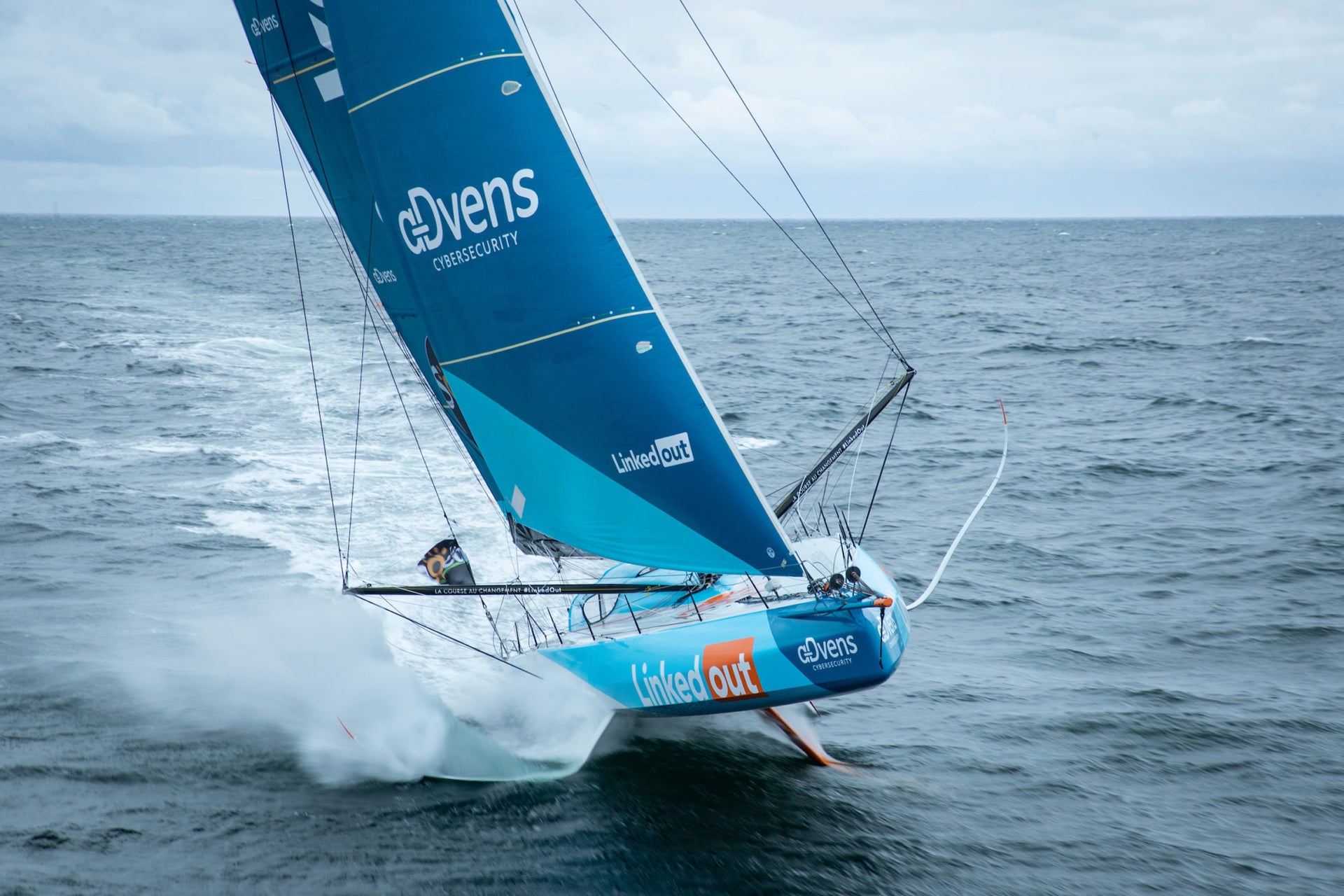
FIGHT TO THE FINISH
FIGHT TO THE FINISH
Ruyant Strives For The Lead as Others Fall Prey To Tough Conditions
© Pierre Bouras / TR Racing
The Vendée-Arctique-Les Sables d’Olonne has turned out to be a close match for the IMOCA fleet, with several lead changes on each leg so far. The Vendée-Arctique is an opportunity for those with their eyes on the Vendée Globe race to get in the required qualifying miles and put their IMOCAs to the test in a racing environment for the first time since many of them have been launched after building or refit.
The first leg showed close racing between the foiling participants, as the competitors raced upwind battling wet weather and fog. It was a tight race amongst three North Sails powered teams, Apiva, Charal, and LinkedOut to the IOC UNESCO Waypoint, but ultimately it was Thomas Ruyant who managed to take the first position around the northernmost mark, off the coast of Iceland.
François Van Malleghem / Imoca
By staying to the left side of the course, Ruyant tacked inside his competitors on the final approach to the digital waypoint, just barely a mile ahead of Charlie Dalin skippering Apiva.
“It was worthy of a round-the-cans race. It was fun for all three of us to get up there at the same time, in any case, I found it really enjoyable.” Ruyant said over an SAT phone call, “For them, maybe a little less… Above all, it was getting up there after the night I had last night that was crazy. Getting back in contact at the symbolic mark in this race, and being first to round it, it’s fantastic. I’m very happy with how things played out, but there’s still a long way to go in this race. Charlie and Jérémie are going very fast and there’s all to play for”.
Onboard LinkedOut
As the rest of the fleet rounded the IOC UNESCO Waypoint and began their second leg reach towards the Gallimard Waypoint, Ruyant held his lead but was closely followed by the nearest competitor. The two continued to trade the first position several times over the following hours.
As of 11PM Eastern Time on Friday night, Ruyant is in second by less than a nautical mile and challenging hard.
The group has been sailing in an area with winds less than five knots, meaning the past few hours have been all about managing a proper sail wardrobe and maintaining focus in frustrating conditions. Every move, tack, or adjustment will count towards the finish.
The leaders are entering a band of weather where gusts over 20 knots are expected. This will give skippers a chance to test out their boats and challenge themselves in windier weather.
At this point, the Vendée-Arctique is anyone’s race, with the top four of the fleet, including North Sails powered LinkedOut, PRB, and Charal, all within five nautical miles of the leader. With one week at sea behind them, it will be interesting to see which skippers can maintain their mental and physical stamina and who will fall behind.
Follow along with the race tracker.
READ MORE
READ MORE

BLUEWATER BORN & RAISED
BLUEWATER BORN & RAISED
French couple, Estelle and Benoît set sail with two very young crew members, their daughters.
Jeanneau 36 Sunshine, owned by Benoît (32 years old) and Estelle (30 years old) has been a primary vessel for adventure, with their three-year-old and one-year-old daughters, Diane and Aliénor.
The family is passionate about sailing, and the young couple has traveled many miles, between the Mediterranean and the West Indies for both personal and professional expeditions, documenting their experience via their Instagram account @stel_sailing. A few years ago, in St. Martin (West Indies), they learned that they were expecting, which didn’t prevent them from continuing their adventurous life on the water.
“We simply rethought our project, and we gave ourselves three years after Diane’s birth to buy our own sailboat, validate other diplomas, and welcome another baby into our family,” says Estelle.
“Diane will be three years old in August, and for the moment the project is going ahead. Benoît is now earned his 500-ton captain license, and we have completely refitted our sailboat for our next trip, with our girls Diane and her little sister, Aliénor.”
After a long five-month period of work in Port Saint-Louis du Rhône, it was time to go back to the sea. “We hoisted our new North sails in great weather conditions to sailed to Corsica. We sailed from Port Saint-Louis to Marseille under the mainsail and overlapping genoa which was great for broad-reaching with 12 knots of wind, as we hit 6 to 7 knots hull-speed. It was a perfect cruising trip for everyone to get their sea legs. Sailing from Marseille to Ajaccio was done with two reefs and staysail downwind, with wind between 15 and 30 knots, and a swell of 3 to 4 meters, which allowed us to surf, making our experience sporty and fast, as we hit 9 knots.”
“We often sail under-powered since we have our daughters onboard, as it’s a question of safety for us,” Estelle said.
“For the remaining time, our plans are not defined, and the only constraint for us is having to stop for work. , We’re currently in Corsica for the summer season, and we’ll be heading for Gibraltar, then the Canaries and Cape Verde in September, hoping to be able to cross the Atlantic in December to reach the West Indies.”
“The people we meet are often surprised to see that you can travel and live with a family of four on a 36-footer, especially when you see families sailing on 40-footers minimum or catamarans,” explains Benoît.
This family shows us that everything is possible, even with little ones. “All it takes is a good organization, patience, and a few concessions of comfort can be quickly forgotten by the beautiful moments shared together! “
“Amazingly, our daughters are comfortable on the boat. Diane and Aliénor have developed an unparalleled balance. They’ve always known the boat as their home, it’s a familiar environment for them,” Estelle reports. “Sailing, changing ports, discovering new places, and meeting new people are now part of their normal, daily life.”
Through this alternative lifestyle of slow travel and taking things easy, the family has found a good compromise to combine their lifelong passion with their now, daily regiment. These experiences reinforce and unite the family, but also enrich and build their relationship together.. If you happen to meet them on the water, don’t hesitate to drop by!
READ MORE
READ MORE
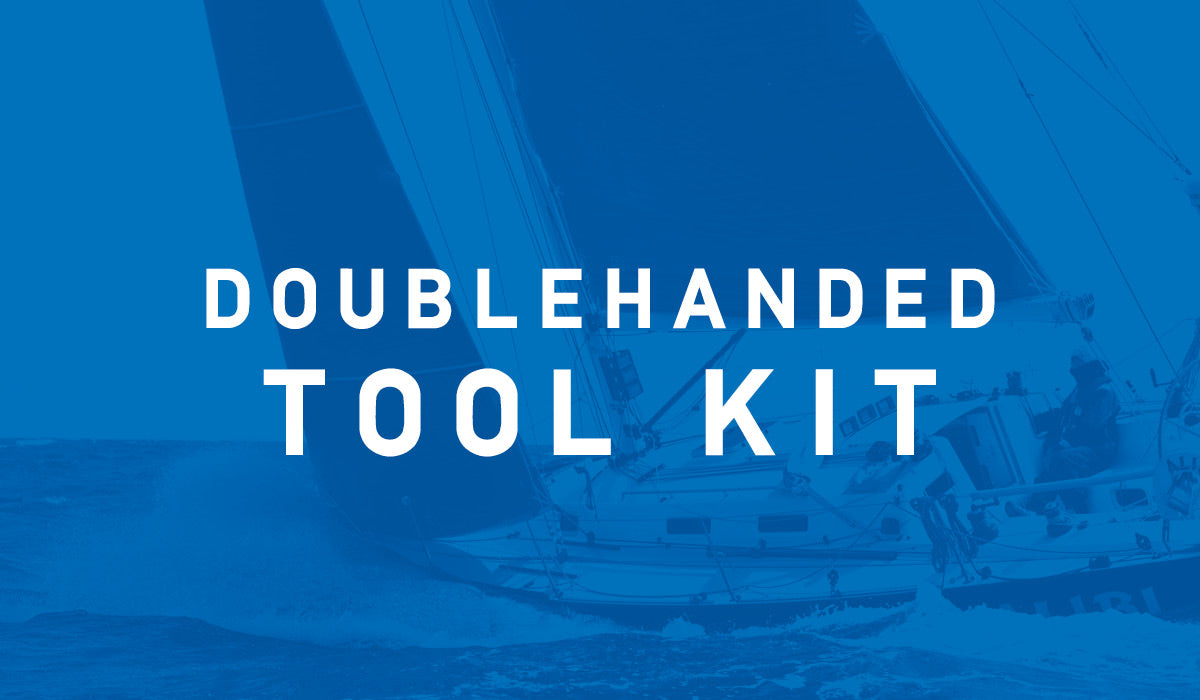
DOUBLEHANDED TOOL KIT
The Rise of Doublehanded Sailing
Doublehanded sailing has gained momentum globally, as the gateway to getting back out on the water while remaining socially distant. It is also the latest event added to Paris 2024, so now is the time to find out more.
Armel Le Cléac’h and Clarisse Crémer Give a Rundown of Their Experiences
North Sails were lucky enough to have the two doublehanded experts Armel Le Cléac’h & Clarisse Crémer host a webinar for an in-depth masterclass. Quizzed by Ken Read, the pair discussed choosing the right teammate and how they got involved in the sport.
Learn More
Two Brains are Better than One
Suzy Leech teamed up with Ken Read to take on the Fort Lauderdale to Key West Race earlier this year. Each sailor brought a different set of skills to the table which led this powerful collaboration to take the win in the 24-hour doublehanded sprint race.
Learn More
Paris 2024 in Sight
With nearly 20-thousand miles under his belt, Sam Fitzgerald is a seasoned Class40 racer and has his sights set on being a part of the doublehanded discipline for the upcoming summer games. Read about how he plans to make his vision a reality.
Learn More
Dynamic Duo Achieves Class40 Domination
Catherine Pourre and Pietro Luciani are the reining Class40 World Champions with their North Sails allowing them to push the boat to its full potential. The pair share their best key takeaways for successfully managing a doublehanded racing program.
Learn More
Racing the Sun Fast 3300
Having never sailed the Sun Fast 3300 before, Ken Read explains why he wanted to get involved and take on the challenge of racing it from Fort Lauderdale to Key West with Suzy Leech.
Learn More
Shorthanded Sailing at a Local Level
After three months of no activity, sailing on the Solent kicked off in June with 36 single and doublehanded racers. The North RIB launched to offer coaching, sail trim tips, and support to all.
Learn More
Have questions for your local North Sails expert? Contact your local loft today.
READ MORE
READ MORE
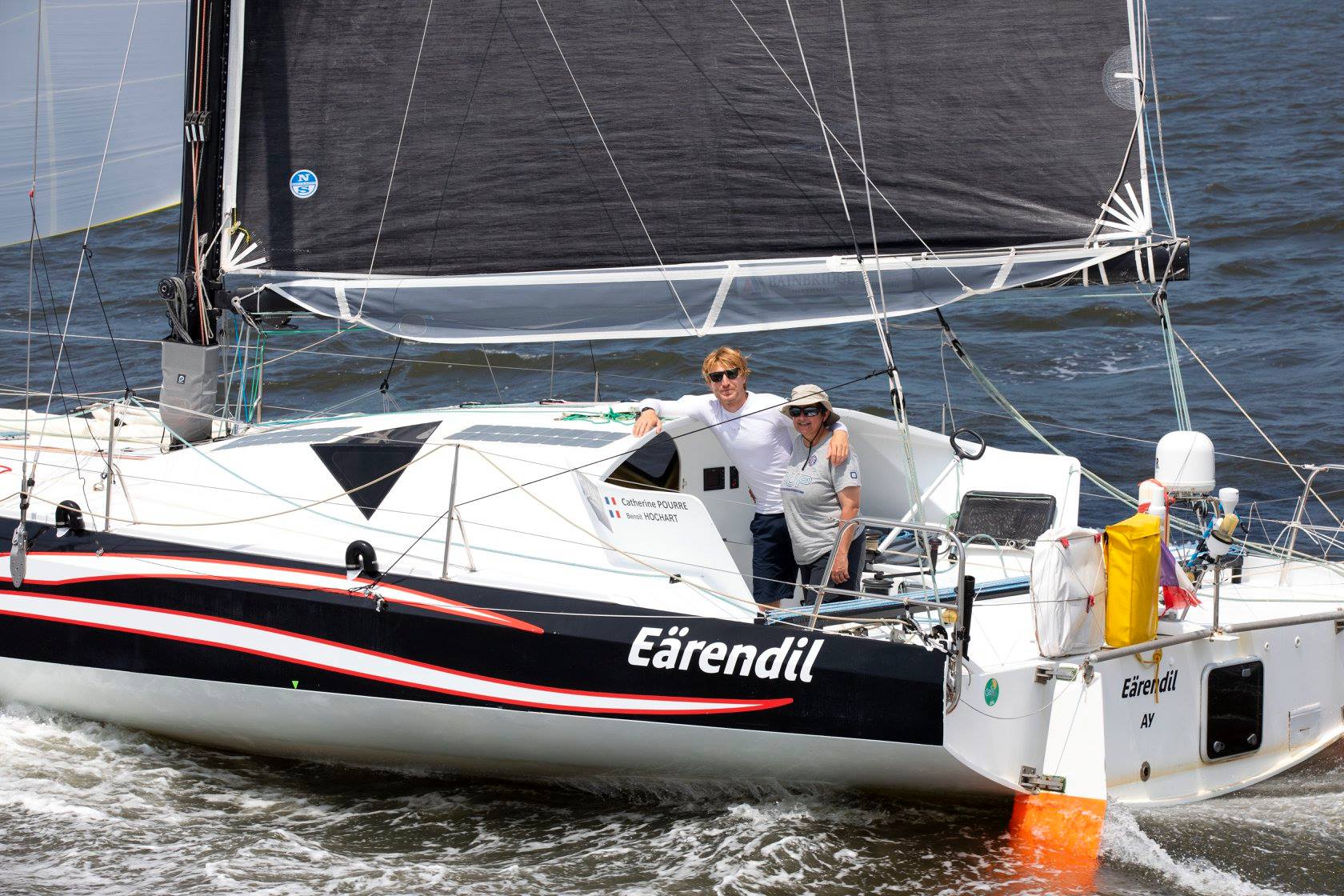
IT TAKES TWO...
IT TAKES TWO…
… To Race the Rocket That is Eärendil, Win Multiple Titles and Dominate the Class40 Fleet
Billy Black / The Atlantic Cup
Owner and co-skipper, Catherine Pourre and co-skipper Pietro Luciani are the winning duo onboard Class40 Eärendil. Together, the pair are the reigning Class40 World Champions, have twice won the RORC Caribbean 600, The Atlantic Cup, placed runner up in the Defi Atlantique, and earned top-three placement in the Rolex Fastnet Race and The Normandy Channel Race. With countless offshore miles between them, their North Sails have allowed the team to push the boat to its full potential, unlocking the secret to total domination in the Class40 fleet.
Catherine and Pietro share their best tips for successfully managing a doublehanded racing program:
Your sails must be reliable. This is always true, but it’s even more true when it comes to doublehanded sailing. Having to fix your sail, or deal with problems while at sea, will affect your race a lot more than if you were racing fully crewed. Choosing a sailmaker who has great experience in the type of boat you are sailing with is important.
Your sails must be strong and versatile. Having sails that are a little stronger and more ‘forgiving’ than regular sails for fully crewed races is key. We sail with a full set of 3Di, built for a broader range of conditions. Often with the Class40, and sailing doublehanded in general, you find yourself sailing slightly overpowered, and always anticipating a change in wind force. Maneuvers for a great doublehanded team can take 10 minutes and use up a lot of valuable energy. Knowing that you can keep the same sail up for a longer period of time without exploding it, even if it’s not ideal, is peace of mind in this mentally and physically challenging doublehanded platform.
Your sail inventory should fit into a wider crossover range. This is for two reasons; you need to still be able to sail fast, even if you break one sail (which happens more often in doublehanded racing), and to reduce maneuvers. Our sails are much more versatile rather than specialized, with a narrow range-use.
When training, try to switch positions. Even if it’s pretty clear that the younger/stronger is going to the bow, having tried the other way around will help both to understand your sailing partner’s needs during a maneuver.
Don’t be shy in waking up your co-skipper when in doubt. If you have a doubt about navigation, or about performance, you need to speak up. I’d personally prefer to go take a nap if I know my partner will wake me up as soon as he/she may need me. Especially in difficult conditions, when you might feel a little guilty leaving the other alone.
Keep your boots on! Go to sleep but always be ready to report back on deck. When your partner wakes you up, you need to be on deck right away, with no delays.
Whatever watch system you adopt, be fair to one another. Being selfish or being over-generous will not work with just the two of you. Together you need to adopt a system that makes you both comfortable, so if you need to wake up your partner before the end of your watch, you can do so without any second thought.
Billy Black / The Atlantic Cup
READ MORE
READ MORE
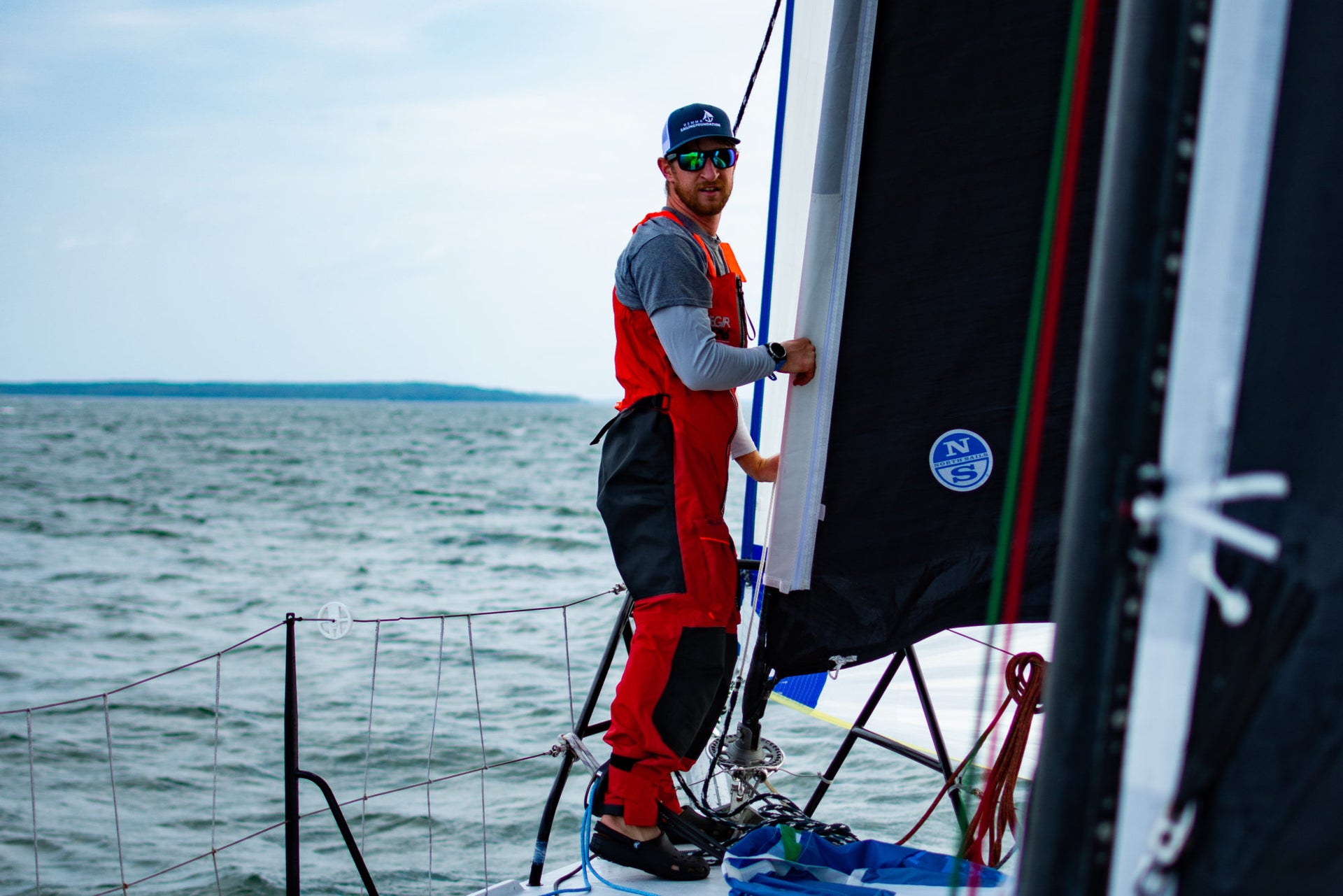
DOUBLEHANDED DREAM
DOUBLEHANDED DREAM
Sam Fitzgerald Has Been Cutting His Teeth in the Class40 With Paris 2024 Aspirations In Sight
With nearly 20-thousand miles under his belt, Sam Fitzgerald is no stranger to the challenges of going offshore, especially with only two sets of hands onboard. A naval architect and seasoned Class40 racer, with accolades in races like the New England Solo Twin, Bermuda 1-2, Atlantic Cup, and Defi Atlantique, Fitzgerald has sights set on being a part of the latest event added to the Olympic Games, doublehanded offshore sailing.
Read on below as Fitzgerald talks about his introduction to shorthanded sailing:
How did you get your first opportunities in doublehanded sailing?
I didn’t really get into doublehanded sailing until my early twenties and growing up in Connecticut, there weren’t a lot of opportunities to try it out either. I hope the discipline continues to grow in the US. More yacht clubs are providing opportunities for younger sailors to get into shorthanded sailing.
What was your first shorthanded sailing experience like?
My first shorthanded experience was one of those magical experiences you see in movies. We had a bomber run from Charleston to NYC in our Class40 during The Atlantic Cup and ended up fourth on the leg. We finished just before sunrise with our A2 up, screaming past the Statue of Liberty. It was truly amazing! After that, I was completely hooked and knew I wanted to pursue a career.
What maybe not so obvious skills did you need to learn or develop to be able to shorthanded sail?
Something that might not be so obvious to some is the need for organization and foresight. If you can’t organize your boat properly and be able to foresee your next step-up or step-down gearchange, then your maneuvers are going to take forever. Shorthanded sailboats are set up to easily complete tasks around the boat, but it also means there are about four times the number of lines you need to manage. On top of that, being able to use brute force to complete a task won’t work. This leads to winches always being used which leads to being locked out quickly. It’s really important for a shorthanded sailor to know exactly what needs to be done to step up and step down because if you see a squall line coming through and you call your co-skipper the last thing you have time for is to explain what to do next.
In the US, where shorthanded sailing isn’t as popular, how have you made a name for yourself?
Shorthanded sailing has begun to gain traction in the US, however, it isn’t nearly as popular as other disciplines. In order to make a name for myself, I have tried to look for every opportunity there is to compete doublehanded, whether small local regattas, deliveries, and traveling often for overseas events. The shorthanded sailing community is obviously even smaller than the sailing community, so getting to know people is really important. I’ve used my network through the years to find racing partners overseas.
What are your Paris 2024 aspirations? What are you doing to prepare? What do you think of the format?
2024 might be far away for some, but for the small community of shorthanded sailors in the US like myself, it’s right around the corner. With the newest sailing discipline added last year, everyone is scrambling to find the right co-skipper, training platform, and funding. As of now, I am continuing to train on my Class40 whenever I can, even if it means doing some maneuvers around the bay for a few hours. Off the water, I have a workout regime and I cycle as much as possible. The format of the event is fairly straight forward, a three-four day offshore race out and back.
In terms of offshore sailing, this is on the short side, so teams will be able to go all out. What will be interesting to see, besides the platform they choose, is the equipment allowed and/or supplied to the competitors? Will routing be allowed, or will the World Sailing take a page out of the Mini 6.5 class and make it illegal? If routing is allowed, to what extent and what equipment is supplied if any? Only time will tell.
What advice would you give someone who is interested in doublehanded sailing?
If you’re interested in doublehanded sailing, I say go out and do it! You don’t need an offshore racing sailboat to try it out, find a friend, and a boat. Take turns trying to sail it with two people and see how you like it.
READ MORE
READ MORE
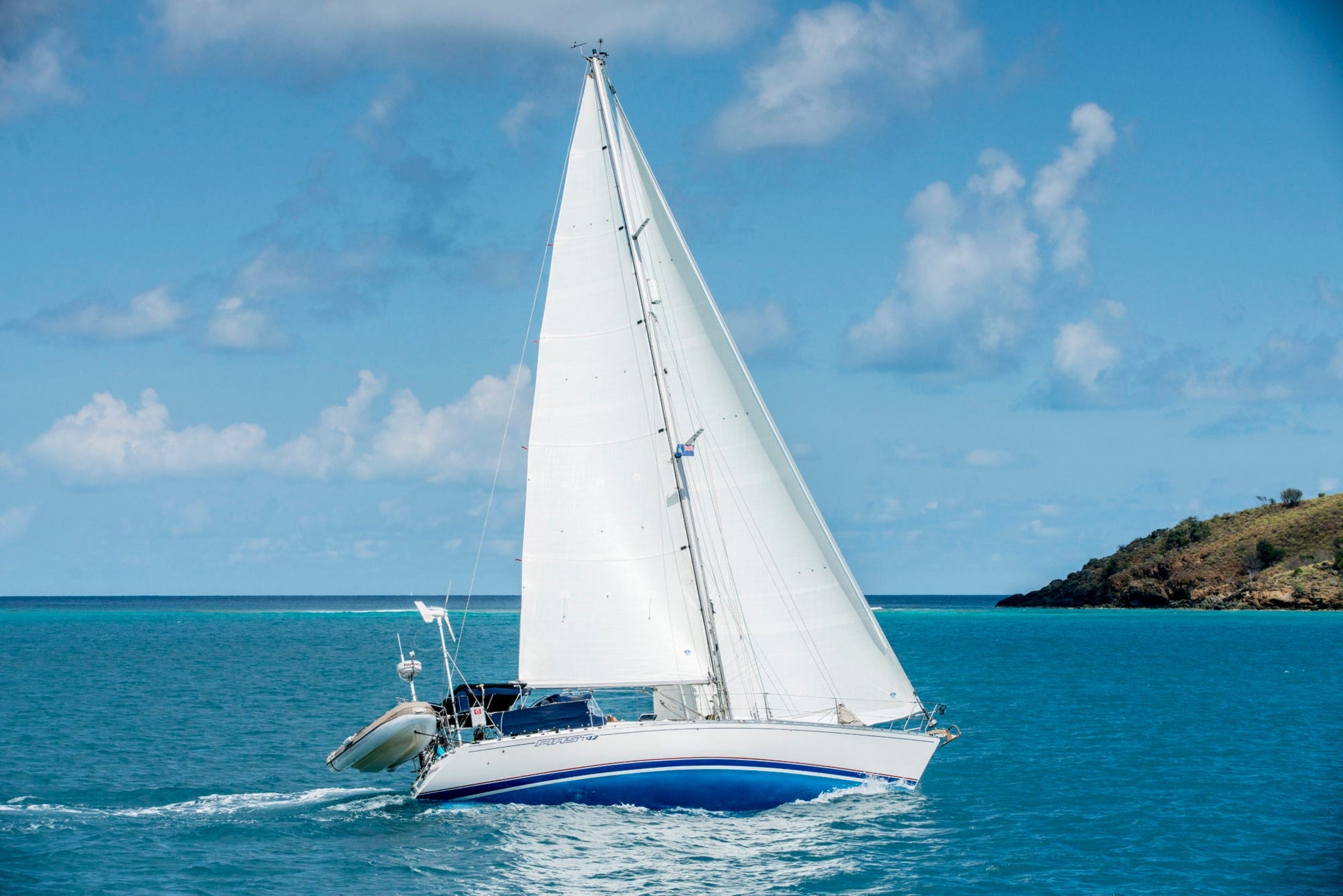
3Di OCEAN ER SKABT TIL CRUISING
3Di OCEAN; FÅ SVAR PÅ DINE SPØRGSMÅL
Lær mere om den nye 3Di OCEAN produktserie med vores Q&A
Q: Hvad er 3Di OCEAN?
A: 3Di OCEAN er den nyeste serie af 3Di sejl fra North Sails, designet og udviklet specifikt til cruisingsejlads.
Q: Passer 3Di OCEAN til min båd og min type sejlads?
A: 3Di OCEAN er det rette for dig, hvis du leder efter et cruisingprodukt i højeste kvalitet, med uovertruffen styrke og holdbarhed samt alle fordelene fra 3Di-sejlteknologien.
Q: Hvad er anderledes og bedre ved 3Di sejl?
A: 3Di er en sejl teknologi som kun North Sails har adgang til og som resulterer i formstøbte kompositsejl helt uden film. Strukturen skabes ved at tapes bestående af tynde fibertråde impregnerede med ensærlig lim lægges ud i forskellige retninger og i forskellige densiteter på en hydraulisk 3D-form. Termoset lim strukturen hærder ved hjælp af varme og slutresultatet bliver et ekstremt stærkt og glat sejl med præcist den form som designeren har specificeret. https://youtu.be/OCFEYvqXDus
Q: Hvad er forskellen mellem 3Di OCEAN og jeres andre 3Di produkter?
A: 3Di OCEAN er optimeret til cruising og har fokus på holdbarhed og styrke, mens 3Di RAW-sejlet er udviklet til minimal stræk og vægt. 3Di ENDURANCE-sejl er egnet til både cruising og kapsejlads – med en god balance mellem ydelse og holdbarhed.
Q: Hvilket 3Di OCEAN sejl er det rigtige for mig?
A: 3Di OCEAN fås i tre forskellige varianter:
OCEAN 330 er 100% NORDAC polyester og passer til cruisingbåde mellem 25-45 fod.
OCEAN 370 er en blandning af Ultra PE- og 3Di NORDAC-fibre og er udviklet til både på mere end 45 fod. Den er særligt god til eksempelvis cruisingkatamaraner som sætter ekstra høje krav til styrke og formstabilitet.
OCEAN 700 er til både på over 60 fod og bygges i en blanding af UltraPE og aramid.
Q: Hvor længe har North bygget 3Di cruisingsejl?
A: 3Di-teknologien har været på markedet i mere end et årti og er blevet brugt af tussindvis af både som har tilbagelagt millioner af sømil.
Q: Hvilke særlige fordele er der ved 3Di OCEAN sejl?
A: En stor fordel ved 3Di OCEAN er dets enestående holdbarhed. 3Di NORDAC Polyester- og UltraPE-fibre har bedre motstandskraft mod UV-stråler og slid end andre typer fibre som anvendes i tursejl. Den specielle kompositkonstruktion indeholder ingen mylar, hvilket gør at et 3Di-sejl ikke kan delaminere, noget som ellers er almindeligt for laminat- och membransejl. 3Di OCEAN har et ydre fiberlag som beskytter mod ridser og slid, hvilket gør det særligt egnet til eksempelvis rullstorsejl.
Q: Er 3Di OCEAN sejl gode til kapsejlads?
A. Ikke så godt som et ENDURANCE eller RAW sejl! OCEAN er ikke udviklet til kapsejlads. Dog kan det fungere fint til kapsejlads på lokalt niveau men er du ude efter et sejl til både tur- og seriøs kapsejlads, bør du vælge 3Di ENDURANCE. Eller RAW, som er udviklet til kapsejlads på højeste niveau.
Q: Hvad med andre materialer? Laver North stadig cross-cut cruisingsejl?
A: Ja. Hvis du er intresseret i panel sejl har vi flere alternativer. Vores NPC Cross-Cut-sejl er bygget af traditionel vævet polyester, og NPL Tour er baseret på vores egne laminatduge i højeste kvalitet. Uanset hvilke behov og forventninger, har vi et cruising sejl som passer til dig.
LÆS MERE OM MATERIALER FIND ET LOFT FÅ ET TILBUD
READ MORE
READ MORE
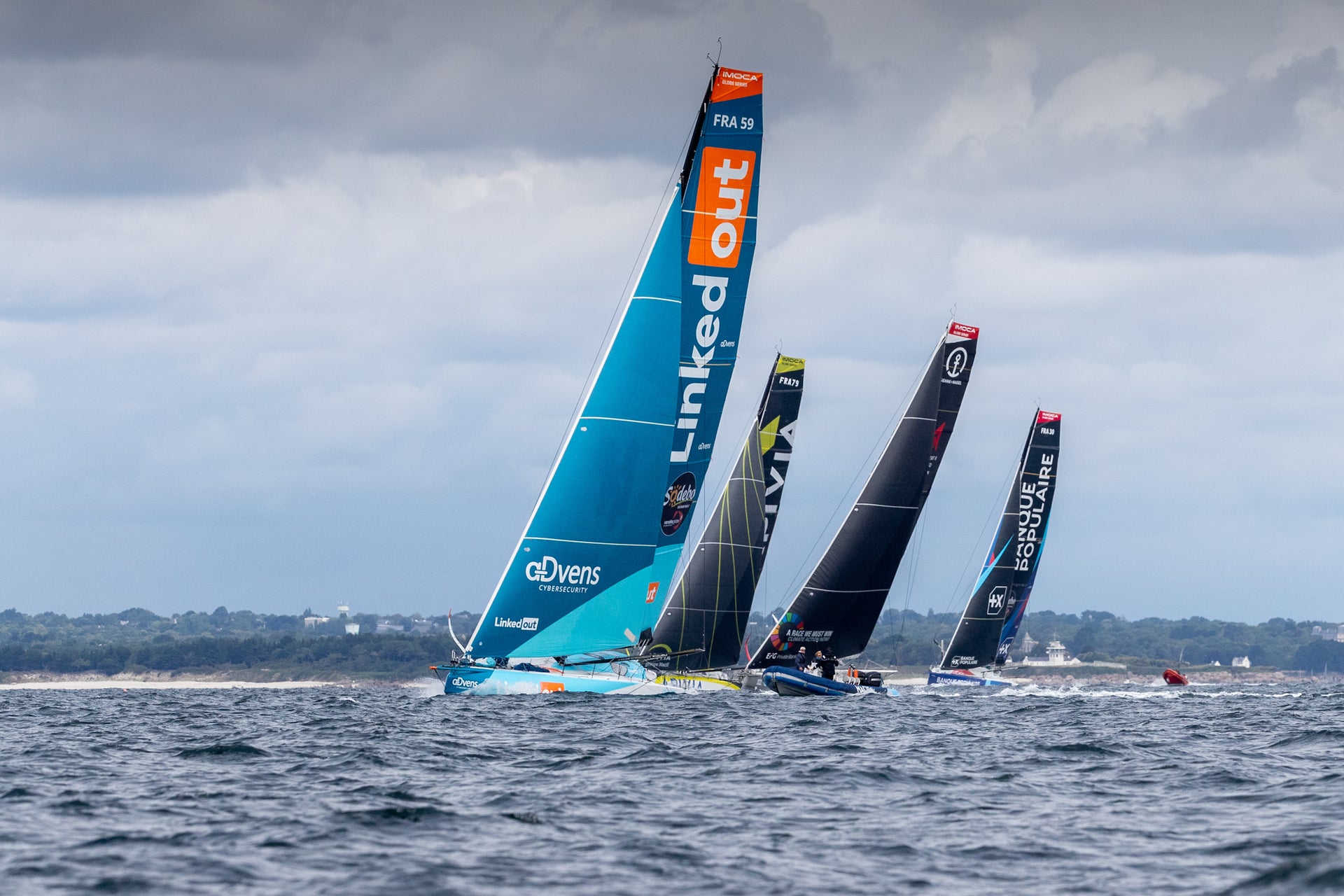
VENDÉE-ARCTIC SETS THE STAGE FOR VENDÉE GLOBE
VENDÉE-ARCTIC SETS THE STAGE FOR VENDÉE GLOBE
The Vendée-Arctic Fleet Works Towards a Common Goal
©Eloi Stichelbaut – polaRYSE / IMOCA
20 competitors, including 3/4 of the fleet equipped with North Sails (full or partial) will line up on Saturday, 4th July at the start of the Vendée-Arctic-Les Sables d’Olonne, an unprecedented ocean race.
“We had to reinvent ourselves to tackle ocean racing in a different way,” explains the organizers of the Vendée-Arctic – Les Sables d’Olonne. This brand new competition was born out of the particular context of the pandemic crisis to replace two major races that were canceled this year on the IMOCA class calendar: The Transat and the New York-Vendée, which were essential events for the sailors in their preparation for the 2020 Vendée Globe scheduled on the 8th of November. Sailors must have a certain number of miles to qualify for the Vendee Globe and need racing offshore to test their boats; thus, a single-handed ocean race was, therefore, crucial for the IMOCA boats.
The Vendée-Arctic will be the only opportunity for sailors to face each other in conditions close to those of the Vendée Globe, the so-called “Everest of the Seas.”
This race is 3,566 miles long and will lead the IMOCA fleet on a long Atlantic loop, passing to the west of Iceland, close to the Arctic Circle, as far as the Azores and then finishing in Vendée. An atypical, ambitious and demanding course where the skippers will be competing in conditions that are unusual and tricky in this part of the world, particularly in the opening phase: strong headwinds, rough seas off Rockall, heavy commercial shipping, presence of whales, cold weather…
New Race, New Challenge
This very first edition brings together a rich line-up of 20 skippers, including four women, representing six different nationalities. 14 skippers will be equipped with North Sails sails (10 with a full set and four with a partial inventory). Just making the starting line of this unprecedented competition was no easy task for the competing teams. The health crisis has greatly disrupted and slowed down their preparation schedule for the Vendée Globe. During the lockdown, they had to reinvent themselves and rework an already tight schedule.
“Everything was timed from the finish of the Transat Jacques Vabre at the end of 2019 to the start of the Vendée Globe at the end of 2020 and the whole calendar had to be reworked,” indicated Jérémie Beyou (Charal) in a press release. “Mentally, you prepare yourself in a very precise plan and to question that, when you have programmed yourself, it’s not easy.”
“Before the official announcement of the Arctic-Vendée, the teams were in Vendée Globe mode,” explains Thibaut Agaugue, Head of Service at North Sails France. “After that, they had to concentrate on this new race in record time. We had a lot of discussions with them to help them as best as we could.”
©GauthierLebec/Charal
Each team has therefore redoubled its efforts to prepare in the best possible conditions. “Covid-19 slowed down our preparation for the season, but I was able to sail single-handed twice for four days and then eight days,” explained Kojiro Shiraishi, the Japanese skipper of DMG MORI Global One. “I would have liked to sail even more miles to test and experience the boat. I did not have time to test the sails to their maximum performance. The good thing is that they are well designed.”
Since the end of the lockdown, Clarisse Crémer on Banque Populaire X has scheduled numerous offshore sailings and one-day sessions. “In a month and a half, we have focused all our objectives on sailing,” she explains. Otherwise, the boat is almost in Vendée Globe configuration. There will be enough to test everything during this race”, she says. This will be the big jump for the young female sailor, who is taking part in her first solo ocean race. Inevitably, she feels a bit anxious. “Yes, I’m quite apprehensive, as it’s a big first for me to be racing alone on this boat. It’s good to be able to experience a fairly demanding course before the Vendée, though Iceland is still far away and cold. The weather conditions look set to be a bit rough at the start of the race so we’re going to get into the thick of it.
@IMOCA / Vendée Arctique Les Sables d’Olonnes
Even if most of the skippers fear this new and complex course on extremely physical boats, they are all enthusiastic about racing back on the water and competing in real conditions since the lockdown. “I can’t wait,” confides Kojiro Shiraishi, who is signing his first major ocean race on his new foiling IMOCA, DMG Mori Global One (VPLP design) built by Multiplast and equipped with North Sails. “This will be an opportunity to test the boat for the Vendée Globe and to go to areas where there is a lot of wind, cold but also warmer zones. It’s good training before the Vendée Globe.”
Five other latest-generation IMOCA boats, including four fully equipped with North Sails, will also be competing in the Arctic-Vendée: Apivia (Charlie Dalin), Charal (Jérémie Beyou), LinkedOut (Thomas Ruyant) and l’Occitane en Provence (Armel Tripon), who in spite of major damage to her starboard side following a collision with a UFO 10 days ago will be able to take part in her first ocean race.
©Eloi Stichelbaut – polaRYSE / IMOCA
The organization has put in place several strict measures to ensure that the race can take place. The skippers had to be confined five days before the start to avoid any contact with the outside world.
This was also an opportunity to carry out a thorough checklist of the equipment and systems on the boat as well as the material to be taken on board, to focus on the weather, to anticipate scenarios of electronic breakdowns or even to choose the sail inventory, a real headache at times: “Which sails to choose? These are difficult decisions to make,” says Kojiro Shiraishi. Another measure taken by the race committee is that the boats are leaving their home port 24-hours before the start off Les Sables d’Olonne on Saturday. There will be no village or access to the pontoons.
The Vendée-Arctic: a testing ground for IMOCAS
The stakes in the Vendée-Arctic are various. The race will enable the candidates to validate their technical choices for the Vendée Globe in terms of performance and reliability. For the North Sails designers, says Yann Andrillon, it will be a question of “helping them as best as we can with the fitting and trimming of the new sails they want to test during this race.”
The course in the Vendée-Arctic will require some tricky maneuvers and sail changes. Each skipper will be able to fine-tune his or her sailing style and understand his or her future choices for the Vendée Globe.
“In terms of performance, I would like to see how the boat generally behaves and how far I can push her,” adds Kojiro Shiraishi, “I will be testing the sails during the race and figuring out if there is a need to change them. The sails are the engine of the boat, so they are particularly important elements for the boat. And I want to validate that not being young anymore, I want to be able to sail well without hurting myself,” he concludes.
@IMOCA / Vendée Arctique Les Sables d’Olonnes
In addition to the sporting stakes of this race, several skippers will also have the mission of studying the health of the Atlantic Ocean. Six of them will deploy specific buoys during the race to collect meteorological and oceanographic data and two boats (Newrest-Art & Fenêtres, Fabrice Amadeo and SeaExplorer – Yacht Club de Monaco, Boris Herrmann) will take on board sensors measuring the ocean’s salinity, CO2 levels, temperature and microplastics in the water.
Even though many are hoping to win the Vendée-Arctic, all the skippers will be working hard to complete the course and make sure their boat comes back in one piece. And whatever the ambitions and motivations behind this race, they all have a common goal: the Vendée Globe.
READ MORE
READ MORE
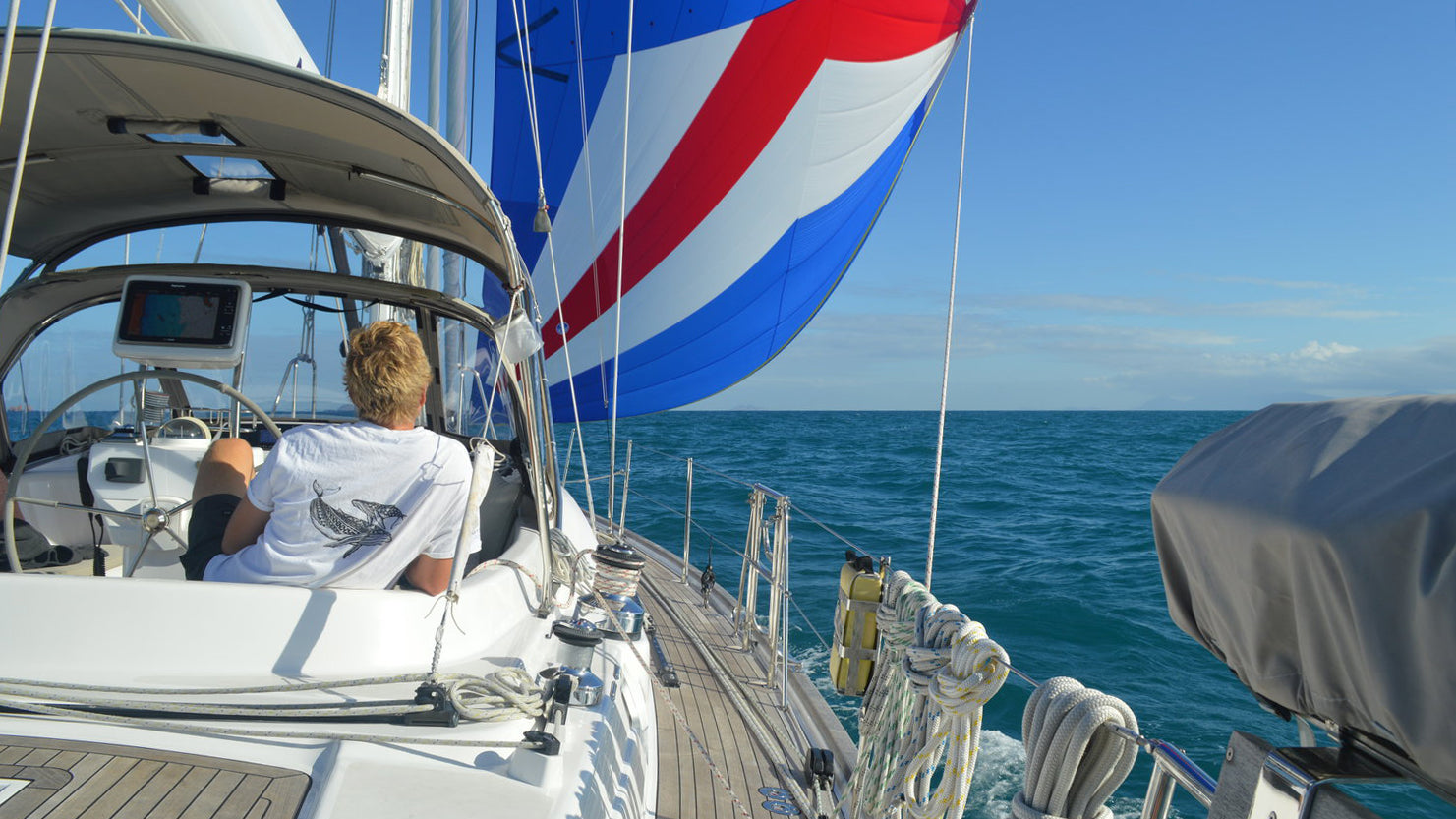
KEN & LIISA BACCO CAST OFF WITH THE OYSTER WORLD RALLY
KEN & LIISA BACCO CAST OFF WITH THE OYSTER WORLD RALLY
Oyster 47.5 Altair Sports North Cruising Sails For Round-The-World Adventure
In 2016, Ken and Liisa Bacco set sail from Newport, Rhode Island on December 1st during a snow storm onboard their Oyster 47.5 cutter rig, Altair, to meet up with the Oyster World Rally (OWR) in Antigua. Departing Antigua in January of 2017 with the OWR, the Baccos have circumnavigated the globe, making memories and forming new friendships along the way.
“Something we did find out is that 99.9% of the people in the world are wonderful,” remarked Ken. “Wherever we were, people wanted to help us and get to know us. They made a point to come over and say hello, which was encouraging being in places we’d never visited before.”
How did they get the opportunity to take on an adventure like this? “The stars aligned,” said Liisa. “Our kids had left the nest, we were healthy, and it was the best time in our lives to do it.”
Ken and Liisa’s kids would join them from time to time on their stopovers. : Ken, daughter Laura, Liisa, and their son Matt.
The Baccos took delivery of their new sails in 2015, and have since logged over 40,000 miles on them. “It’s quite a feat to think our sails have made it tens of thousands of miles around the world with our original suit of North Sails,” said Ken. “And everywhere we’ve gone, we always get comments on our mainsail. People all over the world have told us, ‘your mainsail is gorgeous!’. We couldn’t be happier with our investment.”
Altair’s mainsail is equipped with three reef points. They have a furling genoa, a staysail, and a trysail which runs forward on a track. “Our staysail is so critical,” says Ken. “You’d think wing on wing would be good, but the staysail makes all the difference in the world for stability.” For making pace-off the wind, they trust in their asymmetric spinnaker. They use a KZ Furler and a Future Fibres torsion cable for their A2 which is on the furler. Liisa calls it “their secret weapon.” Having the right set up makes it easy for the duo to sail shorthanded in any condition, and stay safe.
NPL TOUR is built to last, but the Baccos ensure its lifespan by staying on top of maintenance, taking advantage of a few key loft locations around the world.
“Making sure things are in the best shape makes the entire experience run smoothly.” Says Liisa, “We can’t say enough about our relationship with North Sails and the service teams we’ve worked with. Now that we’re full-time cruisers, we know we’ve made the right choice when it comes to sails for our boat.”
From Portsmouth, RI, to Milford, CT , Antigua, and South Africa, Ken and Liisa credit experts Service Manager Eric Wakefield and Sail Expert Tom Castiglione with making their bluewater cruising experience fun and easy. Andrew Dove at North Sails Antigua pitched in to teach the couple everything they needed to know about choosing the right battens, and installing them correctly.
The Bacco family has sailed all over the world, and their quest for adventure is never-ending. They’ve logged stopovers to many areas, including the Caribbean, South Africa, New Zealand, Madagascar, Indonesia, Fiji, Panama, French Polynesia, and many more.
Joining The Oyster World Rally
When visiting the UK, Liisa learned about the Oyster World Rally. This was when the boat was being built. Ken said; “Liisa called me and said we’ve got to do this!” The Oyster World Rally provides a once in a lifetime, non-competitive opportunity for Oyster yacht owners to sail around the world. This adventure around the planet is focused on safety and yacht support combined with stopover points in unique destinations.
The rest is history. “We’ve made so many friends for life joining the Oyster World Rally,” says Ken. “We all take turns organizing trips together, and everyone is fun to sail with. We really enjoy adventuring with this group. They are a fun group and we’ve seen some amazing places together.”
The Baccos dove with sharks four times in Fiji. Ken remarked, “swimming with 15’ tigers and bull sharks was an incredible experience. We were in about 40’ of water, and the divers started chumming. The sharks liked to feel the bubbles from the scuba regulators so you could touch them as they swam overhead. It was crazy.” Liisa reflected on the whole experience a week or so later and said, “we were both like oh my god, that was stupid, I can’t believe we did that!”
“Cape Town is a beautiful, exciting city,” said Liisa. “The V&A Marina is right downtown with Table Mountain in the background. Shopping, restaurants, movie theaters. The Oyster World Rally fleet settled in to explore the city, visit wineries, go on safari and perhaps fly home for the holidays.”
“Winds were up dangerously high when we pulled into Madagascar. We had three reefs in our main and the storm jib up. We made it to the dock safe, and had one hell of a party that night,” said Ken. The couple spent a few days exploring ashore, making friends with some lemurs during their time on the island.
“We were tucked into this tiny cove, and there were tsunami warnings.It was 2:32 in the morning and all of a sudden I felt the boat moving- it was insane. Ken remarked; “People say you don’t notice when there’s an earthquake…well we could absolutely feel it! Locals said they happen everyday, all the time. The Indonesians we encountered were cheerful, kind, helpful, proud of their country and eager to share it with us.”
The Oyster fleet docked in Indonesia. Ray, the owner, threw a party for the Oyster fleet with local food and entertainment. The Baccos celebrated a friend’s birthday who was sailing onboard another Oyster, and with an incoming shipment of fresh food, the fleet was ready to depart to their next stopover. “Little did we know that more earthquakes and a terrible tsunami would hit Indonesia shortly after our departure. It truly is heartbreaking to imagine,” said Liisa.
“Panama was such a wonderful place,” said Liisa. “There were out-rigger canoes, not far from Panama City. We adventured around the San Blas Islands, just off Panama. The people there were incredibly nice. There were perfect white sand beaches, and the locals have kept their culture so intact. It was our first experience on the rally with true indigenous people–it was a beautiful spot,” said Liisa. The Panama Canal was interesting. “By size, the Oyster rally fleet rafted together three-wide and took turns helping each other get through. When the gates opened it was amazing to see the Ocean. It took about two days to get our entire fleet through the Panama Canal. It was such a cool experience,” said Ken.
“We sailed into Manhattan Harbor which was quite the scene. The Statue of Liberty was right there, the city was beautiful and you could see the Freedom Tower. It brought on very emotional feelings for us to be back home again,” said Liisa.
We can’t wait to find out where Ken and Liisa are headed to next. Until then, read more about the Bacco’s never-ending adventures around the world here.
READ MORE
READ MORE
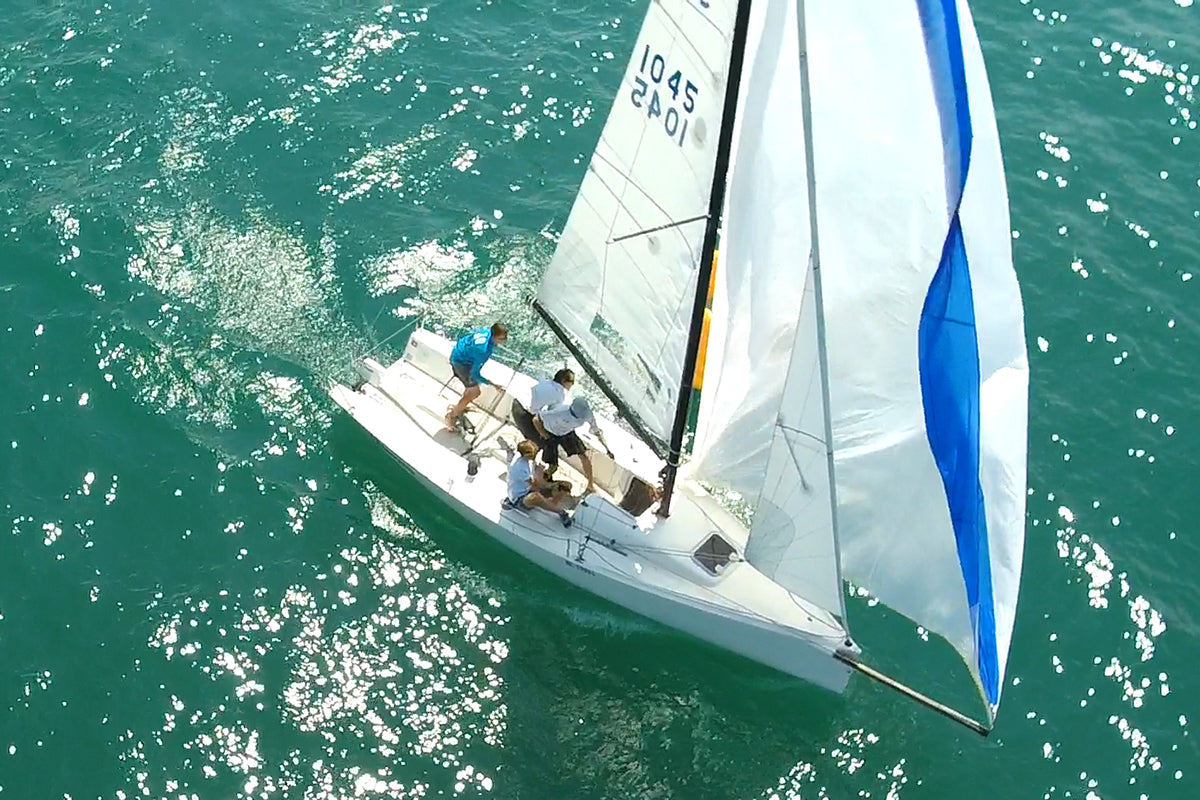
DIE REGATTASAISON IN DER SCHWEIZ IST GESTARTET!
DIE REGATTASAISON IN DER SCHWEIZ IST GESTARTET!
Nach langem Warten ist die Schweiz am vergangenen Wochenende endlich in die Regattasaison gestartet. Über 1‘000 Segler haben zum Teil traumhafte Bedingungen genossen.
Am Bodensee gewannen gleich an drei grossen Anlässen North Sails Segler!
In Kreuzlingen fand das erste J70 Battle mit 37 Booten aus der Schweiz, Deutschland und Österreich statt. 85 % des Feldes vertraut dabei auf North Sails, unter anderem auch das komplette Podest und alle Laufsieger (ausser 1 anderen Vorwindsegel).
Am Samstag konnten drei Leichtwindläufe, am Sonntag gar 4 Läufe bei etwas auffrischendem Wind gesegelt werden.
Gewonnen hat das Battle das Nachwuchsteam aus Oberhofen mit Timo Zeltner am Steuer (SUI 1045), vor dem Team aus La Neuveuille mit Lorenz Kausche (SUI 1120) und Lorenz Müller mit seinem Team vom Bielersee (SUI 1142).
Rangliste
Vom Club 55 Bodensee spontan ins Leben gerufen wurde die ‚Rund um Corona 2020‘.
Am vergangenen Samstag nahmen am Rennen rund um den Bodensee (diesmal aber tagsüber) sieben der schnellsten Katamarane am Bodensee, teil.
Nach rund 10 Stunden, nach Flautenlöchern wie auch Topspeeds von über 20 Knoten, kamen Tom Rüegge mit Team Orang Utan gefolgt von Sammy Smits mit Green Horny als erste ins Ziel. Berechnet hat Green Horny gewonnen.
Rangliste
Am Untersee in Steckborn fand der Bernina Cup statt. Die Starsegler konnten am Samstag und Sonntag je 3 Läufe fahren.
Es gewann das Team Seger/ Oesch (SUI) vor Ryffel/ Heinz (SUI) und Barth/ Rutz (GER).
Rangliste
Herzlichen Glückwunsch allen Siegern und danke für euer Vertrauen!!
READ MORE
READ MORE

HOW TO MAKE YOUR OWN YOUTUBE PLAYLIST
HOW TO MAKE YOUR OWN YOUTUBE PLAYLIST
Collect and Save Your Favorite Videos for Yourself, or to Share.
Our YouTube channel has over eighty webinars from North Sails Experts in lofts across the world, participating in many different fleets. North Sails is proud to bring our customers a wealth of tips to help you achieve the results you are looking for. Explore topics such as cruising Code Zeros, technique from top racers in the J/70 class, or hear an exclusive talk about the majestic J Class Yachts. There are webinars for any sailor out there!
Follow along below to learn how you can create a playlist of your favorite North Sails Webinars for yourself or to share with your team.
Find a video you want to add to your YouTube playlist.
Under the video, click Save.
Select Watch later, Faves, or a playlist you’ve already created, or click Create new playlist.
Use the drop-down box to select your playlist’s privacy setting. If it’s private, only you can view the playlist.
Click Create.
If you would like to talk one-on-one to any of our experts, click here!
Step 1
Step 2
Step 3
Step 4+5
Step 6
READ MORE
READ MORE
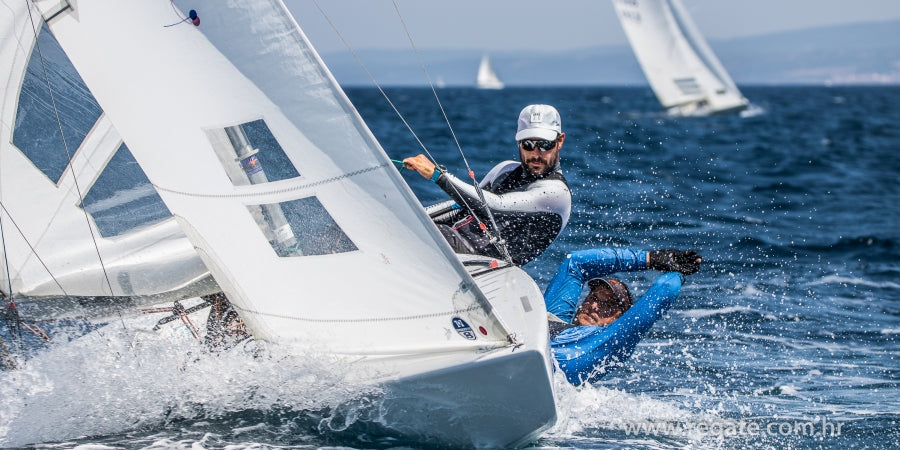
STAR CLASS SPLIT TRAINING WEEK
Star Class Split Training Week
Prošli tjedan se u JK Mornar okupilo šest posada u klasi zvijezda. Većinom su to bili domaći momci iz Splita, a pridružila im se po jedna posada iz Šibenika i Mađarske.
U Mornara je i inače najaktivnije po pitanju klase Zvijezda posljednjih desetak godina od kada je Mate Arapov prestao s jedrenjem u Laseru i kad je jedan određeni period proveo u ovoj klasi. Nakon njega najozbiljnije su se ove klase uhvatili posada Mišura - Barač, a nekoliko posljednjih godina sve više za Zvijezdinim kormilom provodi Tonči Stipanović čiji aktualni flokist je Tudor Bilić.
Nažalost, teško se dogovoriti sa svima jer dosta jedriličara je spriječeno poslovnim obavezama, tako da smo Tudor i ja, zajedno s braćom Perhat (Lovrom i Mladenom) najviše izlazili na more, a ostali su se priključivali kako su mogli. Međutim, kako je ponedjeljak bio praznik uspjeli smo napraviti trening s četiri broda i tijekom sedmice još jedan trening, jer i meni treba vremena da se vratim u taj brod. Nakon jednog dana jedrenja idući dan bude posvećen radu po brodu kad sređujemo detalje za koje smo primijetili da nam ne rade dobro. I to je u principu bio ritam kako se sve odvijalo... dan jedrenja, pa dan trimanja... znači na moru smo proveli ponedjeljak, srijedu i petak, a utorak i četvrtak su bili rezervirani za rad po brodu.
Zatim smo u subotu i nedjelju imali regatu. Izvorni plan je bio da regatu organiziramo na Hvaru, ali kako nisu uspjeli doći svi koji su planirali (još dvije hrvatske posade) odlučili smo ipak ostati u Splitu.
Inače što se mene i Tudora tiče mislim da nam je ovaj tjedan izvrsno došao. Još sam bio oslobođen treninga u Laseru, a dobio sam i doma slobodno (smijeh), tako da smo maksimalno iskoristili vrijeme kako za treninge tako i za pripremu broda. Testirali smo različita jedra, ispitivali različite centre i tražili što nam najviše odgovara po tim uvjetima. I uspjeli smo cijeli tjedan imati i veću brzinu i bolji kut od ostalih. Do sada po uvjetima koje smo imali prošli tjedan, imao sam značajnih problema u svakom pogledu, ali ovog puta dosta sam vremena proveo u istraživanju prilikom kojeg mi je dosta pomogao jedan francuski jedriličar koji je sudjelovao u razvoju ovih jedrilica. Koliko dobro je upućen u nijanse govori i to da na osnovu serijskog broja trupa može dati dosta korisnih smjernica jer su različite serije iz tvornice izlazile s nekim razlikama u karakteristikama.
Tonči Stipanović, JK Mornar
Što se same regate tiče, u subotu je puhalo 8 - 10 čvorova maestrala i napravljene su dvije regate. Jedrenja su trajala oko 55 minuta i ovog puta se ključnim pokazao ključ "tko prvi do Čiova - njegova je regata". Tako da je bilo najvažnije dobro se postaviti na startu i obraniti desnu stranu u prvoj orci.
U nedjelju je bilo slično, osim što je prvi plov morao biti prekinut na kraju prve krme, jer je vjetar izdušio. Startalo se po ugodnih 7 - 8 čvorova maestrala koji su nakon dvadesetak minuta pali na jedva čvor ili dva.
Srećom, vjetar se ubrzo vratio, samo što se regatno polje moralo pomaknuti još više prema Čiovu. Tada se jedrilo po više od 12 čvorova i stvarno je bio užitak vidjeti ove jedrilice u njihovoj punoj snazi! Ali takvi uvjeti uzeli su danak u nekim malo istrošenijim dijelovima opreme i u kondiciji posada koje nisu toliko kondicijski spremne poput posade našeg sugovornika.
Ove aktivnosti dovele su do toga da se razmišlja i o organiziranju Prvenstva Hrvatske za ovu klasu, a koje bi se moglo održati za vrijeme PH za klase 470, Finn i RS:X, a od inozemnih nastupa trenutno se najavljuje nastup posade Stipanović - Bilić na Europskom prvenstvu klase na Gardi. Termin bi trebao biti mjesec listopad, a za očekivati je i da će na Gardu otputovati i posada Mišura - Barač.
Na istoj toj lokaciji za desetak dana trebalo bi se održati Prvenstvo Italije i ako epidemiološka situacija ne bude promijenjena na put bi trebao otići Tudor Bilić i zajedriti s Flaviom Favinijem kormilarom tima Mascalzone Latino na Luis Vuiton Cupu 2007. godine.
Na fotografijama u fotogaleriji može se primijetiti da je glavno jedro na Zvijezdi posade Stipanović - Bilić oznaka klase bila zlatna zvijezda. Uobičajeno je da je riječ o crvenoj petokraci, ali kako su imali jedro koje su dobili od Roberta Scheidta ono je imalo tu posebnu oznaku. Naime, po pravilima klase, kormilar koji je bar jednom postao svjetski prvak klase ima doživotno pravo na svom glavnom jedru imati zlatnu zvijezdu.
READ MORE
READ MORE

THE BEST SAILS FOR CRUISING
North Sails Has An Option For Every Type Of Cruiser
A few months ago, North Materials Expert Tom Davis wrote an article titled “What are the Best Sails for Club Racing?” It only seems logical to have a companion piece that focuses on cruising, so you can better understand about the differences between club racing sails and cruising sails and all the options you have.
Are club racing sails and cruising sails the same? No. Club racing is narrow in scope compared to the wide world of sailboat cruising. So, unlike the club race article (where sail size and shape were discussed), here we will cover all of North’s cruising sail materials. Once you know your own cruising goals, you can narrow down what will be best. If you have any questions about a particular material, remember your nearest North expert is just a click away and ready to help you make the best selection.
Which sail cloth should I choose for cruising?
For upwind paneled sails on cruising boats, we offer fill-oriented NPC CROSS-CUT, NPC RADIAN, NPL SPORT, and NPL TOUR. We also have 3Di cruising sails to consider. Our 3Di OCEAN product line consists of three types of 3Di materials, made for different sized boats: OCEAN 330, OCEAN 370, and OCEAN 700. The 3Di ENDURANCE line represents a “crossover” zone, with sails well suited to both cruising and racing.
For downwind, there are woven nylons, Code laminates, and 3Di Downwind options to choose from. You’ll also need to decide between an asymmetric or symmetric spinnaker.
A 22-foot pocket cruiser and a 22-meter ocean going yacht can each be successfully matched to the ideal material because there are many options for either. The trick is to work with your sailmaker to quickly narrow-down the choices of sail material to perhaps two sensible options based on your requirements. Then relax and enjoy the whole process of deciding exactly what is best for you in material, LP%/roach profile, batten configuration, number of reefs, color, and so on. This can and should be fun.
Things you should consider when narrowing down your options:
Your budget
Your expectation for how long a sail should last
Your expectation for how “perfect” a sail’s flying shape needs to be as the sail ages
Your desire to have the sail weigh as little as possible while meeting the above criteria
NPC CROSS-CUT NPC RADIAN NPL TOUR + TOUR ULTRA
NPL SPORT 3Di OCEAN
North Paneled Cloth
Sticking with upwind sail materials for now, and beginning with paneled sails (i.e. where sailcloth panels are cut from rolls of material) the starting point is woven polyester, often called “Dacron”. Polyester yarn is a good all-round performer on small to mid-size boats. It resists damage from environmental exposure. It is reasonably strong, and not excessively stretchy. And the price of a Dacron sail is at the low end of the range. Let’s summarize in bullet point form:
NPC CROSS-CUT – A Fill Oriented Cross-Cut Dacron Sail
Budget: when price has to be as low as possible, a NPC Cross-Cut sail is the right choice. Durability: these sails stay in one piece, even after many seasons of hard use. Sailshape Perfection: Decent when new, but flying shape will change a lot with age. Weight: Not light. Less of a problem on smaller boats, but very noticeable as LOA goes up.
NPC RADIAN – Radian Warp-Oriented Dacron Sail
NPC RADIAN is an enhanced version of the paneled dacron sail. Panels can be radially oriented in these sails which confers a measurable improvement in sail shape-holding.
Budget: Still relatively low in price, Radian prices just a bit higher than fill-oriented NorDac. Durability: These sails stay in one piece, even after many seasons of hard use. Sailshape Perfection: Quite good when new, but expect some shape change with age. Weight: Not light – but lighter than a crosscut Dacron sail. Not available for longer LOAs.
North Paneled Laminates
Staying with upwind sail materials and paneled sails, the next tier of materials is laminated cloth (in Northspeak, NorLam). Laminates present the opportunity to reduce sail weight, improve shape holding, and incorporate high modulus (low stretch) and high tenacity (strong) fibers, along with polyester in both yarn and film form. When designed and manufactured correctly, laminated sailcloth is very durable, while helping keep sail weight reasonable, and resulting in very good sailshape performance.
NPL TOUR & TOUR ULTRA
Xi Cruise styles are aimed at mid-size cruising boats looking for both moderate price and enhanced sailing performance. Xi Cruise styles feature polyester woven outer plies surrounding polyester film and Ultra PE (high modulus) fiber on the inside. The outer layers protect the Ultra PE yarn, while the Ultra PE high modulus content reduces bulk and stretch.
Budget: Medium price level. Durability: Not quite as long lifespan as woven dacron, but ages gracefully. Sailshape Perfection: Very good when new, with moderate change over time. Weight: Medium – On bigger boats, the weight savings are very welcome compared to dacron.
NPL TOUR ULTRA – NorLam Ultra X
Ultra X styles are available for mid-size through super-size cruising boats. The key difference between Xi Cruise described above and Ultra X is the use of UltraPE fiber in Ultra X. UltraPE offers near ideal fiber performance, with very high modulus and tenacity, along with remarkable toughness and environmental resilience. In laminated cloth, we weave the UltraPE, and we pack a lot of this fiber into the cloth. That’s not a low-cost approach, but it does result in enhanced performance and extended sail life.
Budget: Higher price level. Durability: Excellent. Sailshape Perfection: Very good, because there is a lot of UltraPE in the material. Weight: Medium.
NPL SPORT – NorLam Ultra XC
Take everything noted above about Ultra X, and add carbon fiber. I’m going to assume everyone knows about carbon fiber these days given its ubiquity in race cars, bicycles that seem to weigh almost nothing, 80-foot boats that seem to weigh almost nothing, and pretty much every cool high-performance product that seems to weigh almost nothing. North Sails has been laminating UltraPE and carbon fiber together in cruising sailcloth for bigger boats for more than twenty-five years; and the results are still remarkable.
Budget: High price level. Durability: Excellent. Sailshape Perfection: Very good, approaching excellent. Weight: Medium (Lighter than Ultra X, but you still need to pack-in a lot of fiber for the long haul).
And Now… in 3D!
We recently codified a full line of 3Di products made expressly for cruising boats under the OCEAN group name. A key piece of identifying this line was the introduction of a new 3Di “material” type – 3Di OCEAN 370. Let’s dig a little deeper into what makes 3Di OCEAN ideally suited to cruising, in a similar materials based context to the paneled sail information above.
First though, if you’re not clear on the differences between 3Di and paneled sails (or 3Di and “string membrane” products), please take a look at our material page for more information on the difference in sail material types. 3Di represents a technology step-change in sailmaking. It is a more complex, and therefore more costly way to advance sailmaking.
For cruisers, this complexity has straightforward benefits: better shape-holding in lighter weight sails with no decline in durability. Should every cruising sailor, therefore, forget about paneled sails as an option, given the engineered superiority of 3Di? No. Paneled sails remain a viable choice for all the reasons noted above; and depending on your priorities and budget remain a good option for many sailors.
3Di OCEAN 330
Retain the benefits of NORDAC polyester as described above, and enhance them with the technology of 3Di – that’s OCEAN 330. Originally called 3Di NORDAC, OCEAN 330 makes the most of polyester fiber in upwind sails.
Budget: Medium price level by “dacron” sail standards, low by 3Di standards. Durability: Excellent. Sailshape Perfection: Good (very good, if not excellent, by woven polyester sail standards). Weight: Medium (not light, a lot of fiber in filament form is packed into these sails).
3Di OCEAN 370
OCEAN 370 brings UltraPE into the mix along with polyester, significantly boosting strength, while improving stretch performance. There’s a size/load point with 100% polyester sails where the sails become just too bulky, and weight aloft really starts hurting boat performance. The sails are difficult to handle and store. OCEAN 370 steps up where OCEAN 330 is not viable – doing so cost effectively, while nicely balancing the attributes of sailing performance and extended lifespan.
Budget: Medium. Durability: Excellent. Sailshape Perfection: Very Good compared to directly competing cruising sail options. Weight: Medium.
3Di OCEAN 700
OCEAN 700 is an ideal performance cruising solution for bigger boats with higher load sails. UltraPE is the primary filament/fiber type, with aramid judiciously introduced in maximum load zones of the sail. Tough, low in stretch, and engineered to provide many years of service, OCEAN 700 is the cruising reference standard for mid-size to superyacht scale boats.
Budget: Medium. Durability: Excellent. Sailshape Perfection: Very Good. Weight: Medium.
That describes our full lineup of upwind cruising sail choices. North Sails representatives have the expertise to guide you to the exact right sail from within this broad range. If your plans include a share of racing along with cruising, 3Di ENDURANCE series sails cross over into the sail shape/sail weight performance envelope that racers require. And our hardcore race product line, 3Di RAW, delivers speed like no other sail type can. Stay tuned for an update on best material choices for downwind/reaching sails, whether cruising or racing.
CONTACT YOUR EXPERT REQUEST A QUOTE
READ MORE
READ MORE
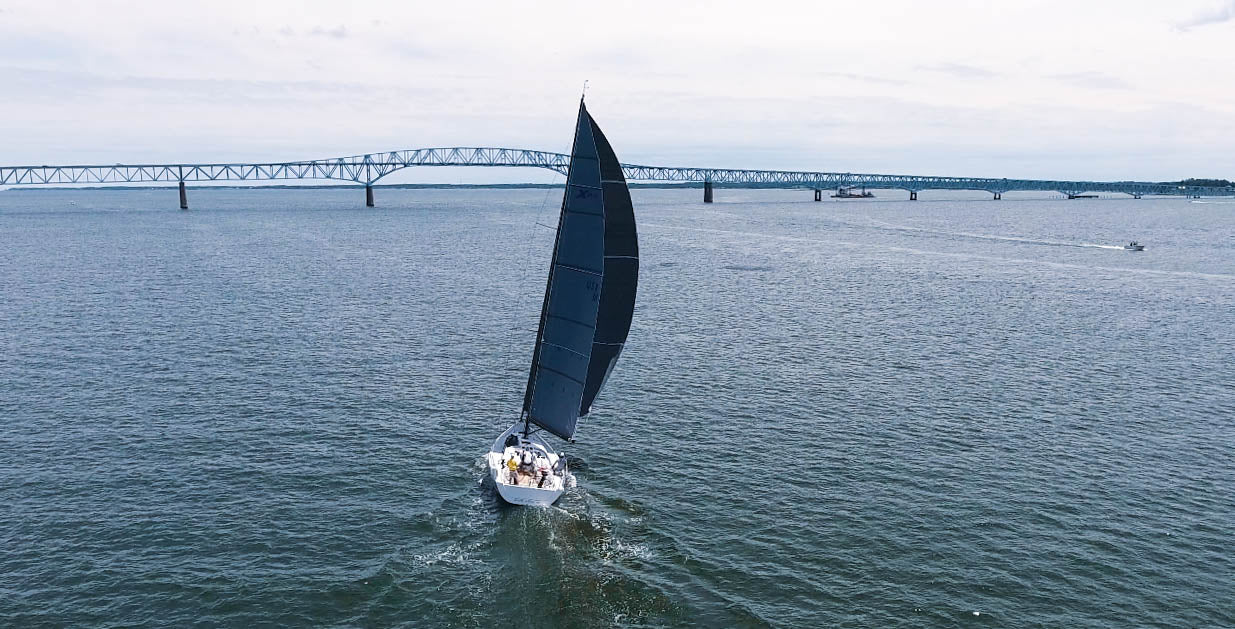
XP 44 BOMBSHELL GOES WITH HELIX
XP 44 BOMBSHELL GOES WITH HELIX
A Match Made In Heaven
North Sails expert Austin Powers out of our Annapolis loft gives us a glimpse into Bombshell's test sail with her new 3Di sails featuring Helix technology. John Congdon, an XP44 (Bombshell) owner sailing out of the Rappahannock gave North Sails’s new Helix load sharing technology a go on his new 3Di 600 downwind Code 0, 75% mid girth. On this particular boat, John was doing a lot of cruising with a mix of some distance racing on the horizon. When setting up the sails and inventory this winter there was an emphasis on trying to have sails with a lot of crossover so as to not have to store piles and piles of sails down below. With the Helix sail we are able to get reduced luff sag, less tack load on the sprit, and the ability to manipulate the sail shape to get to broader sailing angles than we were previously able to achieve with a cabled sail. In our first test sail, between the code 0 and the A1 we were able to cover the majority of tight reaching and broad reaching angles that we will see in our races. This is a game changer for boats who do not want to have to carry 4 to 5 reaching sails, and instead can cover broader ranges with 2 or 3 sails. That means less sail weight, less sail changes, and faster sailing. Bombshell cruises towards the Rappahannock river bridge with the tack slightly eased as the wind moved aft. On a traditional cabled sail, the entry of the sail makes this more difficult when trying to sail broader angles. If you are looking for more out of your next code sail, whether it be sailing angles or versatility, give Helix Load Sharing a try. Get in touch with us today to learn more.
READ MORE
READ MORE
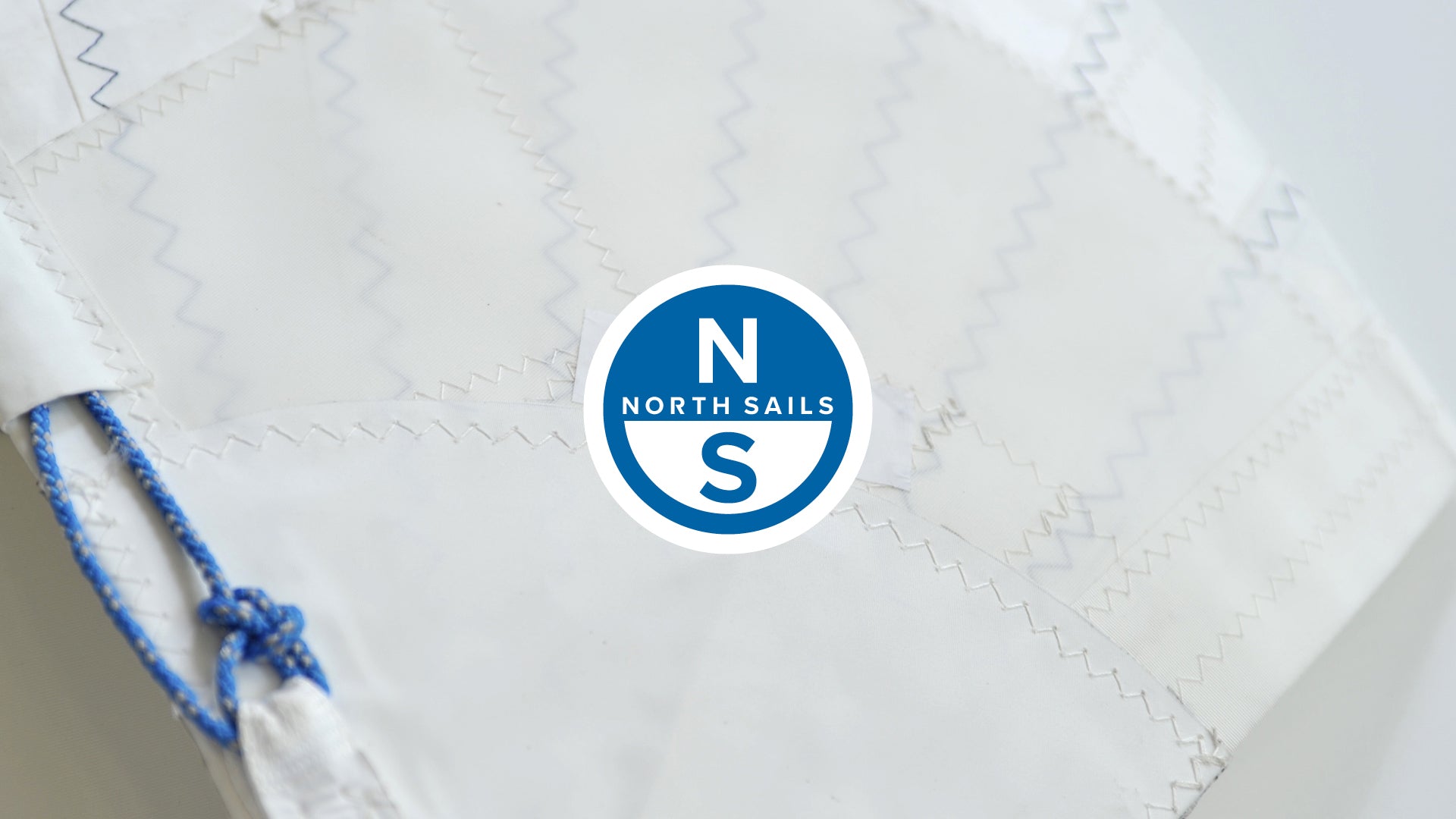
OK DINGHY TUNING GUIDE
North Sails expert Charlie Cumbley provides a detailed run-through on how to get the most out of your OK Dinghy sail. This guide will help to get your mast set up correctly for a North sail, looking at mast rake and mast position at deck level. For each of the settings, there will be a suggested range to suit different conditions, sailing fitness levels, and styles. Please use this as a guide; it’s not gospel as everyone will have a slightly different idea on how the boat should feel. By measuring these positions and getting within these ranges, you will be able to be competitive and also accurately reproduce your settings. As we learn more about the OK Dinghy or any other One Design class, new information regarding setup, tuning, and trimming techniques will be updated on the class page.
MAST POSITION AT DECK
The position of the mast at deck level will have a major bearing on how much rudder angle or weather helm your setup will produce. For any given mast rake, you can move the mast forward or aft in the boat by moving both the mast heel and deck adjusters the same amount. By moving the mast forward, you move the center of effort of the sail plan forward which will reduce the amount of rudder angle and feel. Likewise, moving it back will increase that rudder angle and feel. This position will vary depending on the boat type, foil shapes, sail shape, and conditions you are sailing in. As a rule of thumb, if you generally sail on flat water and/or light airs, you will want to move the sail plan back in the boat as this increases helm and will help you achieve a ‘high mode’ when sailing upwind. Conversely, if you are sailing in choppy/rough conditions and/or stronger winds, then you will prefer to reduce the amount of helm and rudder angle to allow for a faster lower mode upwind. As a result of this, the deck position often varies from boat to boat and depends on a sailor's preferred way of sailing. For an Ovington with a North Sail, Charlie's all-purpose measurement is 3270mm. Move the rig back 15mm to 3255mm for a flat water/light airs venue.
We recommend you measure this deck position as shown in the pictures below; measured from the aft edge of the deck ring to the aft edge of the transom.
MAST RAKE
The most traditional way to set up mast rake is to simply hoist a tape measure up on the main halyard to the top band. To make sure you are as accurate as possible each time, once hoisted, measure down the mast to the top edge of the bottom band by the gooseneck. The tape should read 5400mm. Use the tape to measure to the top of the transom - the most popular range varies from 6100mm to 6200mm. This range depends on wind conditions, sea state, and mast stiffness. In theory, you would be looking for a more upright mast in ‘max power’ conditions and flatter water, but this will depend on your own body weight and hiking fitness. In the lighter airs, you would generally opt for a more raked aft setting to reduce leech tension and increase weather helm. We would advise a setting in the middle of these for the windy setting. Once you get overpowered from your max power setting, dropping the mast rake back a little will help the sail twist open and depower as well as allow for a faster, lower upwind mode which will be needed in these windier/rougher conditions. The downside with measuring the mast rake in this manner is it does not allow for the variation in mast bend, in particular the fore/aft tip deflection. For example, if you have a mast with an f/a tip deflection of 480mm (measured in the normal manner with 10kg) and you set up the mast rake with a measurement of 6150mm, for any given upwind sheeting position (i.e with the boom end ‘1 booms depth’ from the deck), you will have more leech tension than if you were using a mast with an f/a tip deflection of 540mm. It's this leech tension that is a critical factor for your upwind performance, so we recommend an alternative method for measuring mast rake which is used extensively in the Finn class. This method is shown below.
HOW TO MEASURE LEECH TENSION
Rather than measuring your mast in a straight line ‘tip of mast to transom’ as described earlier in the guide, this system measures what tension would be put through the leech of the sail. This allows you to get more accurate settings and go afloat with a good idea of how open your leech will fly (leech twist). It will also allow you to interchange different masts and set the leech profile to the same setting no matter how different your masts may be. You can use any of the different spring/digital gauges currently on the market; Persola Spring Balance, Devoti digital strain gauge both work perfectly well. We have used the Persola spring balance in this guide.
1 - Attach tension gauge and long tape measure to mainsail halyard. Hoist halyard until the tape measures 5400mm when pulled taught down the mast to the top edge of the bottom mast band. Pull some tension onto the gauge at this point and remeasure this hoist once the halyard has bed in.
2 - Attach tension gauge onto the outhaul.
3 - Tie the traveler out to the side deck, the furthest it can be from the centreline (so the boom is positioned on the edge of the gunwale when pulled to the deck in stage 4).
4 - With the mainsheet, sheet the boom to the deck (NOTE: Always use the same side of the boat for measuring tensions. Always measure with boom end on side of the boat).
5 - Take measuring tape and measure to the inner edge of the boom black band. Adjust the outhaul so that the tape reads 5425mm when held taught.
6 - Read the numbers on the gauge to see what the mast is set up at - this is your leech tension.
Quick Tuning Table
Helm Weight
<6 knots - Superlight
5-10 knots - Light/Medium
All Purpose
>18 knots - Strong
>95kg
75lbs/34kg
79lbs/35.8kg
84lbs/38kg
82lbs/37.2kg
85-95kg
72lb/32.6kg
76lbs/34.5kg
82lbs/37.2kg
80lbs/36.3kg
75-85kg
72lb/32.6kg
75lbs/34kg
80lbs/36.3kg
77lbs/34.9kg
To adjust the tension, you can either move the chocks at deck level or move the foot of the mast (approximately 1mm chock at deck is equal to 1lb/0.5kg leech tension). Always re-check the tension after changes. This system also helps when trialing mast position fore/aft in the boat to maintain consistent leech tension. This guide will help maximize the performance of your North sail. If you have any queries, visit the OK Dinghy class page to contact any of the class experts. Check out the videos below for a detailed tuning run-through with Charlie. Happy sailing!
READ MORE
READ MORE
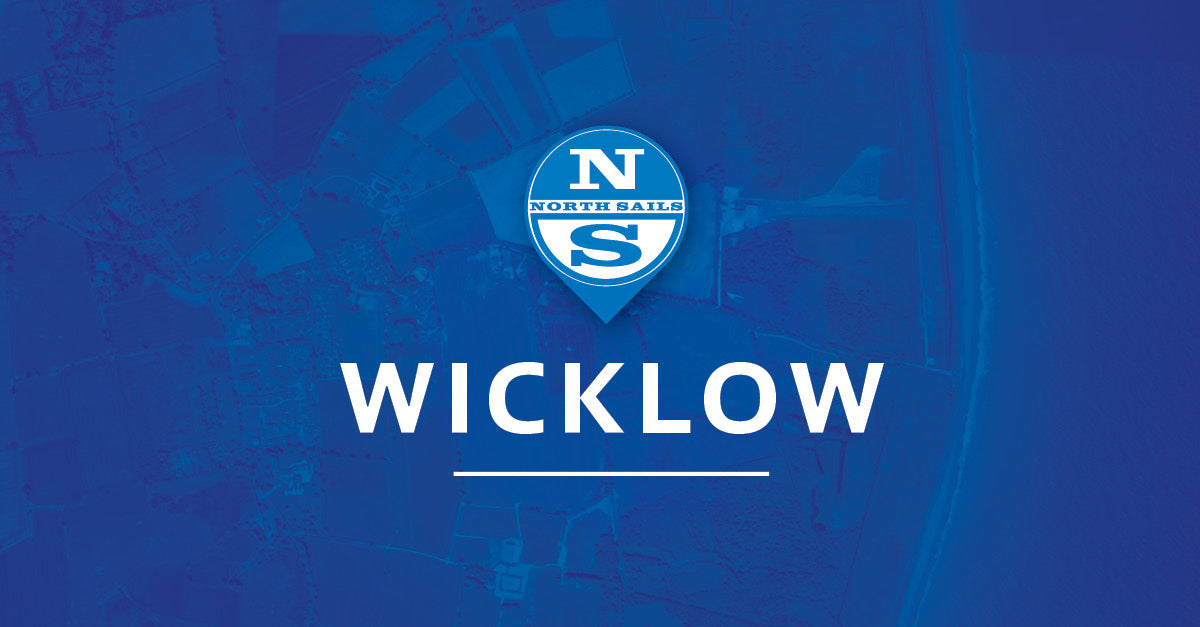
NEW NORTH SAILS SERVICE LOFT: WICKLOW, IRELAND
NEW NORTH SAILS SERVICE LOFT: WICKLOW, IRELAND
Open Now For All Your Sail Care Needs
We are delighted to announce the opening of our new Certified Service location in County Wicklow, Ireland. Only 30km from Dun Laoghaire, this new operation will be run by Shane Hughes who has been a long-standing part of North Sails since 1999 and part of the team in Ireland since the start of 2017.
Having previously managed the service floor for North Sails UK in Gosport, Hughes is no stranger to the world of sail service. He was born in Dublin and began his racing career at the age of nine at Howth Yacht Club. He went on to compete nationally and internationally in Mirrors and 420's and began racing keelboats at the age of 15. As a very experienced sailor, racer, and fully-trained sailmaker, you can rest assured your sails are in very safe hands at North Sails Wicklow.
“Shane is a highly respected and well liked sailor who brings an unrivaled level of expertise as a racer.”
From the 1st of July, the loft is open for business, and with a selection of sails already waiting to be serviced, the new loft will be busy from the start. We are ready to look after every sailor as we return to racing over the next few weeks.
As exciting as this new venture is, we must recognise the great service work carried out by Richard Marshall and his team at Marshall Marine Textiles for the past 17 years. Richard is now diversifying his business and as of the 1st July 2020, he will no longer repair sails. His cover and marine upholstery business is still operating at full speed, but he is officially hanging up his sailmaking scissors!
North Sails Ireland founder, Nigel Young, comments on how they came to work together for 17 years: "I met Richard back in the winter of 2003 on the steps of his workshop in Cobh. After a 20-minute conversation, we agreed on how we might work together, with Richard looking after the sail service and me helping him adapt to the North Sails blue book standard of working. I don't think either of us ever imagined that that conversation would be the foundations of a 17-year working relationship. We have some great memories of late-night service work together in all corners of Ireland!''
Richard comments: "I would like to take this opportunity to thank all the customers that used our sail repair services over the years. A special thanks to Nigel and the guys from North Sails Ireland for a great 17 years! I would like to wish Shane the very best of luck with his new venture; I know him well and he's the perfect man to pick up the baton and run with it. Good luck with the next 17!''
For all of your sail service needs from anywhere in Ireland, please contact Shane directly on 0838103539 or shane.hughes@northsails.com and he will take care of you.
READ MORE
READ MORE
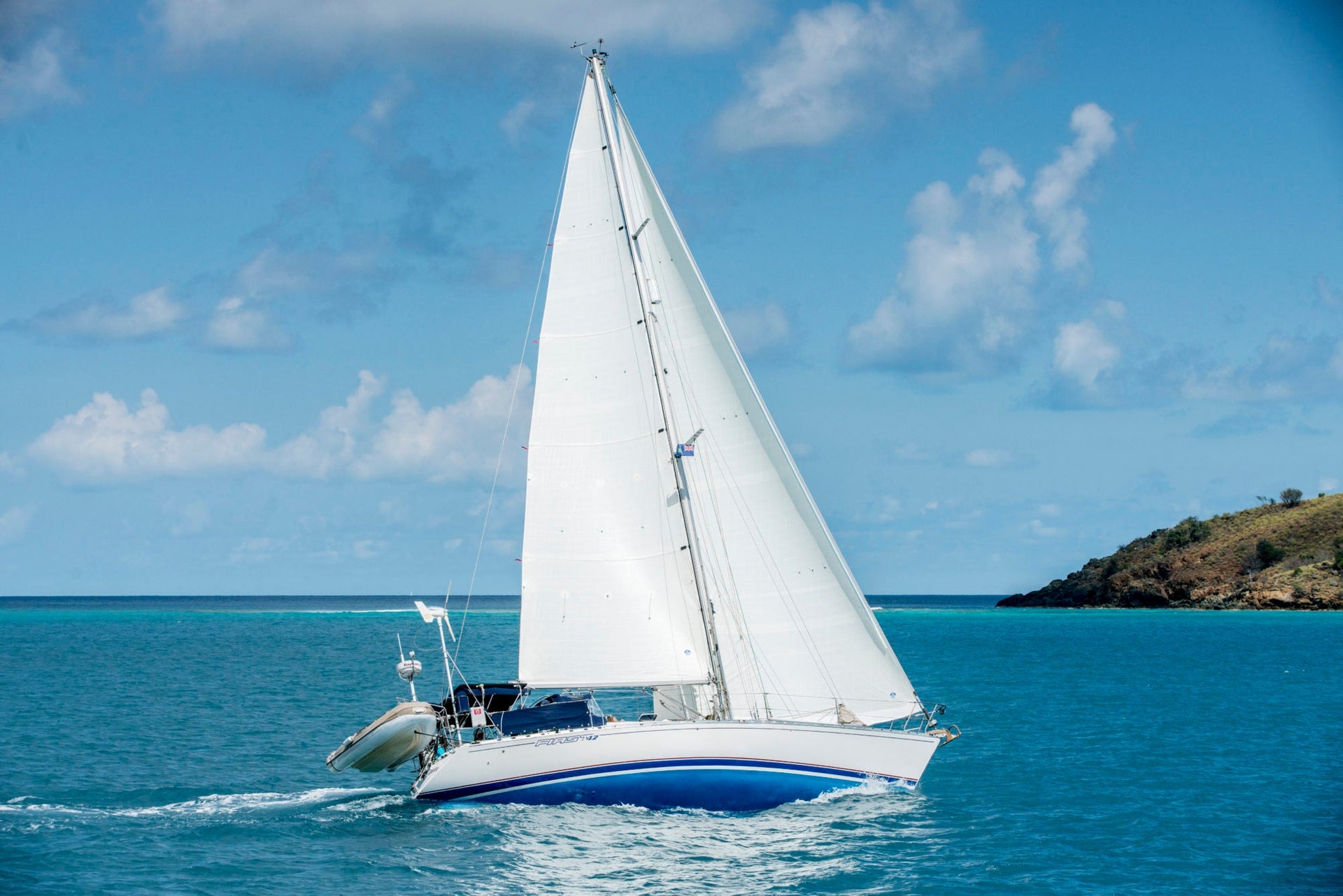
ALLT DU VILL VETA OM NYA 3Di OCEAN
ALLT DU VILL VETA OM NYA 3Di OCEAN
Ta reda på mer om nya 3Di Ocean-serien med hjälp av vår Q&A Q: Vad är 3Di Ocean?
A: 3Di OCEAN är den senaste produktlinjen av 3Di-segel från North Sails, designade och byggda specifikt för cruisingsegling.
Q: Passar 3Di OCEAN min båt och min typ av segling?
A: 3Di OCEAN är helt rätt för dig om du är ute efter cruisingsegel av högsta kvalitet, med fantastisk styrka och hållbarhet – och med alla 3Di-teknologins fördelar.
Q: Vad är fördelarna med 3Di-segel?
A: 3Di är en segelteknologi som bara North Sails har tillgång till, och som resulterar i formgjutna kompositsegel helt utan film. Strukturen skapas genom att tejper bestående av tunna fibertrådar impregnerade med ett särskilt härdlim läggs ut i olika riktningar och i olika densiteter på en 3D-form. Strukturen härdar med hjälp av värme och slutresultatet blir ett extremt starkt och slätt segel med exakt den form som designern specificerat. https://youtu.be/OCFEYvqXDus
Q: Vad är skillnaden mellan 3Di OCEAN och de andra 3Di-produkterna?
A: 3Di OCEAN är optimerade för cruising och har huvudfokus på hållbarhet och livlängd, medan 3Di RAW-segel är utvecklade för maximal stumhet och minimal vikt. 3Di ENDURANCE-segel är lämpliga för både cruising och racing – med en bra balans mellan prestanda och hållbarhet
Q: Vilket 3Di OCEAN-segel är det rätta för mig?
A: 3Di OCEAN finns i tre olika varianter:
OCEAN 330 är baserad på 100 % NORDAC Polyester-fibrer och passar cruisingbåtar mellan cirka 25 och 45 fot.
OCEAN 370 bygger på en blandning av Ultra PE- och 3Di NORDAC-fibrer och är utvecklad för båtar över 45 fot. Den är särskilt lämplig för exempelvis cruisingkatamaraner som ställer extra höga krav på styrka och formstabilitet.
OCEAN 700 är till för båtar över cirka 60 fot och byggs i en mix av UltraPE och aramid.
Q: Hur länge har North Sails gjort 3Di-segel för cruising?
A: 3Di-teknologin har funnits på marknaden i mer än ett decennium och har använts av tusentals båtar som har tillryggalagt totalt miljontals sjömil. Så 3Di är en minst sagt beprövad teknologi.
Q: Vilka är de specifika fördelarna med 3Di OCEAN-segel?
A: En stor fördel är deras enastående hållbarhet. 3Di NORDAC Polyester- och UltraPE-fibrer har bättre motståndskraft mot UV-ljus, fladder och nötning än andra typer av fibrer som används i kryssegel. Den speciella kompositkonstruktionen innehåller ingen mylar, vilket gör att ett 3Di-segel inte kan delaminera, något som annars är vanligt på laminat- och membransegel. 3Di OCEAN har även ett yttre fiberlager som skyddar mot skav och nötning, vilket gör det särskilt lämpligt för exempelvis rullstorsegel.
Q: Är 3Di Ocean-segel bra för kappsegling?
A: Inte lika bra som ett ENDURANCE- eller RAW-segel! OCEAN är ju inte utvecklat för racing. Visst, för kappsegling på lokal nivå kommer det oftast fungera jättebra, men om du är ute efter ett segel för både cruising och seriös kappsegling bör du ta en titt på ENDURANCE. Eller RAW, förstås, som ju är utvecklat specifikt för kappsegling på högsta nivå.
Q: Hur är det med andra material? Tillverkar North Sails fortfarande crosscut-segel för cruising?
A: Absolut. Om du är intresserad av panelsegel har vi flera alternativ. Våra NPC Cross-Cut-segel är tillverkade av traditionell vävd polyester, och NPL Tour är baserade på våra egna högkvalitativa laminatdukar. Och det här innebär att vi kan ge dig precis det cruisingsegel som passar dig bäst – oavsett hur dina behov ser ut.
Explore Materials Find a Loft Request a Quote
READ MORE
READ MORE
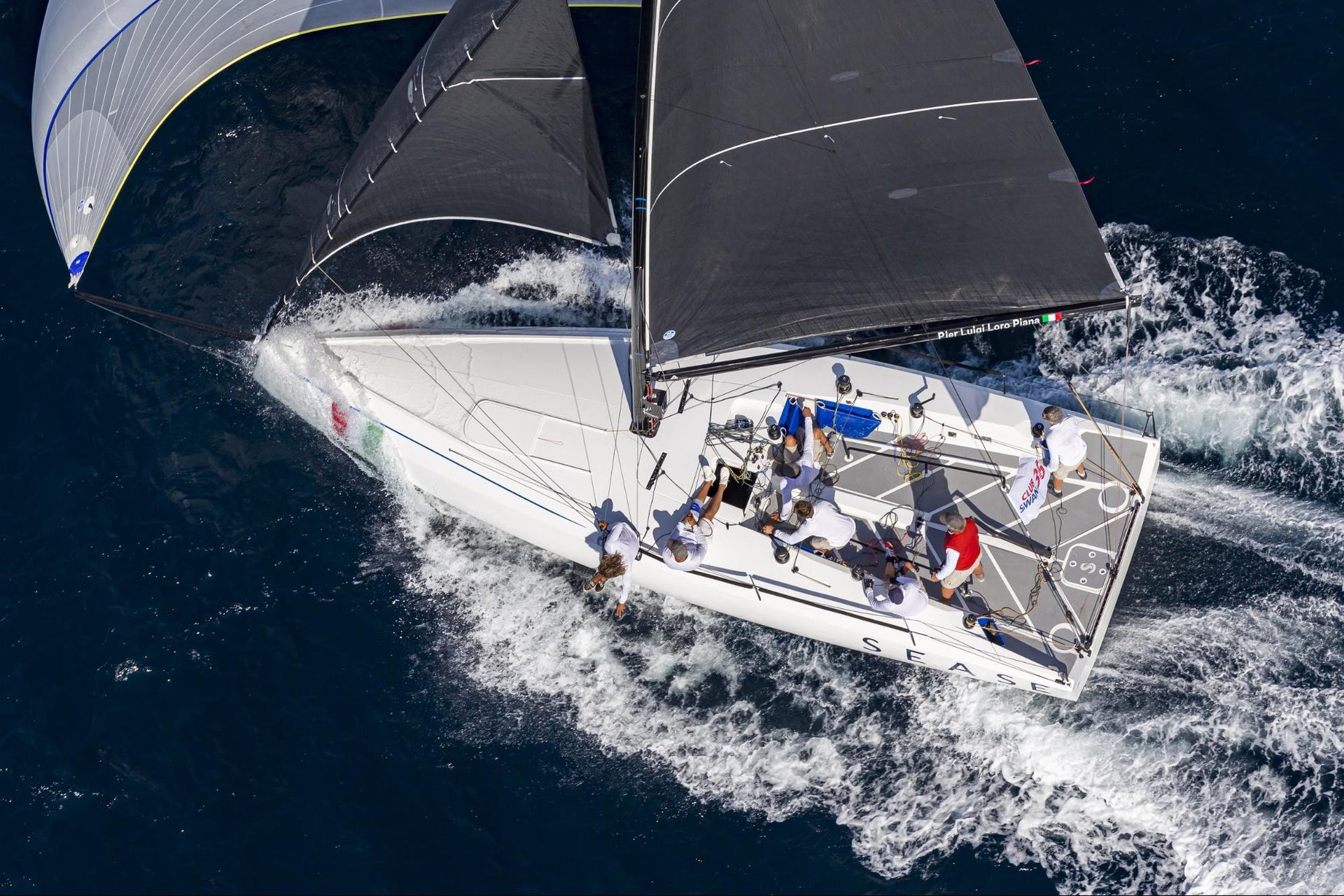
CLUBSWAN 36 COLLABORATION
THE NEVER-ENDING QUEST TO DESIGN THE BEST SAILS
Sail Testing & Sea Trials Onboard ClubSwan 36 Sease
📸 Stefano Gattini / The Nations Trophy 2019 / Sease / Loro Piana Family
The ClubSwan 36, which made its debut in May 2019, is seeing significant signs of growth. Despite a delay in sailing in 2020, the North Sails team has spent the first half of this year working on optimizing sail design and rig configurations for this innovative, high-performance one design class.
The Loro Piana family recently launched their new ClubSwan 36, Sease, and a team of North experts, made up of sail designers Giovanni Cassinari and Michele Malandra, ClubSwan 36 class expert Stefano Orlandi and North one design specialist, and Sease mainsail trimmer Giulio Desiderato, were on hand in Portofino, Italy to put the boat through two days of sea trials. “Being part of this project to see it progress has been exciting,” explains Desiderato. “The Loro Pianas are one of the most passionate sailing families in Italy. Our sea trials with Sease brought different conditions, allowing us to record valuable results, and having the family host and join us on the water was the cherry on top.”
📸 North Sails / Sea Trials June 2020 / Sease
When it all started
North Sails began collaboration on the ClubSwan 36 when the class was still a concept. Using data-driven design to build the initial sail inventory, the North designers began the process of tweaking sail designs and fine-tuning sail shape to create the best experience for clients in the ClubSwan 36 class as soon as the first hulls hit the water.
“The ClubSwan 36 is an innovative one design that’s great for mixed class racing,” explains Desiderato. “The original sail design was a good starting point for us,” comments Desiderato. “Since the first boat was built and the first suit of sails were made, our North Sails team has focused entirely on evolving the sail inventory for maximum performance. “The ClubSwan project and collaboration between Nautor Swan and North Sails have come a long way. For us, this relationship has made it possible to provide the best products for the class and all competitors.”
📸 North Sails / Sea Trials June 2020 / Sease
A Winter of design work
As the 2019 season came to a close, lead class sail designer Cassinari, along with Malandra, went back into the design office with a baseline of understanding from the first season of sailing. The team loaded their data into the North Design Suite, and specifically the Membrain program to run the ClubSwan 36 simulations and refine the sail design.
By the (now-delayed) start of season two, North Sails had a sail inventory that included a main with a larger sail plan and a new lineup of downwind kites. As explained by Malandra, “using North Design Suite to test the entire sail package, including variables from sail testing, and the flying shapes, the simulations have shown validity, and our team is delighted with this result.”
📸 North Sails / Sea Trials June 2020 / Sease
Feedback from the water
From the design office to onboard, did the inventory updates deliver? “The new 3Di RAW sails are different from the first rendition, and the design has come a long way for the better over the last year, explains Desiderato who was onboard as main trimmer during sea trials. “With this new sail design and configuration, we are now ready to get on the water and procure the race results we’ve been striving for.”
What’s next?
With a bit less sailing time than originally planned, all eyes are on the Swan Cup, which will host the growing fleet in Porto Cervo in September. If all goes as planned, this event will be the first official ClubSwan 36 event of 2020, and the North Sails ClubSwan 36 experts and sail designers are excited to see all their hard work put to the test for what could be the biggest event of the year for the class.
“It’s important for us to keep working and making improvements,” explains North class leader Orlandi. “Between myself, Giovanni, Michele, Giulio, this project is in good hands. We are excited to be on the starting line at the next Swan Cup, where we’ll be greeted by ten additional boats, which is very exciting!”
📸 North Sails / Sea Trials June 2020 / Sease
READ MORE
READ MORE
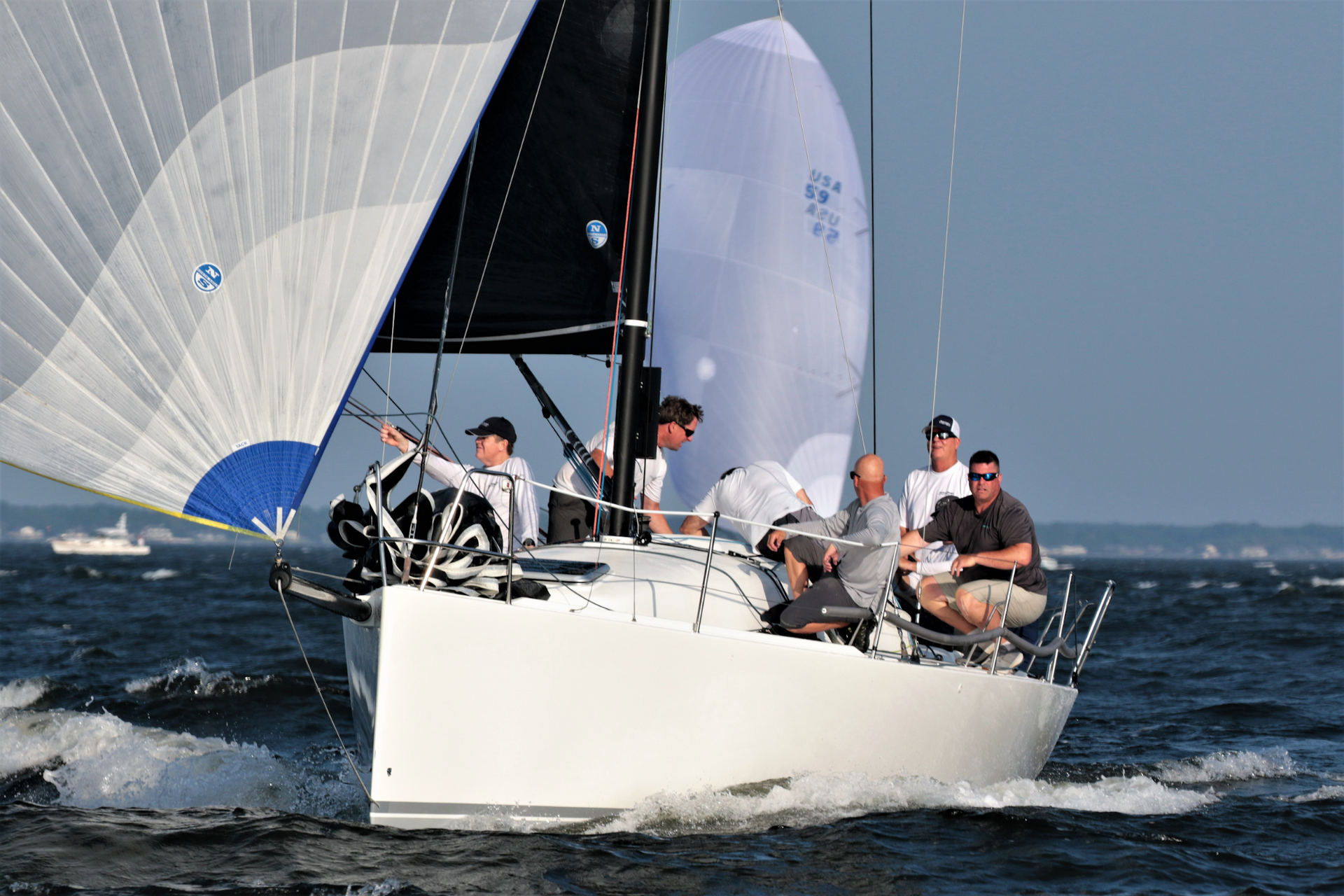
SAILING IS BACK IN ANNAPOLIS
SAILING IS BACK IN ANNAPOLIS
Getting Back Into The Groove
J111 Ramrod sailing downwind towards the finish CC: Will Keyworth
Weeknight sailing is back in swing in the Annapolis area with customer’s all boats taking to the water to safely enjoy sailing. With, SSA on Tuesday nights, AYC on Wednesday nights, J world on Thursday nights and EYC on Friday nights, there are options for any night of the week for the avid racer in Annapolis. Seeing customers on the water with their new sails is one of our favorite times of the year for us here at North Sails. This year it happened a bit later than usual, but the wait made it even sweeter.
Below are some amazing shots from Will Keyworth of some of the action:
Penn Alexander’s J80 crossing the finish line CC: Will Keyworth
North’s own Allan Terhune sailing with his wife Cate on their J70 CC: Will Keyworth
READ MORE
READ MORE
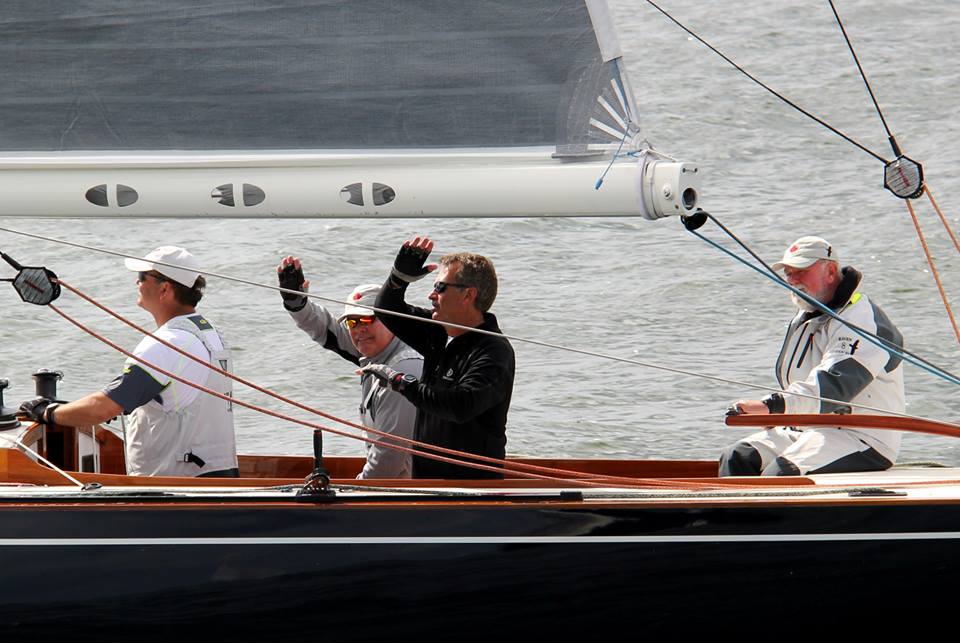
CELEBRATING 30 YEARS
CELEBRATING 30 YEARS
A Look At Hugh Beaton's Career With North Sails
Where to begin with a guy like Hugh. He’s a lifer in this industry, beginning his time like most during the summers at a local sail loft in Barrie. He learned the basics while on the service floor and consistently worked on the craft. Hugh learned to sail in Barrie ON, where he worked with Lasers, 470s, Int 14’s and small keelboats.
While attending University, Hugh learned to design and build spinnakers. He developed a passion for racing IOR throughout North America. Graduating from the University of Toronto, he soon joined a local sailmaker in Barrie, which sent him boat shows in Montreal and Toronto throughout the 80s. The stories are legendary and reveal the impact the industry can have on individuals even to this day.
Hugh joined North Sails 1990, and was privileged to work with some great people in the Toronto office including; Hans Fogh, Steve Calder, Bruno Dubois, and Larry MacDonald.
Early in his career he was introduced to the International 8 Metre Class, which quickly became his class of choice. Hugh quickly found himself working with 40 teams from 12 different countries. The boats are beautiful to sail, and highly technical making them an ideal platform for North Sails’ range of design services and 3D manufacturing. Hugh has attended 21 World Championships, winning nine titles along the way. He shares, “It has been very rewarding to work with so many great sailors , and to develop products and tuning guides for the class.”
Aside from the 8 metres, Hugh enjoys distance racing on the Great Lakes, and cruising with his family in the North Channel area of Lake Huron. He is also a big outdoor enthusiast who loves the snow, cross-country skiing and downhill skiing. When he’s not skiing, you can find him snowshoeing or working on his log cabin. His annual winter beard always signals the change of season for us in the loft.
His knowledge is vast and one can’t help but learn from him. If he doesn’t know the answer then he’ll do his best to find out for you. More importantly though, he’ll show you how he got the answer to help give you the tools to do it yourself, and thus help sailors/customers in the future. A trait that is hard to come by these days. His philosophy of empowering youth, encouraging them to get involved in the industry and sport as a whole is admirable. He tries his best to create opportunities for youth and females in sailing, empowering them with knowledge and support, and most importantly encouraging them to get out on the water.
His patience in teaching and mentoring new additions to the team is not only notable but also refreshing. It is something that is not seen a lot these days however it is something that is needed. It goes to show that if you invest in the individual, they will invest in you and the company. Fellow coworker and friend Bill Pearson echo's this sentiment saying, "While I have known Hugh at some level for over 20 years, it is only in the last 20 months that we have worked closely together, and it has been a pleasure for me. Besides being a great salesman and mentor in Toronto for a good while now, he has also clearly proven himself to be an excellent manager, with a good collaborative style of leading."
He is committed to helping the sport locally not because he works in the industry but because it’s the right thing to do; paying it forward to the next generation. A big supporter of weeknight racing and grassroots sailing, Hugh is always working behind the scenes to help drive more participants, encouraging more people to leave the dock.
The bigger picture and North Sails role are always at the forefront of Hugh’s mind. Always finding a way to ensure we’re doing the best we can to support local sailing, not just racing. It is similar to how he approaches a new sail order or service repair. What role does this sail play in the wider inventory of the customer? Is this the best option based on their needs? What is the goal in 5 years? All these questions asked for a customer looking at a new sail or repair, are similarly pondered when deciding how to support sailing locally. A common phrase you’ll hear from Hugh is, “it’s the right thing to do.” A phrase that guides the loft in our actions on a day to day basis.
Here’s the thing about Hugh. He is a good example of what happens when you take the time to invest in individuals that are new to the company and sport. Taking the time to show them how to measure boats/sails, giving them the tools + knowledge to talk to customers confidently and helping nurture their individuals strengths goes much further than most people realize. These individuals become invested in the industry, the craft and the company they work for; and they grow. The growth and skill development pays dividends, as we've seen many times at the Toronto loft. Beyond this, these individuals that Hugh helps mentor and guide are able to transfer those skills to other areas of their lives and businesses. Harmony, past team member at North Sails Toronto, shares her memories of working with Hugh and the impact he had on her.
"I had the pleasure of working with Hugh for roughly 5 years during a very important transitional time in my life. I wasn't sure which direction I was heading in my professional career, and logically took a breather to sail and work with some great people. Little did I realize at the time, however the experiences and friendships gained at North Sails have stayed near and dear to my heart for the past 10 years. I am extremely grateful that Hugh trusted in me, while giving me the opportunity to learn the intricate details of running a multifaceted business. What I was able to learn under the influence and direction of Hugh, has served me very well in my own expanding business. And much to my current employee's annoyance, I have carried many of these lessons with me and even a few of the North Sails SOPs! When it was time for me to leave as I had my first baby, Hugh and the North Sails team were like an extended family to me. Hugh made sure I left with a memorable departure package including my little piece of Canadian history, a beautiful Hudson's Bay blanket. I have remained in touch with Hugh for 10 years. And I know we will remain friends for another 10! Congratulations Hugh! You deserve an exceptional celebration!"
Another fellow team member Doug Folsetter shares his own memory of Hugh when he was beginning his career. Doug recalls, "He probably doesn’t remember but I first met Hugh around 1990 or 1991 when he came down to measure sails for a new International 14 build that I was part of. Although it was a small project, I recall Hugh spending a lot of time to get the details right. He spoke knowledgeably about Asymmetrical sails which were quite new to us. It’s likely that he hadn’t sold many by that time but he knew more than we did (or at least told us he did) and the sails were a big leap forward compared to the previous generation.
Fast forward to a few years ago when I was foisted upon North and Hugh as part of a merger. Since I joined North Hugh has been nothing but accommodating. As a natural teacher, he has no hesitation to spend time (especially if you catch him in the car when he’s stuck in traffic on the way home to Barrie) passing down his vast knowledge for the purpose of building a better sail for the customer. Since getting to know Hugh, both my taste in scotch and knowledge of chainsaws has increased dramatically. North is lucky to have him and I’m lucky to work with him. Congratulations on 30 years!"
Needless to say, we all have our own "Hugh" story that reflects his patience, knowledge and passion for sailing. From all of us at North Sails, Thank You!
READ MORE
READ MORE
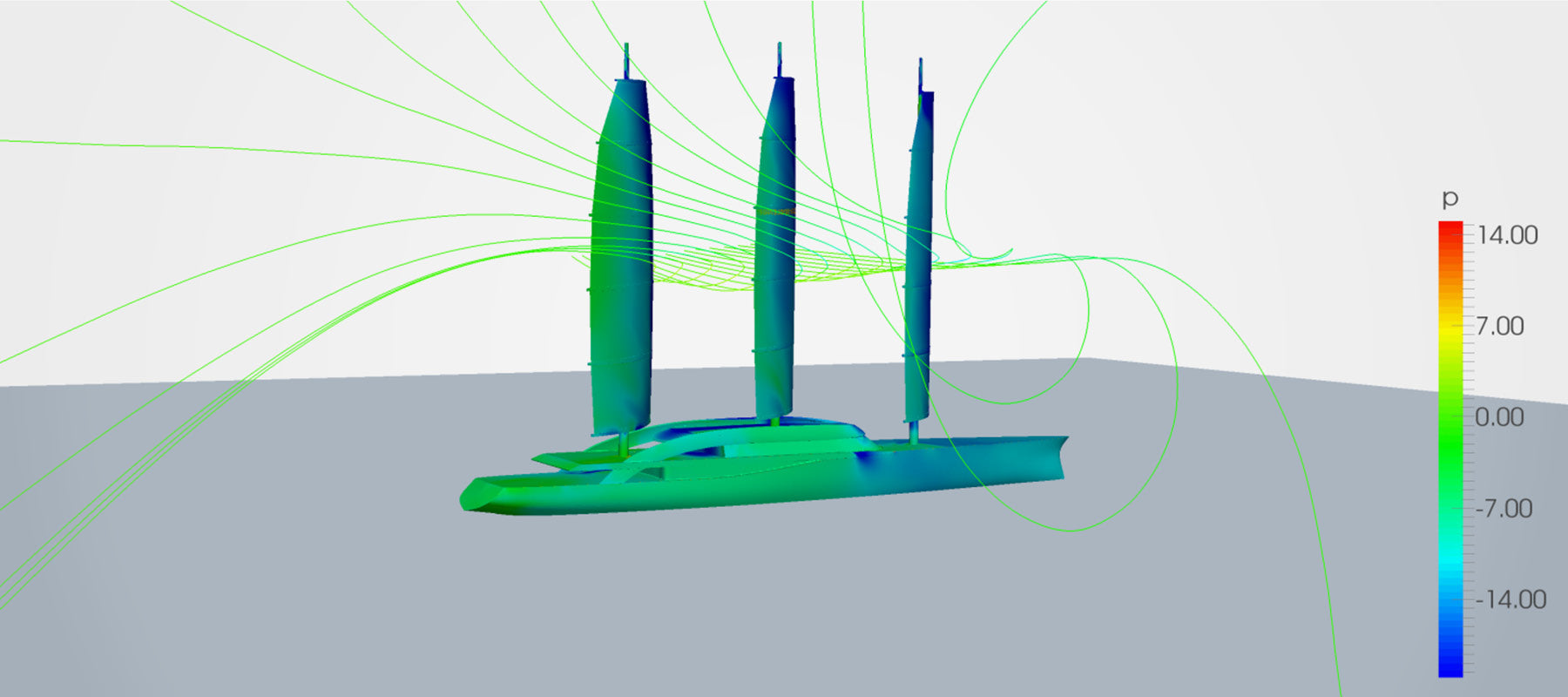
INTRODUCING DYNARIG BY SOUTHERN SPARS
SOUTHERN SPARS JOINS FORCES WITH MAGMA STRUCTURES ON DYNARIG
The World’s Leading Spar Maker to Manufacture Alternative Solution for Superyachts
📸 North Sails / North Design Suite / Membrain
Southern Spars, a North Technology Group company, is proud to announce they have joined forces with Magma Structures to deliver a new generation of DynaRigs. The DynaRig concept has proven itself as an effective alternative to conventional rigs for superyacht owners who are looking to reduce crew numbers and optimize sailing time. This is a new chapter for the innovative rig solution and aims at making the efficient, safe, and high-performance rig more accessible. To date, the DynaRig system has been installed on two superyachts, the Maltese Falcon and Black Pearl, with the team at Magma also behind the largest freestanding rig in the world on the Sailing Yacht A.
“Magma’s experience in designing, delivering, and maintaining DynaRigs combined with the NTG analysis, engineering, and manufacturing capabilities will enable Southern Spars to drive the continuous improvement of the concept.”
Damon Roberts Director Magma Structures comments; “We know the DynaRig concept is excellent for sailing superyachts, as proven by the first rig built for Tom Perkin’s Maltese Falcon. Magma Structures is delighted to have Southern Spars on board to further the technical and commercial development of the product. The recent success of Black Pearl has energized interest in the market and I am confident, Southern Spars, whose core business is mast-making will develop the next generation of DynaRigs.”
Sam Watson CEO of Southern Spars comments; “We are delighted to join forces with Magma Structures. Their unique experience in designing, delivering, and maintaining DynaRigs combined with the NTG analysis, engineering, and manufacturing capabilities will enable Southern Spars to drive the continuous improvement of the DynaRig concept. None of this would have been possible without the innovative spirit of Magma Structures, led by Damon, and naval architect Gerry Dykstra. The entire Southern Spars group is honored to be working with the Magma team to offer an additional solution to meet the unique needs of the largest yachts in the world.”
As the industry leader, Southern Spars has an unrivaled reputation and track record for delivering conventional stayed rigs to the superyacht and Grand Prix markets. Harnessing simulation data from the powerful North Design Suite, Southern Spars is uniquely able to assess overall sailing performance for best-informed engineering decisions. The North Design Suite has now been expanded to include DynaRig yachts to the same level of detail and accuracy as all NTG projects. With enhanced design capability, the experience of Magma Structures, and the composite manufacturing expertise of Southern Spars, DynaRig by Southern Spars will now allow owners and yacht designers a new level of creative freedom for the next generation of sailing Superyachts.
Please visit southernspars.com for more information on Southern Spars.
📸 North Sails / North Design Suite / Virtual Wind Tunnel
About Southern Spars:
Southern Spars is a division of the North Technology Group, the world leader in sail-making technology. Southern Spars specializes in the design and construction of carbon fiber spars and components, rigging, and rig servicing. As the industry pioneer, Southern Spars built its first carbon spar in 1990. Since then the company has pursued a passion for delivering world-class superyacht and racing spars, carbon rigging, and service.
About Magma Structures:
Magma Structures is a global leader in composite technology, providing world-class structural engineering expertise and flexible manufacturing resources and processes to deliver high-performance solutions for unique and challenging requirements.
About DynaRig:
DynaRig is a safe, high-performance sailing system, delivering ease of handling, reliability, and efficiency, even when sailing at 18 knots. The DynaRig addresses key challenges from escalated loads and unprecedented scale, making it especially suitable for two and three-masted performance cruising yachts from 60m to 110m in length.
READ MORE
READ MORE
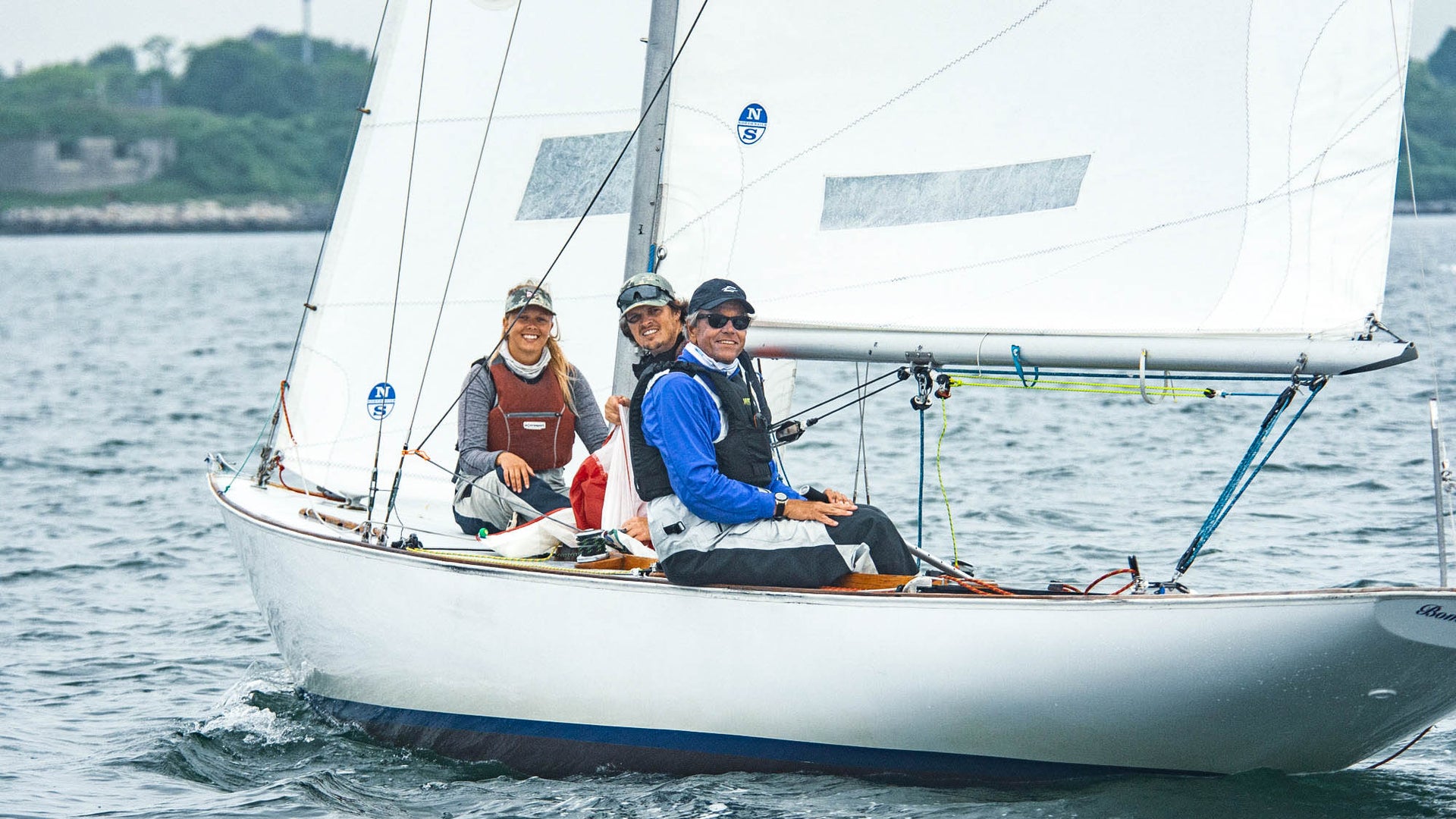
THE SUMMER OF SHIELDS
THE SUMMER OF SHIELDS
For the Toppa family, Coronavirus has a silver lining.
Story by Holley Toppa
It’s strange to think that the summer sailing of 2020 in Newport was kicked off with Wednesday night Shields racing. After the start on the first upwind leg, my dad, Mike Toppa is at the helm. Wednesday night Shields sailing happens every summer, but this first race felt like coming out of hibernation. I remember saying out loud, “wow, it’s the first race of the summer”. My dad Mike Toppa>, usually on the water as a North Sails Superyacht Expert, turned and looked at me with his big smile and replied, “isn’t it cool!”
It’s not quite the summer we imagined. With COVID-19 rewriting everyone’s schedules along with new rules and regulations, it was hard to imagine how sailing was going to operate. Normally, my dad would be going on another consecutive summer of commuting around the country and the world for anything superyacht related. As we know, many of the happenings around the world have either been canceled or pushed back to a later date. Amid all the unknowns, my dad still made sure to dedicate time to rigging and tuning the Shields, Bomba Charger, getting her race-ready for the summer despite not knowing if there would even be a race.
The author smiling on the bow of Bomba Charger between races in Newport Harbor
Luckily he, along with the other stir-crazy sailors stuck in quarantine, were able to work out a way for Wednesday night sailing to commence under the new guidelines; requiring masks on board, limiting the crew to 3, and calling for all to wear PFD’s as an added cherry on top. You could have told my dad that he would have to single-hand the Shields in a hazmat suit and a helmet and he still would have been out there for the first race.
That first Wednesday night was a bit surreal. It was unusual to not only see the harbor so empty after Memorial day but to have the bay completely to ourselves, not including the unusually high number of spectators for a small Shields race complete of just nine boats. The Shields fleet is one of the few fleets on the water in Newport so far and as a result, has definitely sparked some extra competition between the teams. Everyone was eager to not only break up to the stay-at-home monotony but to once again get back out on the water and show that they’ve still got it.
My dad made up his three-man team with myself and my boyfriend, Jeremy Wilmot. It is quite a special opportunity to be able to have the time of two working sailors for Wednesday night racing and watch them shake off the rust and get back to doing what they love. I had my place in the boat, doing mostly what they told me to do, but watching and listening to them talk about the nuances of the racecourse was such a great learning experience for me.
This time to spend sailing with my dad has been such an unexpected gift despite this pandemic. I would have been in Charleston working, not sure when I would be able to come up and visit. Now, I’m able to join my dad and share doing what he loves.
This coming Wednesday, we are able to add two more to the team, my sisters, Alie and Liza will be joining us, adding to the richness of this time my family has together, while also resembling a slow return to normalcy.
READ MORE
READ MORE

THE SUMMER OF SHIELDS
THE SUMMER OF SHIELDS
For the Toppa family, Coronavirus Has a Silver Lining
Story by Holley Toppa
It’s strange to think that the summer sailing of 2020 in Newport was kicked off with Wednesday night Shields racing. After the start on the first upwind leg, my dad, Mike Toppa is at the helm. Wednesday night Shields sailing happens every summer, but this first race felt like coming out of hibernation. I remember saying out loud, “wow, it’s the first race of the summer”. My dad Mike Toppa>, usually on the water as a North Sails Superyacht Expert, turned and looked at me with his big smile and replied, “isn’t it cool!”
It’s not quite the summer we imagined. With COVID-19 rewriting everyone’s schedules along with new rules and regulations, it was hard to imagine how sailing was going to operate. Normally, my dad would be going on another consecutive summer of commuting around the country and the world for anything superyacht related. As we know, many of the happenings around the world have either been canceled or pushed back to a later date. Amid all the unknowns, my dad still made sure to dedicate time to rigging and tuning the Shields, Bomba Charger, getting her race-ready for the summer despite not knowing if there would even be a race.
The author smiling on the bow of Bomba Charger between races in Newport Harbor
Luckily he, along with the other stir-crazy sailors stuck in quarantine, were able to work out a way for Wednesday night sailing to commence under the new guidelines; requiring masks on board, limiting the crew to 3, and calling for all to wear PFD’s as an added cherry on top. You could have told my dad that he would have to single-hand the Shields in a hazmat suit and a helmet and he still would have been out there for the first race.
That first Wednesday night was a bit surreal. It was unusual to not only see the harbor so empty after Memorial day but to have the bay completely to ourselves, not including the unusually high number of spectators for a small Shields race complete of just nine boats. The Shields fleet is one of the few fleets on the water in Newport so far and as a result, has definitely sparked some extra competition between the teams. Everyone was eager to not only break up to the stay-at-home monotony but to once again get back out on the water and show that they’ve still got it.
My dad made up his three-man team with myself and my boyfriend, Jeremy Wilmot. It is quite a special opportunity to be able to have the time of two working sailors for Wednesday night racing and watch them shake off the rust and get back to doing what they love. I had my place in the boat, doing mostly what they told me to do, but watching and listening to them talk about the nuances of the racecourse was such a great learning experience for me.
This time to spend sailing with my dad has been such an unexpected gift despite this pandemic. I would have been in Charleston working, not sure when I would be able to come up and visit. Now, I’m able to join my dad and share doing what he loves.
This coming Wednesday, we are able to add two more to the team, my sisters, Alie and Liza will be joining us, adding to the richness of this time my family has together, while also resembling a slow return to normalcy.
READ MORE
READ MORE
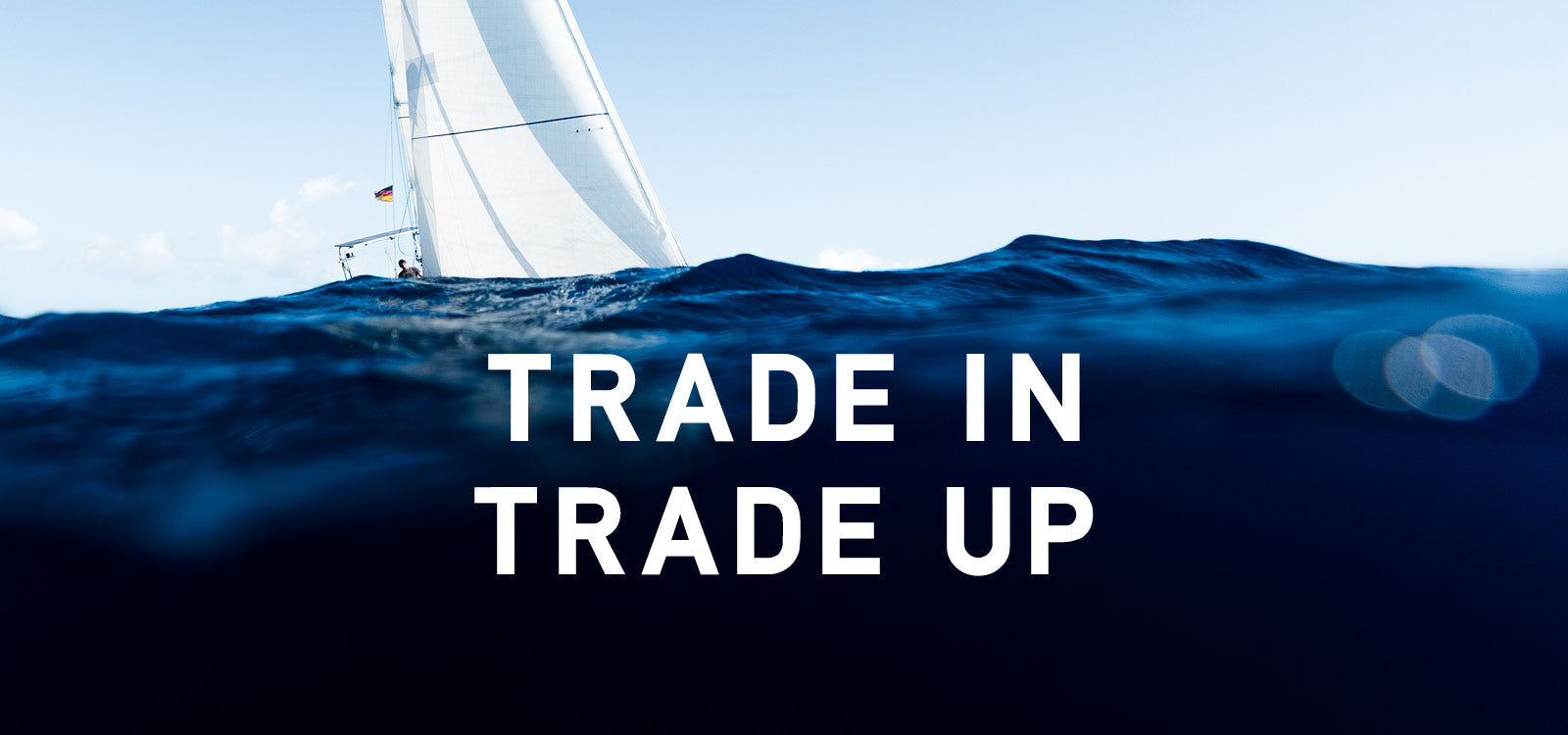
TRADE IN TRADE UP
Fini les vieilles voiles. Démarrez l'été avec une voile neuve.
Contactez-nous pour économiser
Il n'y a jamais eu de meilleur moment pour renouveler votre inventaire. Que vous fassiez de la régate, de la croisière ou un peu des deux, North Sails a les produits les mieux adaptés à vos besoins. Cette promotion permet d'obtenir jusqu'à 20 % de réduction sur une voile North Sails neuve, achetée au cours du mois de juillet 2020. Nous encourageons le recyclage de toutes les anciennes voiles utilisées. Lorsque vous commandez votre voile, il vous suffit de rendre votre ancienne voile à votre voilerie, ou de la donner à une institution de voile à but non lucratif.
*La promotion "Trade In Trade Up" 2020 s'applique aux voiles de près de moins de 22 mètres de guindant, et aux voiles de portant de moins de 27 mètres de guindant. La promotion exclut les voiles de la classe One Design International et Offshore One Design. La promotion expire à 23h59 le 31 juillet 2020. Toutes les voiles doivent être livrées avant le 20 décembre 2020.
Demandez un devis
Passez à l'action
Remplissez le formulaire ci-dessous et vous recevrez une réponse d'un expert de votre région. Tous les détails supplémentaires que vous pouvez nous fournir nous permettront de vous trouver la bonne voile, plus rapidement. Développez s'il vous plait les sections ci-dessous.
READ MORE
READ MORE

TRADE IN TRADE UP
Weg met het oude, Ga voor een nieuw North zeil
Neem contact met ons op om te besparen
Er is nooit een beter moment geweest om uw zeilgarderobe te vervangen dan nu. Of u nu wedstrijdzeilt, cruist, of een beetje van beiden, North Sails heeft de beste producten voor uw toepassing. Deze promotie biedt tot 20% korting op een North zeil dat aangeschaft wordt in de maanden juni en juli 2020. We moedigen aan dat alle oude zeilen gedoneerd of gerecycled worden. U kunt afspraken maken met uw lokale North Sails vestiging bij bestelling van uw nieuwe zeil over het doneren van uw oude zeil. Uw lokale North vestiging heeft een lijst van lokale organisaties die gebruikte zeilen hergebruiken.
*de 2020 Trade In Trade Up promotie is van toepassing voor aan de windse zeilen met een voorlijk tot 22 meter en voor de windse zeilen met een voorlijk tot 27 meter. De promotie is niet toepasbaar voor eenheidsklasse zeilen. De promotie eindigt op 31 juli 2020. Alle zeilen moeten geleverd worden voor 20 december 2020.
Vraag een offerte aan
Start uw Trade in
Vul onderstaand formulier in en een North zeil expert zal contact met u opnemen. Wanneer u extra informatie opgeeft over u specifieke toepassing, kunnen we u sneller helpen om het juiste zeil te vinden. Klik op onderstaande velden om deze informatie op te geven zodat u snel met de nieuwe zeilen het water op kunt.
READ MORE
READ MORE
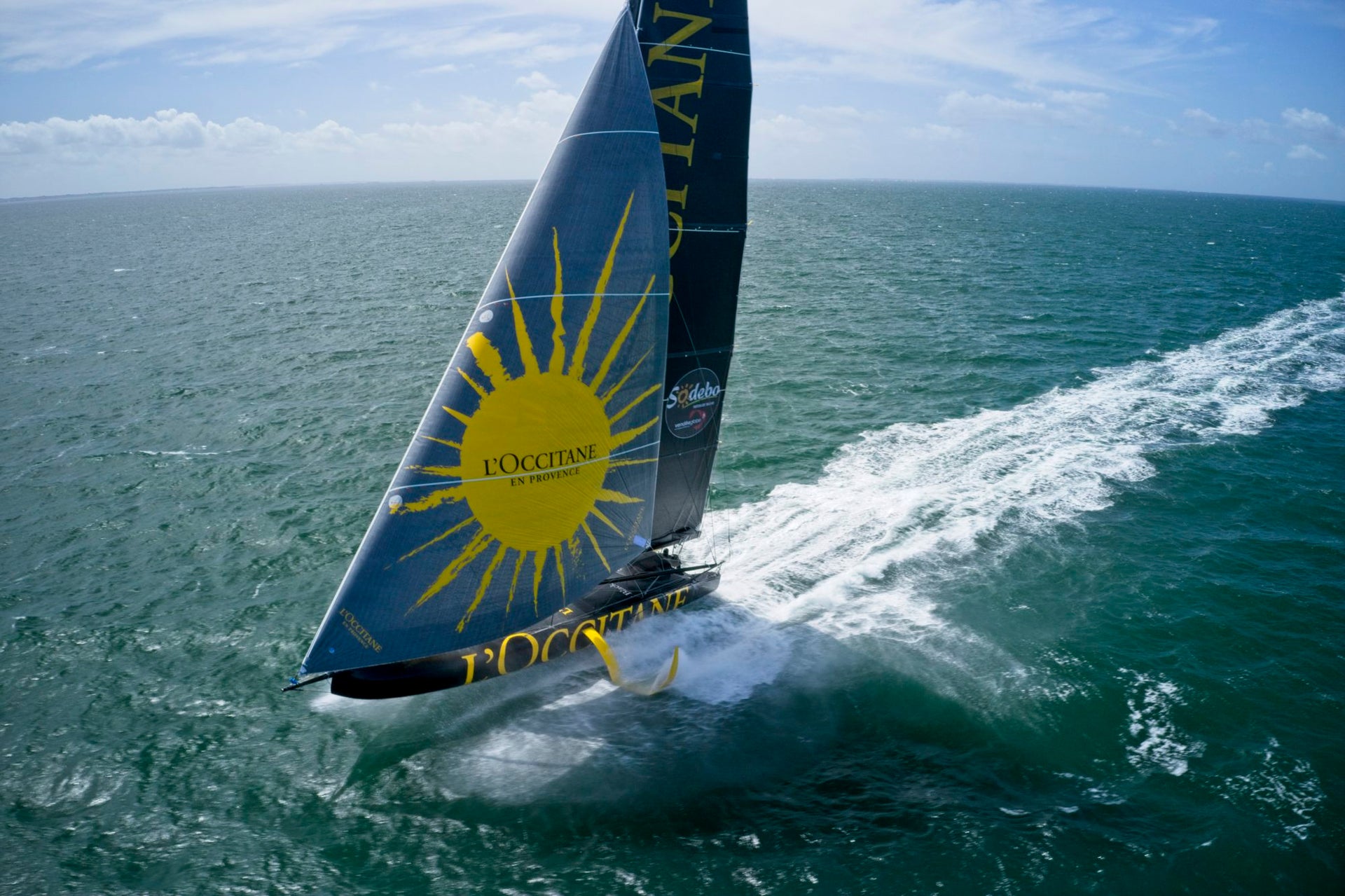
IMOCA L'OCCITANE EN PROVENCE STANDS OUT FROM THE FLEET
L’OCCITANE EN PROVENCE: AN IMOCA THAT STANDS OUT FROM THE FLEET
Innovation Proves Vital For the IMOCA Class
📸 Pierre Bouras – L’Occitane en Provence
L’Occitane en Provence, the first of its kind in many ways, proves innovation is vital for the IMOCA fleet. Skipper Armel Tripon and boat designer Sam Manuard give us their impressions on their new IMOCA L’Occitane en Provence from conception to the first sea trials.
Table of Contents:
Effective and Distinctive Design Downwind Performance Sail Design
From The Drawing to the First Sea Trials Mastering the Boat
Armel Tripon’s L’Occitane en Provence is one of the most recent boats in the latest generation IMOCA class. After two years of design and build, the yacht was launched last January in Nantes, France, the skipper’s hometown, but also the location of the Black Pepper Yachts shipyard where the foiling monohull, designed by the architect Sam Manuard, was built and equipped with a North Sails wardrobe.
“For me, it’s an incredible opportunity in my life as a sailor to be at the helm of this new boat,” says the 44-year-old skipper, Tripon. And what a boat! An IMOCA for a completely crazy race: the Vendée Globe.”
This will be the first solo around-the-world race for Armel Tripon, who won the Route du Rhum in 2018 in the Multi50 class. But it is also Sam Manuard’s first IMOCA Open 60 presented in the Vendée Globe and the first monohull in this class built by Black Pepper Yachts.
“This boat, which we wanted to be unique, has a genuine philosophy,” continues Armel Tripon. “It is a project that strongly reflects our aspirations. From the outset, our goal was to put together a new design team different in its way of thinking, which brings fresh ideas and is not afraid to think outside the box. This includes all the other partners: the shipyard and the sponsor who gave us the green light, convinced by the philosophy of our project.”
“This also represents a pivotal moment when the IMOCA class has opened up to the foil,” says the skipper. “We have entered a new era. It is magical to have taken part in this development, been an actor in these new IMOCA class rules, put the energy into designing this boat, and succeeded in getting everyone moving. It is a great success.”
📸 Pierre Bouras – L’Occitane en Provence
Efficient and Distinctive Design
This state-of-the-art yacht with a scow hull design stands out from the rest of the IMOCA fleet as it is the only one designed with this round and wide bow shape. Why such a choice? Sam Manuard, a naval architect but also a professional sailor — a double role that allows him to better understand the boat’s reactions — explains that the idea was to limit detrimental stressors to the performance of both the boat and the skipper. Scow hulls are more tolerant,” he explains. “It has been noticed that with this shape, when the yacht moves with the sea, i.e., downwind, the bow buries less. When the boat fills with water, it is a source of stress for the sailor and, therefore, a barrier to human performance. We’ve tried to target a virtuous spiral where all the small factors go in the same direction to reduce both mechanical stress and that of the skipper.”
Downwind Performance
The concept of L’Occitane en Provence was based on two primary principles: first, to build a boat that the skipper can use, i.e., efficient in terms of performance, and second, to get a boat which can be pushed hard downwind and broad-reaching, particularly in heavy seas.
Sam Manuard develops: “According to these two key parameters, we have oriented our technical choices, and this is reflected in the scow hull, a particular mass balance, the distribution of ballasts, the foils which exit well above the waterline, good protection which includes, among other things, a cockpit very far aft and a roof enabling forward vision, etc. All these elements that are put together meet our initial postulates.”
In this design phase, specifies the architect, “we had many open discussions about all the key points of the construction with Armel and all the players involved in this project, Michel de Franssu, the founder of the Black Pepper shipyard, the various design (boat and sails), structural and technical teams. We had a free approach to proposing ideas, so everyone gave their opinion openly. As far as the sails are concerned, the North Sails design team led by Gautier Sergent has been in the loop from the first meetings. Gautier Sergent is extremely knowledgable of sail configuration and gave us valuable input on the chainplate position and deck plan, among other things.”
“He’s a talented designer who always queries the sailor for feedback and input, adds Armel Tripon. “He is very open-minded and not shy to think outside the box. I appreciated working with North and being able to rely on a competent team with great knowledge. With North Sails designer, Julien Pilate, they were involved in the entire project, both in the structure of the boat and the sails.
“The aim was to create a fast, balanced, reliable boat, high performance but could also be handled by a single skipper for 70 days,” says Gautier Sergent, North Sails Head of R&D Department. “We freely imagined an ideal concept based on collective expertise. It was refined and adjusted, leaving aside any preconceived ideas over the months of the design period. And Armel trusted us.”
After this first phase of brainstorming, another fundamental aspect of this project was the computing power: the aerodynamic efficiency of the sails and hydrodynamic simulation, which fed into the VPP.
“In this study, a lot of calculations and simulations were carried out for which North Sails managed all the aerodynamics,” says Sam Manuard.
This includes the overall aerodynamic drag and the interaction between the platform and the sails. “It’s a key parameter on foilers which are going faster and faster, and it has a big impact on the boat’s stability,” explains Gautier Sergent.
📸 Pierre Bouras – L’Occitane en Provence
Sail design between stability and performance
However, IMOCA rules are restrictive. The challenge for the North Sails design team was to integrate specific constraints such as chainplate positions and rake while maintaining the balance of the boat by finding forgiving sail trims and configurations, etc.
As IMOCA boats do not have elevators on the rudders, the aim is to achieve the ideal ratio between the longitudinal position of the foil, the pitching moment of the sails, the shape of the hull, the boat state and other complex parameters.
“We’ve modeled various critical navigational cases which aim to define the maximum efforts that the sail plan will generate,” explains Julien Pilate. “This critical load information is then exchanged with the structural engineers, which enables them to correctly size not only the chainplates structure but also the structural elements of the hull. The use of the VPP is an essential tool for the sail designers, and in the development of a foil IMOCA, it allows us to determine the most efficient combination of sails in certain conditions, their surface area, and volume and therefore an ideal set of sails.”
“We’ll certainly be making some changes to some of the sails, but with minor modifications,” adds Sam Manuard. Downwind VMG sails have to be carefully considered. Should we choose a spinnaker or a gennaker, for example? The feedback from our training on the water will help us make up our minds. The selection limited to eight sails for the Vendée Globe will not necessarily be dictated by pure performance, but by a balanced set of compromises, depending on the number of maneuvers, for example. We must make decisions and then responsibility for them. The aim is for the boat to go fast without too much effort.”
From the Drawing to the First Sea Trials
From drawing plans and simulations to the first sessions on the water, Armel Tripon and his team are delighted.
“The first sailings have been positive,” comments Sam Manuard. As soon as the boat reaches its speed of stability, it sails exceptionally. The foils are working well; the sailboat in aerial mode is fast enough. It is almost thrilling. I was already lucky enough to sail on Jean-Pierre Dick’s IMOCA St Michell-Virbac where the sensations were superb, but with L’Occitane en Provence, you take it up a notch, the boat is airier, it’s another dimension.”
“I’ve spent hundreds of hours on the drawing board, thinking about many solutions for this yacht,” he continues. What interested me the most was to anticipate the boat’s dynamic reactions as well as possible. It is one thing to think and conceptualize and another to navigate. All in all, this is what we anticipated. The boat gets up; the movements are much smoother on the waves, we have gained in fluidity. It’s a great privilege and a chance to be able to design such a boat and be able to put our thoughts into practice on the water. »
Armel Tripon, who is very familiar with trimarans, observes that the sensations are similar to those of a multihull from 20 knots of speed, a real flying machine. Below this speed, the displacement takes over, and the boat’s behavior is like that of a typical keel monohull. However, maneuvers remain more physical on an IMOCA than on a multihull.
As for the deck and sail plans on L’Occitane en Provence, Armel observes that the ergonomics are well designed and fluidly executed. “The work was very rigorous on the sail adjustment, he says. It seems insignificant, but sometimes there can be small gaps. Here, the design twists naturally. It has met our expectations even beyond what I can see. We’re still in the detail phase, and it’s still too early to draw any real conclusions, but generally speaking, the sails’ design is very successful, even from the outside where we could see the sails from the zodiac boat and drone images as well.
📸 Pierre Bouras – L’Occitane en Provence
Next Objectives: Mastering the Boat and Qualifying for the Vendée Globe
The next few weeks will be intense and will be devoted to making the boat more reliable. Besides, Armel will aim at passing his qualification for the Vendée Globe during the Arctic-Vendée race, which will start on 4th July in Les Sables-d’Olonne in France. “My next steps will be to learn how to control my boat in the best possible way, acquire as much data and knowledge as possible and then qualify for the Vendée Globe,” says Armel.
Sam will stay by his side through this training phase. “My role from now on will be to accompany Armel in his preparation for the Vendée Globe, and I will often be on board to check the boat’s settings. I’ll connect with him, share my thoughts.”
“Sailing a lot will allow us to test the reliability and stability of the boat, the maneuvers, the performance of the sails, etc. The big challenge remains the analysis of performance (with a lot of data to be recorded) and reliability,” summarizes Sam.
“It will be a question of finding the right balance between navigation and reliability of the boat, knowledge, and performance,” adds Armel. At each training session, we’ll have a specific goal. For example, if we focus on the use of sail, we will target more specifically its shape and think about how we can further refine it.”
Sea trials will be scheduled over several days off the coast of Brittany. With the start of the Vendée Globe on 8th November approaching, Armel feels ready. “I had an excellent preparation when the boat was under construction. Now we are getting to the heart of the matter, it’s good timing!”
READ MORE
READ MORE

CELEBRATING OVER 35 YEARS
CELEBRATING OVER 35 YEARS
A Thank You To Our Service Managers
Both joining in 1985 as young ambitious gents, Domiciano (or Kid as he’s more well known) and Dennis have grown into their service managers roles with invaluable depths of skill and knowledge. Both have become staples in their local lofts and the go-to caregivers for sails; Kid runs the Toronto loft and Dennis heads up the Vancouver loft on the West coast.
For 35 years now these two individuals have been providing expert repairs, maintenance and advice to cruisers and racers alike. Their dedication to North Sails and more importantly, their clients, is something we all at North Sails would like to say Thank You for, as we know we couldn’t do it without them.
Kid joined North Sails when he was well, a kid. He began at North Sails Toronto in January 1985 in manufacturing. During his 35 years here, Kid has gone to Sri Lanka and all over the United States to teach people about sailmaking, manufacturing and repair techniques. He is the first one in the door in the morning and often the last to leave, never liking to leave a project unfinished. He is always committed to getting the job done, meeting customer deadlines and doing a good job.
Larry MacDonald recalls, "I remember clearly Domiciano arriving for his first day at North Sails, and being introduced to him by the production manager. Then like now, he looked less than his years, was small and knew very little English. What he lacked in experience or ability to communicate, he more than made up with his attitude and work effort. He was a fast learner, and within a few years, saw his career take off becoming assistant floor manager and never looking back. His youthful appearance earned him his nickname “Kid” which he has proudly accepted for now 35 years."
One of his favourite parts about sailmaking is that “Everyday is a new opportunity to learn something new. I know how sailmaking allows me to connect with customers in terms of their needs, whether it’s cruising or racing.” His skill and craftsmanship speaks for itself. We are proud and quite lucky to have him a part of our team. He is the engine that keeps our service team chugging along in Toronto.
Dennis is another gem that has bled blue for over 35 years now, joining the sailmaking world just after high school. Local sales expert Ross MacDonald shares "Dennis Lefeaux is one of North Sails most hard working, joke cracking, ever-creative employees - he's also may have the most 'experience', having started sail making just after high school back in 1979!"
Then and now, Dennis was known as one of the best sailors in the area. A reputation he earned through constant wins on the race course onboard his father's boat and all the assistance and tips he provided to all the other sailors.
Ross continues, "After beginning work at North in Dave Miller's loft in Vancouver, Den quickly picked up the skills for all sail repairs and in short order was able to build sails on his own. As one can imagine he's also very handy at canvas work and creating bags or custom pieces that look like they came from Milan! Some of the notable bits he's pulled off include Canada's largest flag, giant architectural canvas work used in BC Place stadium and working with the sail making team with Canada II during the 1987 America's Cup in Perth, Australia.
Today Dennis looks the same! And he's faster and more productive than ever. We are fortunate to have his knowledge, skills, wit, and try to follow his work ethic. Leading by example, he continues to inspire many of us.”
Vancouver loft manager Drew Mitchell is also a big fan of Dennis. He details how Dennis is the ultimate co-worker. "Since the first day I met him I have looked up to his knowledge and work ethic. He is the first into work everyday and during the busy season the last to leave. He is very humble. I remember the first day he was showing me the "fast route" from the loft to RVYC and he just casually mentioned he was a sailmaker with the Canada 87' Americas Cup Team. As any young sailor would, I then started to bombard him with questions about the team and regatta."
Drew tries to soak up as much as he can from Dennis as he is one of the best sailmakers he knows. Drew states, "he has probably gets tired answering 20 questions a day from me but I always want his advice when I am not sure about something. Dennis is known in the sailing community not only as "the best" sailmaker but as one of the best sailors in the PNW. I have been lucky enough to race on the same boat with him, and just like in the loft, I try to listen to what he has to say and figure out why he does certain things."
"After a very deep finish in a distance race I was speaking to a competitor who did very well and I asked him how we knew where to go. His response was "It was easy, I just asked Dennis on the dock before racing which way to go!" I now make sure to check in with Dennis before any race to get his opinion on what might work that day. I think the last time his response was "lead off the start and don't let anyone pass you." I have never heard someone say a bad thing about Dennis, I consider myself and the entire North Sails Team very lucky to have someone who has worked for North Sails as long as he has. I look forward to the many years we have left working together.
READ MORE
READ MORE
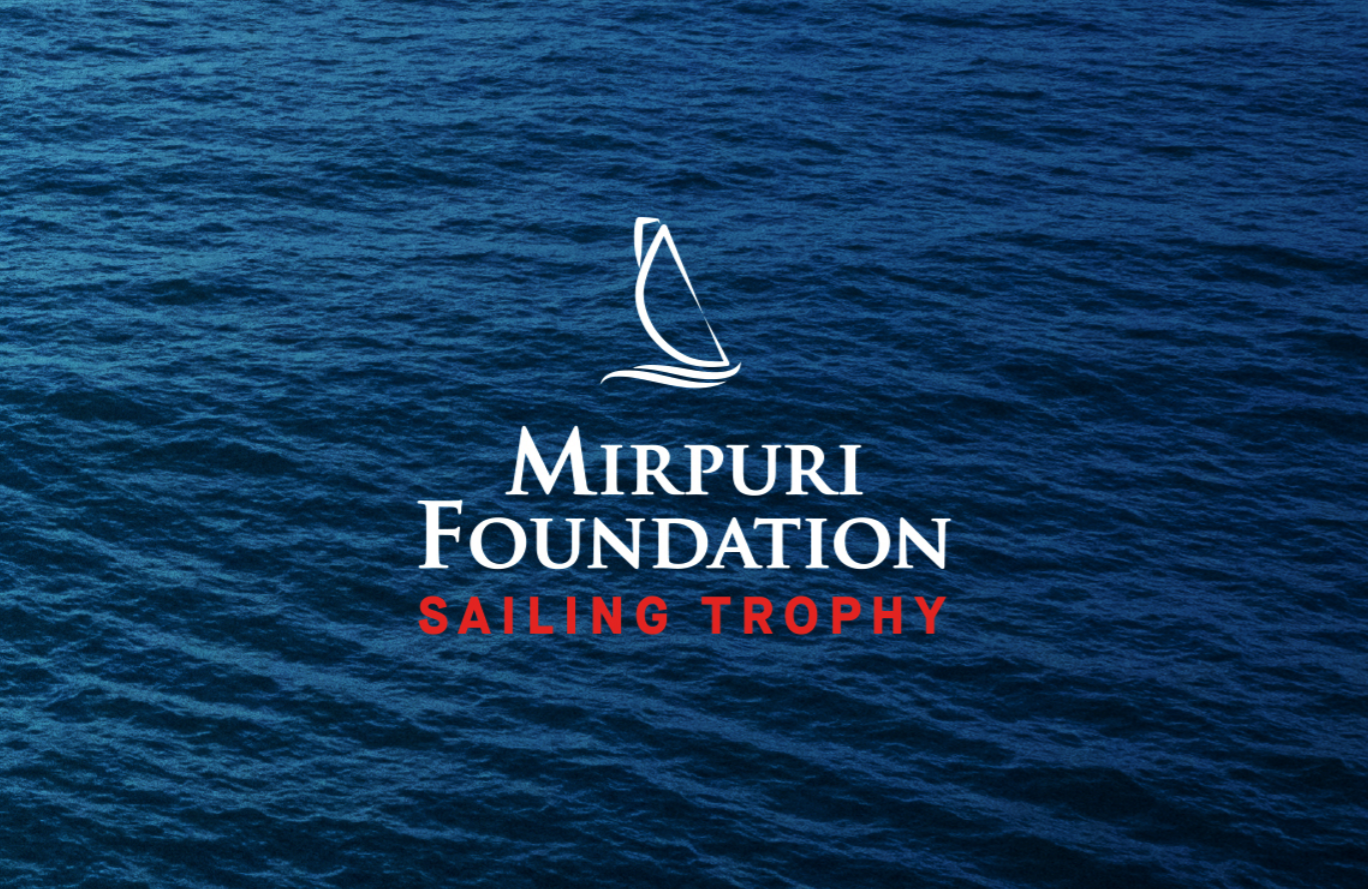
MIRPURI FOUNDATION SAILING TROPHY
MIRPURI FOUNDATION SAILING TROPHY INITIATES A SAFE AND SUSTAINABLE RACING PLATFORM
Promoting Public Safety, Environmental Awareness, and Great Racing
North Sails is excited to announce they are the official sail partner of the inaugural Mirpuri Foundation Sailing Trophy. The event will take place June 27-28, 2020 between Cascais and Sesimbra, Portugal. This new event will feature a cash prize pool of over €30,000, which includes a €16,000 prize for First Place. The overall winner will also be awarded the first-ever official Mirpuri Foundation Sailing Trophy.
“North Sails is honored to partner with Mirpuri Sailing Foundation and be named Official Sailmaker to their first Mirpuri Foundation Sailing Trophy,” commented North Sails President Ken Read. “A huge congratulations and thank you to the foundation who have found a way to help sailors go racing this summer. With the added bonus of all race registrations being donated to supporting ocean conservation, the Mirpuri Foundation Sailing Trophy is a great way to kick-off the sailing season. Good luck to all competitors, and we look forward to supporting you on the ground with overnight sail service and sharing your experience with North Sails followers around the globe.”
Mirpuri Foundation Sailing Trophy is a plastic-free sustainable regatta, and a charitable event, with team registration fees in this first edition to be donated to Marine Conservation programs. The Mirpuri Foundation maintains innovation by promoting the first health controlled race in the world, with a dedicated medical team ensuring all staff and sailors are in good health and free of Covid-19.
Ana Agostinho, Head of Public Relation commented on behalf of Mirpuri Foundation:
“The Mirpuri Foundation, as a well-established organization fighting for sustainability and for the future of our planet, choses its partners wisely, as they must share the same vision and the same goals. We are pleased to have North Sails joining the Mirpuri Foundation Sailing Trophy, the first international regatta after the start of the pandemic, the first world’s health-controlled race and one that will try to put the environment back on the global agenda. We sincerely hope, and look forward to counting on thsupport of North Sails many more editions.”
For those who are unfamiliar, The Mirpuri Foundation has a legacy in competitive sailing as a global platform to share important messages of marine conservation and encourage positive change to better impact the planet. “The Mirpuri Foundation Sailing Trophy aims to be one of the main sailing events in the world”, says Paulo Mirpuri, President of the Mirpuri Foundation, “Marine conservation is a key cornerstone of our activities at the Foundation and provides the inspiration for The Mirpuri Foundation Sailing Trophy. We believe in the power of sport to bring people together and raise awareness of the challenges our planet is facing. Sailing provides us with a direct link to the beautiful but fragile oceans that we all rely on so heavily.”
North Sails Cascais will onsite to provide overnight repair services, including pickup and delivery service for all sailors during the regatta. From departure is from Cascais (where the North Sails Cascais Loft is based) to Sesimbra (where teams will spend the night from Saturday to Sunday). Please contact the loft directly at +351 916 830 166 speak with our service team using the email address below or phone Vincente Pinheiro at: +351 916 857 896.
Email The Loft
Have questions about getting involved? Please send all inquiries to Mirpuri Foundation Sailing Trophy.
Register For Event Here
About the Mirpuri Foundation
The Mirpuri Foundation is a non-profit organization based in Portugal and founded by entrepreneur Paulo Mirpuri with the aim of contributing to a better world for future generations. With its belief that leading by example is the best way to change mindsets, the Mirpuri Foundation fosters cooperation between legislators, corporations, communities, and individuals.The Mirpuri Foundation acts in six distinct areas: Marine Conservation, Wildlife Conservation, the Performing Arts, Social Responsibility, Medical Education and Research, and Aeronautical Education and Research. The foundation’s commitment to sustainability is transversal and is reflected in all its activities. The Mirpuri Foundation is synonymous with technology, research, information, and innovation. Allied to these characteristics are the values of integrity, perseverance, and altruism in order to better impact the planet.
READ MORE
READ MORE
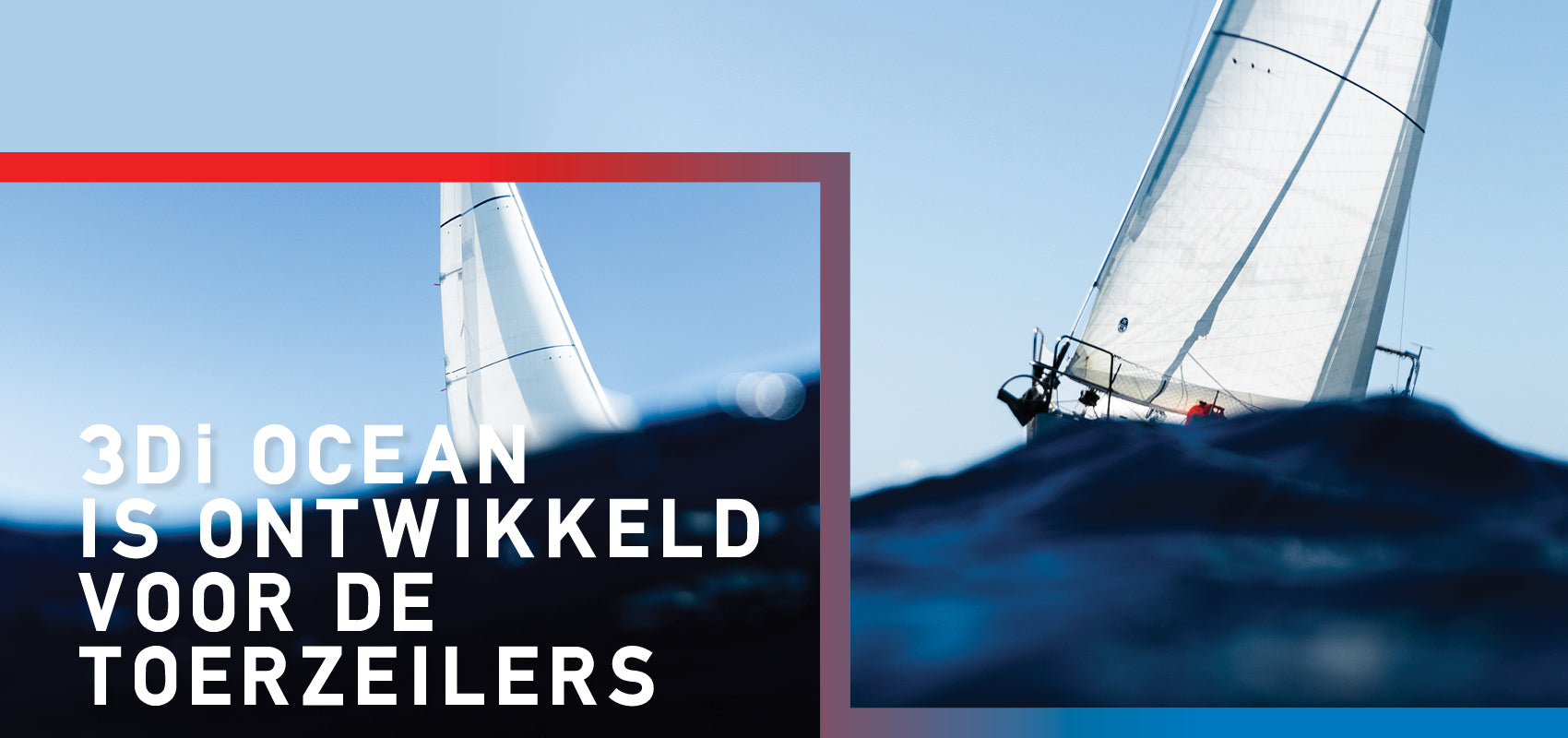
3Di OCEAN IS GEMAAKT VOOR UW VOLGENDE AVONTUUR
3Di OCEAN IS GEMAAKT VOOR UW VOLGENDE AVONTUUR
Een complete 3D productlijn voor boten van ieder formaat
Na uitvoerig testen en ontwikkelen is North Sails zeer enthousiast met de lancering van 3Di Ocean 370, ons nieuwste innovatieve zeil, waarmee onze cruise productlijn van 3D gemalde zeilen compleet is.
Dit nieuwe product bouwt voort op het succes van ons revolutionaire 3Di Nordac polyester voor kleinere boten en Ocean 700, het ultieme superjacht cruise zeil. 3Di Ocean 370 valt precies tussen deze twee categorieën om tegemoet te komen aan de unieke karakteristieken van boten tussen 35 en 60 voet. Norths 3Di zeilen worden vervaardigd met onze gepatenteerde technologie, waarbij zeilen geproduceerd worden op een driedimensionale mal. Van origine was deze technologie bedoeld voor wedstrijdzeilers, maar met 3Di Ocean is de technologie nu ook voor cruise zeilers.
Als marktleider is North Sails op zijn best wanneer onze energie en kennis gericht wordt op het compleet innoveren van een product segment. In 2017 heeft North Sails een revolutie teweeg gebracht met de her-uitvinding van het traditioneel geweven Dacron cruise zeil. Door robuuste Dacron 3Di tapes te verwerken op een driedimensionale mal introduceerde North de eerste echte innovatie voor cruise zeilers sinds Dacron in de jaren 50 katoen verving. Het prijswinnende 3Di Nordac werd al snel de benchmark voor cruise performance, met behoud van de traditionele Dacron look. In 2018 bracht North Sails het 3Di cruise concept naar de superjachten met 3Di Ocean 700. De toevoeging van 3Di Ocean 370 in 2020 is een bevestiging van de investering van het merk om cruise zeilers te ondersteunen met het leveren van de meest geavanceerde zeil technologie.
““Onze bedrijfscultuur wordt gedreven door een constant verlangen om zeil technologieën te ontwikkelen die de zeilervaring verbeteren van iedere zeilers”, aldus North Sails President Ken Read. ““Cruisen biedt een uitweg van het leven aan land, en de toewijding van North Sails aan dit segment is groter dan ooit. We hebben veel tijd gestoken in de ontwikkeling van een nieuw cruise product en zijn trots dit een jaar eerder te lanceren dan origineel gepland was. We kijken er erg naar uit om meer zeilers te laten genieten van een nieuw niveau in duurzaamheid en performance van cruise zeilen, door toepassing van 3Di. ”
Het gebruik van Norths innovatieve en gepatenteerde 3Di technologie en productie levert sterkere en gebruiksvriendelijkere zeilen. Deze technologie maakt het mogelijk de cruise performance te verbeteren door zeilen te produceren die minder helling geven bij meer wind en juist extra vermogen geven bij licht weer. 3Di Ocean zeilen zijn naadloos, ongeëvenaard sterk, mooi en zeer duurzaam. Dit geeft meer vertrouwen wanneer u gaat zeilen, alleen, met vrienden of met uw familie. Simpel gezegd, Deze zeilen verbeteren uw zeilervaring.
3Di Ocean zijn nu beschikbaar. Neem contact op met uw lokale North Sails team om meer te leren over deze producten en levering deze zomer.
Lees verder Vind een verkooppunt offerteaanvraag
READ MORE
READ MORE

NORTH SAILS BY APPOINTMENT
NORTH SAILS BY APPOINTMENT
Book a Complimentary Coaching Session
Calling all sailors on the Solent! Book a one-on-one, real-time coaching session with the North Sails experts who will join you by RIB and provide tips to help kick off your season.
Let us know below when you will be sailing and we will schedule a time to meet you on the water to offer instant coaching and feedback. Whether you are a racer, cruiser, or One Design sailor, any boat should take advantage of North’s summer coaching. Sign up to improve your game with us.
READ MORE
READ MORE
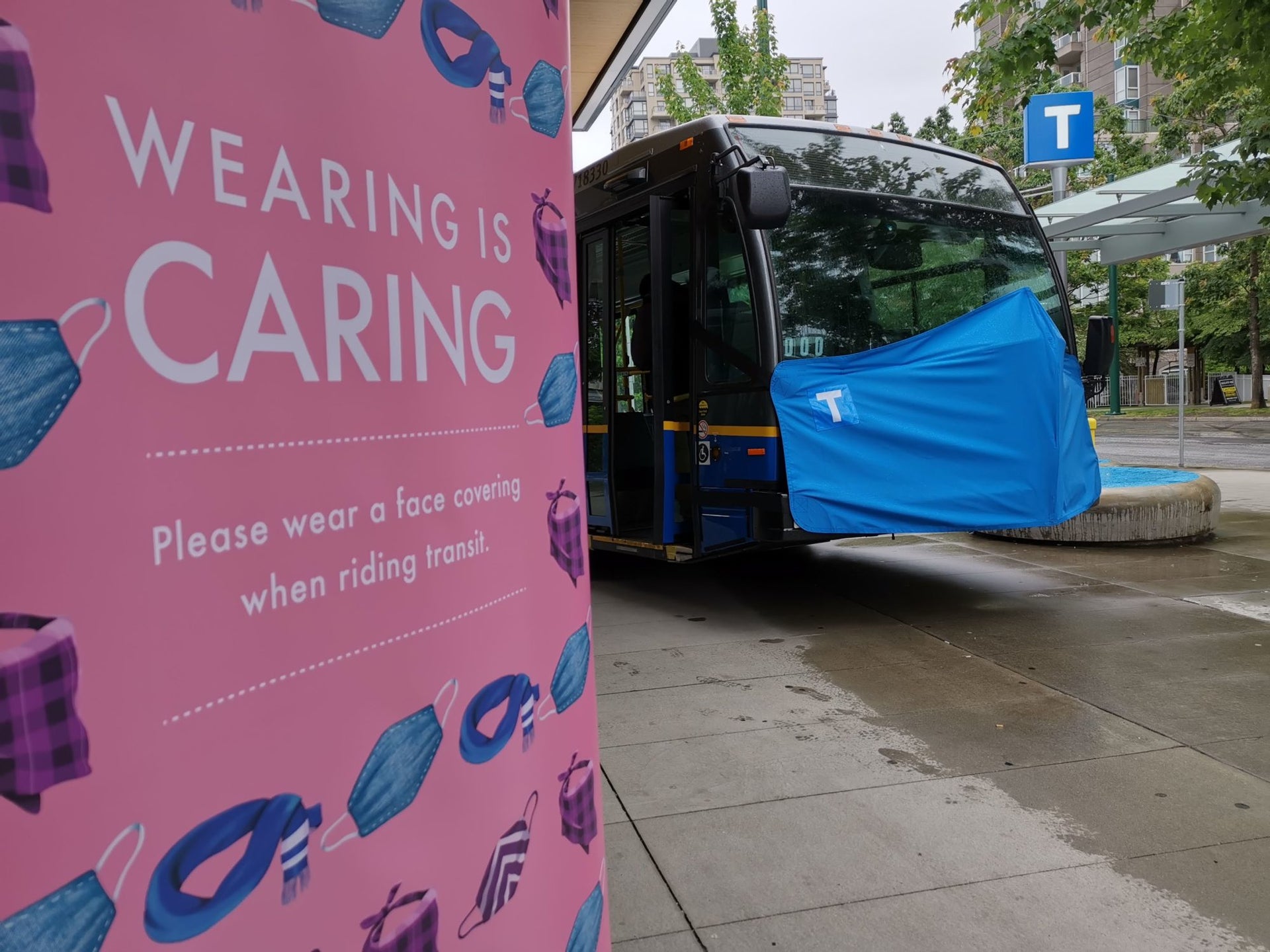
WEARING IS CARING
WEARING IS CARING
Custom Face Masks For Local Transit In Vancouver
North Sails was contacted by Troy McNamara aka “Creative Troy” about 2 weeks ago with a different project that he thought we could help out with. Troy’s company Creative Others was commissioned by Translink to design an oversized novelty mask for the front of one of their buses to help market their new initiatives titled “Wearing is caring”. Translink has planned to give away 15,000 Translink branded masks to Vancouverites and wanted one of their buses to wear a similar looking mask.
Dennis and Chris, the two service team members in Vancouver put their heads together with Troy and came up with a plan to make a mask that would fit on the front of the bus. They needed to make a mask that would resemble the masks that Translink has produced and stand up to the harsh Vancouver weather. Dennis and Chris get "neat" and "fun" projects like this a few times a year so they said that they were excited and willing to help. They had a pretty tight deadline of about 11 days. They proposed using the same method for creating bimini tops and inserting battens to create the bulging nose. First, they sourced the material in the correct colour as well as made a rough template that Troy could take to the bus depot and size up with the Translink team. Once the template was reviewed it was returned to the loft to start the production of the new mask. Within the deadline the North Sails team got the job done in time, Translink loved the end product and most importantly the process was an enjoyable one.
Troy, why did you contact North Sails and how was working with NS Vancouver during this custom project with such a tight deadline?
Being an avid sailor all my life I knew that North Sails would be the perfect team to fabricate this. I’ve met Dennis and Chris out on the water from time to time and when you get on so well with guys like that on the racecourse I was confident they’d be fun to work with too. This timeline was intense as with a company like Translink there’s always feedback and requests for alterations. I was confident that the guys would be able to produce the goods and I was right. One of the most important things for me out of this whole experience was how clear in communication the guys were, the ease in how they collaborate, and their willingness to get the job done. I will certainly be looking to partner with North Sails again for future projects.
Creative Others
www.creativeothers.co- @CreativeOther.Co- shout@creativeothers.co- +1 778 228 1672
Creative Others 404-1133 Beach Ave Vancouver BC, Canada V6E 1V1 We Are Brand Designers & Storytellers, Creating Experiences Both Physically & Digitally
While Marketing Them With Measurable Results.
Bringing Talented People Together Who Are Passionate Leaders In Their Fields To
Exceed Clients' Expectations Is What We Do.
READ MORE
READ MORE
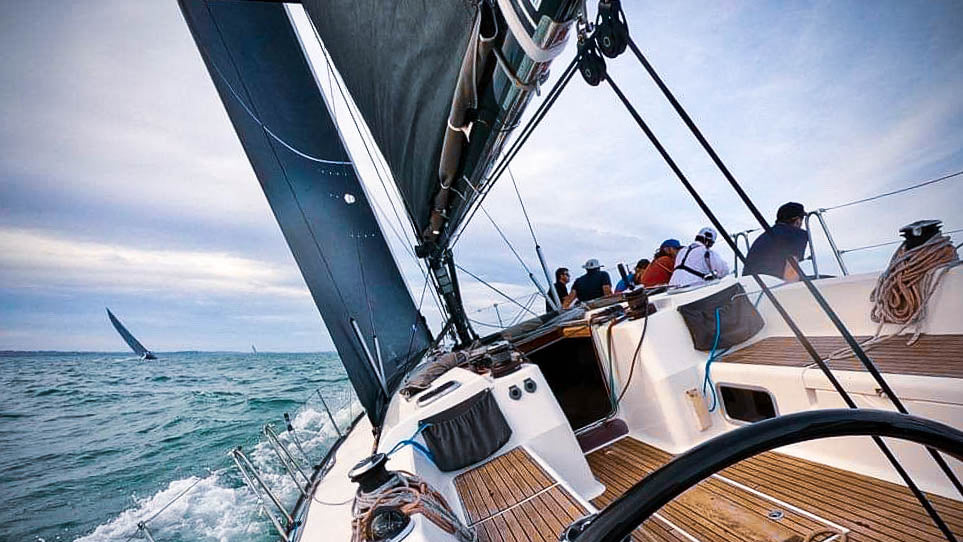
NIRVANA GETS A NEW NORTH SAILS WARDROBE
LOCAL SPOTLIGHT: NIRVANA GETS A NEW NORTH SAILS WARDROBE
New Zealand Team Upgrades to 3Di for Winter Series Wind-Up
While most of us are sweating it out during the summer months, local sailors in New Zealand are gearing up for coastal racing later this season with the RNZYS Winter Series.
Nigel Hendy and his super crew on Dufour 45e Nirvana kicked off their sailing season with the Royal New Zealand Yacht Squadron Winter Series, where they just finished the third weekend of racing with their brand new 3Di RAW sails. Launched in 2012, this racer/cruiser team has been sporting North Sails for eight years now and decided this year they would upgrade their 3DL wardrobe to 3Di to help them reach their performance goals this 2020 season.
The Sails
Before upgrading to 3Di, Nirvana carried the now-retired North 3DL string laminate, which was used to its full extent, hoisted over 200 times before officially retiring from the program.
“I upgraded because I realized I’d have a better shape over a longer period, which would extend the life of my sails. Our new sails are just great.” Says Nigel, “They are customized to fit my mast and boat, which has made all the difference. We went with a larger overlapping genoa this time around, which has also increased our power upwind, which was exactly what we needed. The shape of 3Di is fantastic–it’s just perfect.”
“It’s lighter air this season, so it was a true test for the sails over the last few weeks to show us how much power we had been missing out on. After three weekends getting familiar with our new set up, we’ve now got the sails locked in, traveler mid-ship, using a bit more vang when we need to. We can control the main a lot better, as before we were only using about 50% to keep us on our feet. The new 3Di sails allow us better control and much easier trimming.”
“The boat has everything it needs, including downwind. It’s options galore. We’ve got three asymmetrical sails, and three symmetricals. The genoa we keep on the furler, which helps when there are new crew members on board. The new sails are much lighter in general, he remarked. “They are the perfect fit. I am a happy customer.”
📸 Robert Delves
North Sails Service & Support
Nigel has been working with Andrew Wills, sail expert in Auckland, New Zealand for many years. The relationship-building aspect was something he didn’t know he would be guaranteed after purchasing sails. “I didn’t just buy a sail,” he said. “I bought a whole package of support, sailing, friends, and crew. It’s a lot of fun going to the loft. It’s like going to a toy shop. To me, the North Sails customer experience has been just fantastic.”
Every part of the service and support aspect was covered thoroughly by the team in New Zealand, and Nigel can’t thank his sailmaker enough for providing top-notch support all around.
“The advice on the rig set up and tuning, it just keeps going. You invest in a sail, but you really get so much more than you would think. You become part of the North Sails family. The way they make you feel like you are part of a team, part of a network; the way they care has made it a positive experience.”
The Crew
“I bought a racer/cruiser because my wife enjoys the cruising aspect mostly in the summer. We’ve got the dining room table set up, all the cruising amenities; she’s a great boat for that. But once the real racing season picks back up, we take out the dining table and fill Nirvana with all the sail inventory options one could ever need to race and be competitive. Nigel picks up additional crew here and there that come from small boat dinghy racing clubs. In many ways, Nirvana is a vessel to get more sailors out on the water.
“Nirvana is fully capable of any type of racing. She’s got everything she needs to go for it. We are 100% Corinthian crew, all amateurs on board, and the nucleus of my crew I’ve known for years through our children growing up together. We are quite competitive and we’ve shared many victories together.”
Nigel usually sails with 12 crew and since New Zealand has officially been cleared of Covid-19, Nigel is looking forward to having his full crew back and having the right weight on the rail.
📸 Robert Delves
Results
“We recently sailed a 50nm race and did very well. We finished second across the line. Every series we’ve entered, we’ve won at some point, in some corrected time fashion. We’ve been Club Champs, Commodore’s Cup Champs; We don’t always win on the line, because we race with a handicap–but we still obtain excellent results when we show up to compete.”
“Traditionally, it’s not very windy in New Zealand in the winter months, which is June through August. In the spring and summer, the breeze turns on. We could get 25-35 knots every day easily during that part of the season. I prefer the longer races, and there’s a lot of those on our calendar. It’s easier to find crew for those too, rather than weeknight one-off sailing. It takes a big commitment for the team, and myself so we do what we can.”
What’s next?
The next big gig for Nirvana is the Yates Cup, which is a 230nm race that goes up the coast of New Zealand in July. After that, the team plans to sail the Coastal Classic, a 110nm race from Auckland to Bay of Islands. “We are looking forward to seeing how our new 3Di sails will maximize our sail power this season, said Nigel. “We can’t wait to see how she goes.”
🎥 Video courtesy of crew on Nirvana during a White Island Race edition, hosted by Royal Akarana Yacht Club.
READ MORE
READ MORE

EN KOMPLET 3Di PRODUKTLINJE TIL CRUISING
En komplet 3Di produktlinje til cruising
3Di OCEAN kan bestilles nu
Efter et gennemgribende arbejde og udviklingsprogram, er North Sails stolte af at kunne lancere 3Di OCEAN 370, vores seneste innovative sejl som fuldender vores serie af 3D-støbte sejl til cruising og langturssejlads.
3Di OCEAN 370 er bygget på North Sails succes med det revolutionerende 3Di NORDAC samt 3Di OCEAN 700, som er det ultimative cruising sejl til store superyachts. 3Di 370 OCEAN er båndet mellem disse to produkter og imødeser 35-60 fod cruising bådes unikke behov samt det voksende antal cruising katamaraner. North Sails 3Di sejl er skabt med den patenterede teknologi, som oprindeligt blev udviklet til kapsejlads men som nu revolutionerer markedet med 3Di OCEAN.
Hos North Sails bruger vi konstant vores energi og ressourcer på udvikling af nye produktsegmenter. I 2017 revolutionerede vi cruising markedet ved at genopfinde det traditionelle Dacron sejl i polyester, som havde sin oprindelse i 1950'erne. Det prisbelønnede 3Di NORDAC blev hurtigt det nye benchmark for cruising og tursejl til både op til 40 fod. I 2018 tog North Sails 3Di cruisingsejl-konceptet videre til Superyachts med 3Di OCEAN 700 produktet. Tilføjelsen af OCEAN 370 i 2020 er endnu et vidnesbyrd om vores mission om at levere cruising-sejl med den seneste og mest avancerede teknologi til markedet.
“Vores virksomhedskultur er drevet af et stort ønske om til stadighed at udvikle sejlteknologi, der giver sejlere en endnu bedre oplevelse”, siger North Sails direktør Ken Read. “Cruising giver mulighed for at slippe livet på land og North Sails engagement i cruisingmarkedet er større end nogensinde. Vi foranledigede vores cruising-produktudvikling og næsten et år efter fremfører vi udvidelsen af vores produktlinje. Vi ser frem til at flere sejlere vil opleve det nye niveau af holdbarhed og ydeevne for cruising-sejl med 3Di OCEAN-serien”.
Med brugen af North Sails innovative 3Di-teknologi og byggeprocesser, producerer vi i dag sejl, der både er stærkere og lettere at håndtere. Denne teknologi muliggør sejl, som giver en forbedret sejloplevelse, hvor man enkelt kan reducere krængning i hård vind og nemt få mere fart i let luft.
3Di OCEAN er uden syninger og 3D-støbt på en form i ét stykke, hvilket gør sejlet uovertruffen stærkt, flot at se på og med lang holdbarhed. Det betyder i alt sin enkelthed en forbedret og sjovere sejleroplevelse for dig, dine venner og din familie.
3Di OCEAN-sejl kan bestilles nu. Kontakt os idag og få mere information om vores nye produkt og en eventuel sommerlevering.
Læs mere Find dit loft Få et tilbud
READ MORE
READ MORE
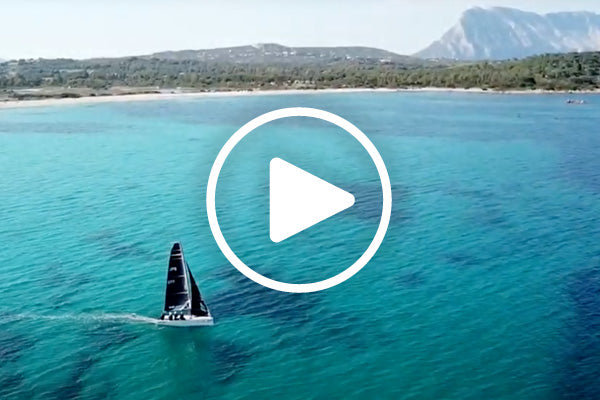
WORLD OCEANS DAY
WORLD OCEANS DAY
The Ocean is Our Passion, Our Playground, Our Responsibility.
For World Oceans Day this year, North Sails and North Kiteboarding came together to celebrate our love for the ocean. Collectively, ambassadors and athletes shared their thoughts on how we can better care for our best resource, our racecourse, our playground. Whether you are racing in a world championship, cruising for the weekend, or discovering a new place to go out and ride, we can all do small things to make a big impact on the health of our oceans.
Charlie Enright, 11th Hour Racing
“This year’s World Oceans Day has me yearning for the ocean like never before! I can’t wait to get back out there and reconnect with everything that I’ve been missing during these tumultuous times. The health of our oceans is important to all of us and it’s going to take every single one of us to get things back on track. Let’s use this inflection point as a way to combat ocean obstacles with a new level of vigor and motivation.”
Jalou Langeree, North Kiteboarding Team Rider
“Nature is the inspiration for so much of what we do…when we kite we feel so in tune with nature, so connected. We must work harder to protect it.”
Dee Caffari, Turn the Tide on Plastic
“I consider it a privilege to call the ocean my office and my playground. I have seen first hand the pollution in the world’s oceans and now with my recent work with Turn the Tide on Plastic, we have the scientific proof to support the microplastic problem we have to tackle. Our oceans act as a barometer for the health of our planet and we all can act now with a small action so collectively we can make a big difference.”
Giulio Desiderato, North Sails One-Design Expert
“All my best memories are linked to the sea. Sailing is more than just a hobby, sport, or work for me, it’s a lifestyle. If you are able to understand the values that the sea teaches you, and you are able to bring these values into your routine you will become a better and stronger person, on and off the water.”
Marc Jacobs, North Kiteboarding Team Rider
“Without the ocean, I wouldn’t be able to do what I do every day. As professional kiteboarders, we have the ability to spread awareness and have a voice for the ocean. It’s time to take action and protect our playground.”
Warwick Kerr, North Sails Expert and Cruiser
“Living on our sailboat, Wakaki is already a green life. We make an effort to always sail, and not use the engine. We conserve our freshwater and buy local and use natural/biodegradable products. We have solar power onboard, so we don’t have to use the engine to charge our batteries or turn on the lights. We don’t waste, we recycle and reuse.”
READ MORE
READ MORE
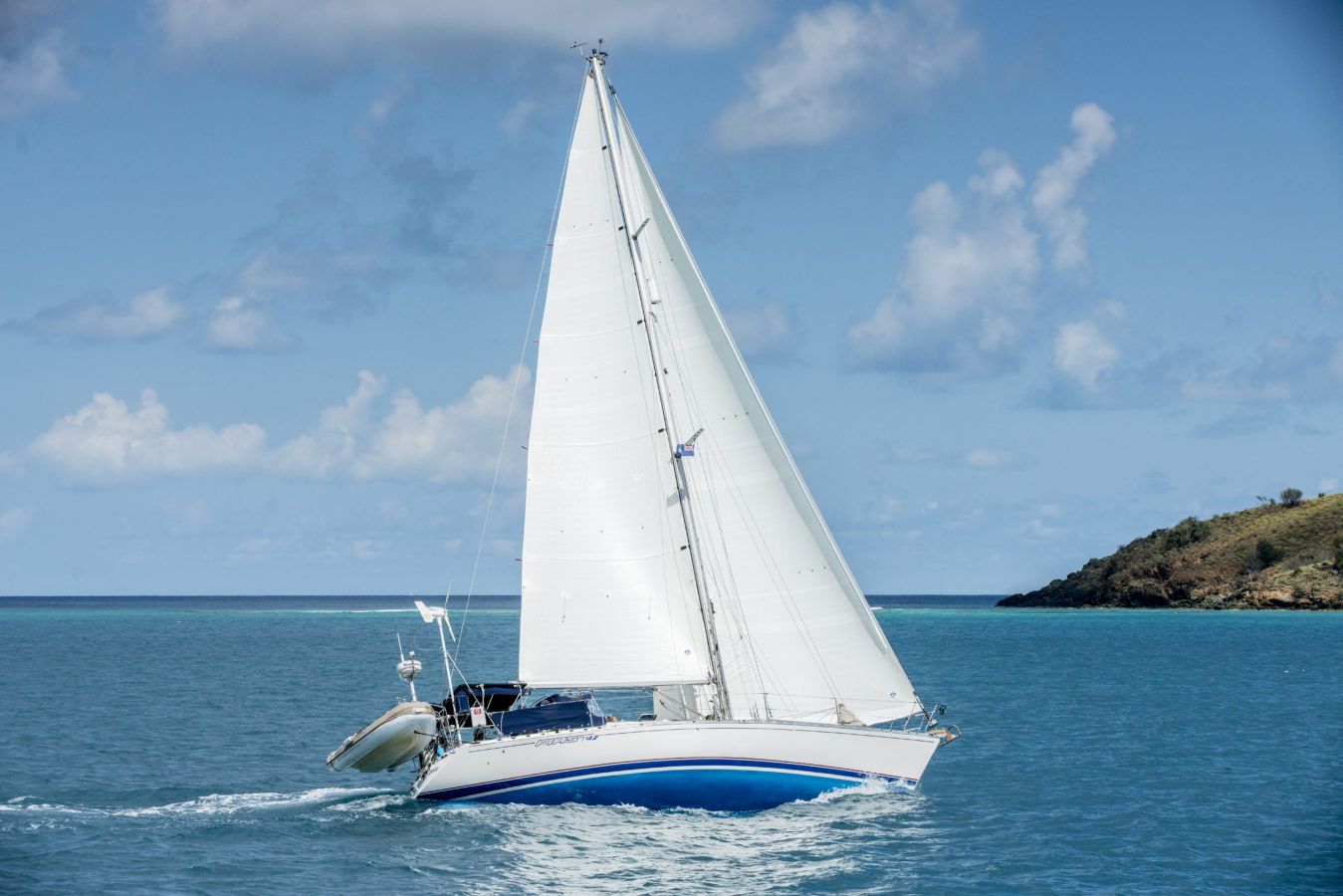
3Di OCEAN: YOUR QUESTIONS, ANSWERED
3Di OCEAN: YOUR QUESTIONS, ANSWERED
Learn More About the New 3Di OCEAN Line-Up with Our Q+A
Q: What is 3Di OCEAN?
A: 3Di OCEAN is the newest line of 3Di sails from North Sails, designed and engineered exclusively for cruising.
Q: Is 3Di OCEAN right for my type of boat and sailing?
A: 3Di OCEAN is for you if you are looking for a premium cruising product, providing high strength and durability with all of the advantages of 3Di sailmaking.
Q: What is different and better about 3Di sailmaking?
A: 3Di is a unique-to-North molded composite sailmaking process. With 3Di, individual filament tapes are printed in precise tape vectors (length/direction) and densities. This membrane is then consolidated using heat and thermoset resin on a full size, sail-shaped mold. 3Di results in strong, smooth, and precisely shaped sails.
Q: How does 3Di OCEAN differ from your other 3Di products?
A: 3Di OCEAN sails are optimized for cruising strength and durability, while 3Di RAW sails are engineered for low stretch and lightweight racing performance. 3Di ENDURANCE sails are suitable for both cruising and racing – with a balance between low stretch shape-holding and added durability.
Q: Which 3Di OCEAN sail is right for me?
A: 3Di OCEAN comes in three distinct styles, for an increasing range of boat sizes:
OCEAN 330 is 100% NORDAC Polyester and suited for 25’-45’ cruising boats
OCEAN 370 is for boats larger than 45’ including many cruising multihulls which require the lower stretch and greater strength of Ultra PE blended with 3Di NORDAC polyester
OCEAN 700 serves boats larger than 60’ with a high modulus blend of UltraPE and aramid
Q: How long has North been building 3Di cruising sails?
A: 3Di technology has been around for over a decade, and 3Di sails are in use on thousands of boats that have sailed millions of miles.
Q: What are some specific benefits of 3Di OCEAN sails?
A: 3Di OCEAN is beneficial because it is durable. 3Di NORDAC Polyester and UltraPE fibers are more UV and flex-fatigue resistant than other fibers used in upwind sail materials. The product composite construction with thermoset resin means no mylar, eliminating the problem of delamination associated with laminates and string sails. 3Di OCEAN has a specialized outer surface tape, that provides chafe and abrasion protection–which is great for in-mast or in-boom furling.
Q: Are 3Di Ocean sails good for racing?
A: Not as good as an ENDURANCE or RAW sail! OCEAN is not engineered specifically for racing. Sure, if you want to join an occasional race or rally, 3Di OCEAN sails will be fine. If you are looking for dual-purpose “crossover” sails – that can be found with 3Di ENDURANCE. And of course, 3Di RAW is racing.
Q: What about other materials? Does North still make cross-cut cruising sails?
A: Yes, North has other paneled cruising sail options available. NPC Cross-Cut sails feature traditional woven polyester. NPL Tour sails are made of proprietary laminated sailcloth to match a variety of applications and price points. Depending upon your needs and expectations, North has a cruising sail that is right for you.
Explore Materials Find a Loft Request a Quote
READ MORE
READ MORE

THE NEW NORMAL
THE NEW NORMAL
First Sail Of The 2020 Season
Getting out on the water earlier this week felt like a dream. During a normal season, we’d be well into the thick of sailing by now with lots of regattas under our belts and cruising trips taken. We’d be sunburnt with racoon eyes, beat up by the boat and cycling through sailing gear faster than we could wash it.
With the threat of not being able to even launch boats at the end of March and mid April, the majority of sailors were questioning what the 2020 season would look like. Fast forward a couple weeks and most of us are in the water, following government regulations and yacht club rules. A lot of back and forth about what would happen for racing is still being discussed, it begs the question - why are we so focused on racing? Our boats are in the water (for those of us that can be) so why not go sailing? For the most part, any organized racing is not allowed, as per Sail Canada’s outline. While disappointing, it's OK. Racing is an aspect of our sport, yes, but it is not the only thing. Sailing is so much more than racing.
The simple fact is yes we can go sailing. The love for the sport has not been cancelled, sailing has not been cancelled. It’s gone back to the most basic form that is sailing with family, cruising, double handed or even solo sailing. I can honestly say that yes it’s refreshing to not have the weekend grind of regatta after regatta after regatta. Do my family and I miss racing? Yes, more my husband than me but yes racing is missed. Does it mean that sailing, as a sport, is cancelled? No.
Try taking this time to fix things on the boat that you’ve been putting off, trying some solo sailing or just enjoy being on your boat. More importantly though, go enjoy sailing for the sake of sailing. Talking with a friend recently about the sailing situation in particular the number of people upset about no racing, they commented saying they are disappointed but it doesn’t mean sailing is cancelled. The more interesting comment, which has stuck with me since our conversation, was “maybe it’s just me but I just enjoy sailing for the sake of sailing. A lot of people seem to be missing that with the uproar of no racing.”
What this afternoon on the water really did was reaffirm my love for the sport, the activity and being out on the water. I can’t remember the last time I was this giddy when it came to going sailing. A somewhat laughable thought given I work in the industry yet maybe something that was needed to revive the love for sailing. Being able to go sailing with no pressure about getting photos, delivery sails, getting repairs done or trying to get a certain spot in a regatta was refreshing. Coming back to the docks post afternoon sail, we ran into a fellow member, us in the boat and them on the dock. They also commented how this year was different and they are adapting but it felt good to get back out on the water. He mentioned he "took the racing jib sheets off and put a furler on" to go cruising. An attitude that is going in the right direction for enjoying the 2020 season.
It means we have to adjust our own perspective and how we approach this summer on the water. In layman's terms: be appreciative if you can get your boat in the water and go sailing, according to your local government and sailing authority guidelines. Go cruising with your family, go for an afternoon solo sail or better yet, enjoy being on your boat. Sailing is not cancelled.
Learn more about North Sails lineup of cruising products here.
READ MORE
READ MORE
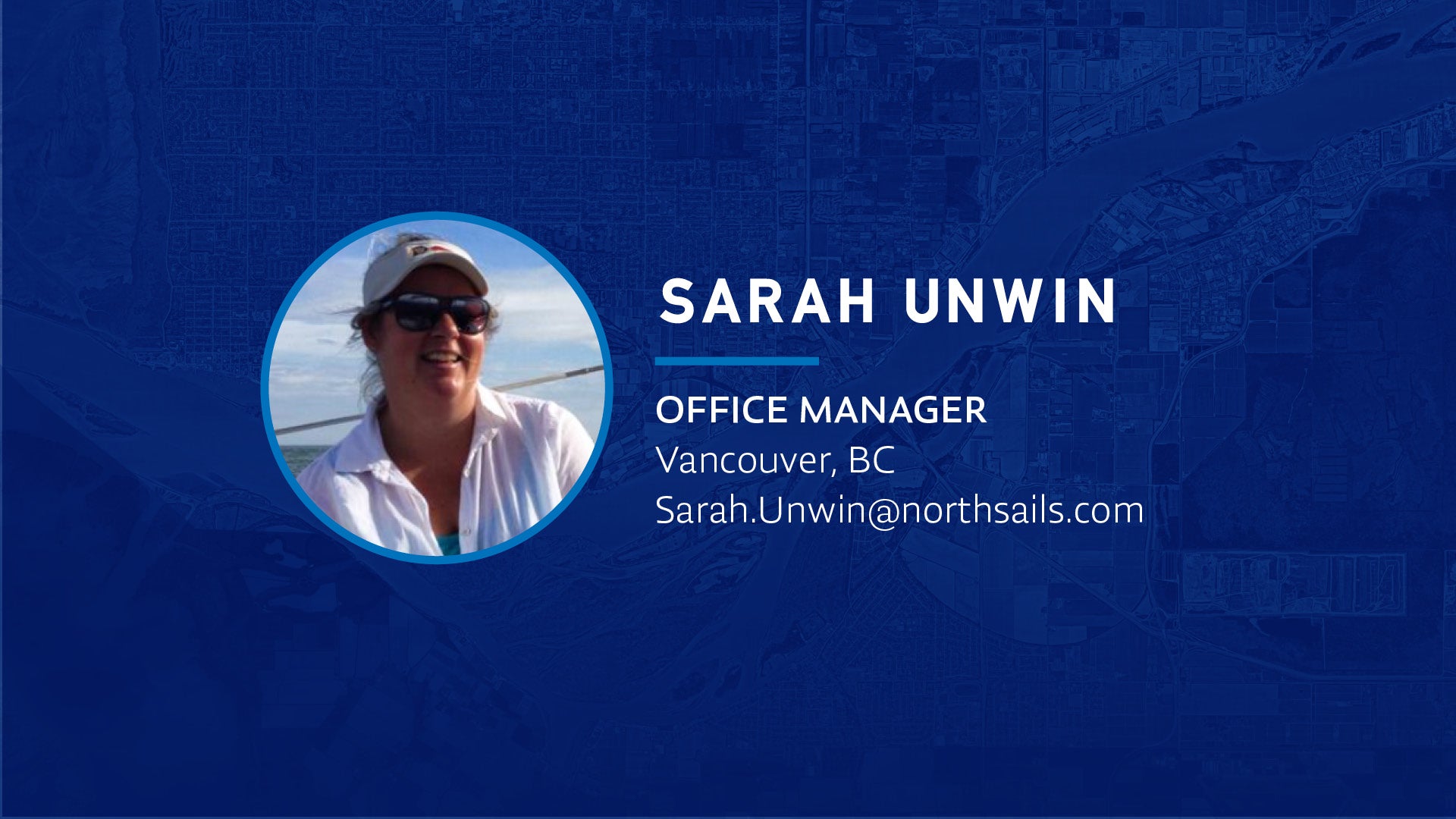
WHO WE ARE: SARAH UNWIN
WHO WE ARE: SARAH UNWIN
Get To Know Your Local Team Member
Sarah Unwin joined North Sails a year and a half ago as the office manager of North Sails Vancouver. She is born and raised in Vancouver at 38 years old. She first learned to sail in an Opti at RVYC summer sailing program. Sarah was 16 when she competed in her first race, Silva Bay Layover on a Dragon with her now Husband, James.
What is your favourite local regatta/race and why?
Round Bowen, it is such a fun race and has a great party!
Where is your favourite spot to go cruising and why?
Desolation Sound, I have been cruising in Desolation Sound since childhood and you can't beat the beaches, scenery and wildlife.
What is it about sailing that you enjoy the most?
You are always learning and the freedom of cruising to places most people have never visited. B.C. has some of the best cruising grounds in the world and we feel very fortunate to be able to explore the B.C. coast.
What activities do you enjoy outside of sailing?
My husband, James, and I are avid skiers.
How have you been keeping busy since all racing has been cancelled?
We have been doing boat work and going for day sails. We look forward to racing and cruising again.
READ MORE
READ MORE

ONESTAR CHALLENGE 2020
ONESTAR CHALLENGE 2020
Med Jan B. Hansen fra North Sails
På vej mod Farø med A2
Onestar Challenge er en singlehand sejlads med start fra Køge, rundt Møn via Bøgestrømmen. 103 sømil.
Det er 4. gang sejladsen sejles, men jeg har ikke sejlet den tidligere, da den altid har ligget på samme tid som en af de store Fyn Rundt sejladser. Nu er det andre tider og årets eneste Fyn Rundt bliver formentlig Silverrudder til september.
Der var tilmeldt 33 både, som startede i passende Corona-afstand. Der sejles ikke efter respit, udelukkende i klasser efter overaltlængde. Min klasse var alt over 32 fod.
Første start kl 9:00, min start kl 10:30. En fin start med Code 0 mod Stevns, derefter en åben bidevind mod Møn. Vindstyrken omkring 10-15 knob og høj sol. Humøret var lige så højt som solen, da de samtidigt startende både forsvandt lige så hurtigt agterud, som de foran startende blev indhentet. Næstsidste båd blev hentet mellem Møn og Hestehoved (Indsejlingen til Grønsund). Tilbage foran var en tysk T 24, sidste første båd i mål. En rigtig lille skrapsag, hurtig båd og dygtig sejler. Gennem Grønsund og mod Farø, var det plant læns. Det udløste en del bomninger med den blå A2, men ingen større udfordringer. De blev taget på rutinen. Udfordringerne kom lidt senere da vinden fra Farø op mod Peters værft var lige ret i trynen med 10-15 knob, toppet op med 1 knobs modgående strøm. Inden jeg kom til Farø, måtte jeg tage en lidt længere sørejse end de forfølgende både, da min dybgang på 2,10 satte en naturlig begrænsning for vovemodet. De betød desværre at, det meste af mit forspring til de nærmeste forfølgere blev sat overstyr. Men det er en del af spillets ved den slags semiautonome sejladser. Her er stort ingen mærker der skal respekteres og ingen målerregler. Alle kan tages deres chancer og spiller man sine kort rigtigt er muligheden for en sejr altid til stede, uanset hvor svage ens odds er fra starten.
Tilbage til krydset mod Peders Værft: Her kom en velsejlet Drabant 38 forbi mig med en 100 meter. Vendinger i The Beast er som sådan ikke svære, men igen sætter dybgangen en grænse for længden på krydsbenene og båden, med sin meget smalle køl, driver en del sidelæns, indtil den kommer op i fart. Flot sejlet af Drabanten. Nå, men efter Kalvehave (kl 21:30) kom der lidt slæk på og vinden øgede op til 20-25 knob. Drabanten blev hurtigt nedkæmpet. Næste levende billede var T 24’n, som flaksede noget forvirret rundt ved renden til Nyord. Så snart han fik øje på mig, faldt han direkte ned i mit kølvand og forsvandt hurtigt agterud. En efterfølgende molesnak med skipperen, opklarede at han både havde miste sin kortplotter og sin autopilot. Hatten af for han overhovedet fik den sprælske båd hele vejen til mållinjen. Som mørket lukkede sig omkring os, friskede vinden yderligere op til 30-35 knob ved udsejlingen omkring de Nordre Sæløer. På det tidspunkt havde jeg alt for meget sejl på, den største fok og fuldt storsejl. Men der var ikke plads nok til hverken et forsejlsskifte eller til at rebe storsejlet. Så det var fuld vandballast og fuld knald på hækstag, udhal, cunningham og lidt slæk på fokken skødepunkt, så den blev lidt mere åben i agterliget. Det er meget betryggende med nogle 3Di Raw sejl, som jeg ved kan tåle mishandlingen. Alm. stringsejl var blevet 3 år ældre på de 30 minutter. Et par meget spændene slag op mod selve renden. Det sidste hvor jeg vendte til stb for at kunne holde renden op kiksede. Fokkeskødet kom i bekneb omkring spillet og fik 10-15 tørn i en meget flot benlås. Renden kunne med lidt pineri, lige præcis holdes op. Lidt heldigt, da en vending med det låste skøde, havde givet sine udfordringer. Efter renden var det med 5 cm slæk i fokkeskødet afsted mod Stevns for sidste gang. Præcis som der skulle justeres på kursen ved nordøst rundingen af Stevns, kom der et markant vindskift fra NØ til SØ, toppet op med lidt ekstra tryk på vinden. En kvik bomning i 35 knobs vind og vi fløj afsted med op til 14 knobs fart mod Køge downtown. Som jeg sidder der i nattemørket og kun kan se det hvide flade vand agterude i lanternes skær, funderede jeg lidt over hvordan passagen af mållinjen kunne ske. 10-14 knobs bs, vindvinkel på 120 twa og knap 100 meter fra linjen til land, kunne det nok blive presset. Men vinden aftog den sidste halve times tid. Det samme gjorde dramatikken, så målgangen foregik kontrolleret kl 02:42 som første båd i mål.
Flere både stoppede klogelig op i Kalvehave og Nyord for ikke at komme ud i den friske vind mod Stevns. Respekt for at skipperene kender deres egne og bådens begrænsninger. Det er godt sømandskab.
Tak til arrangørene, Køge Sejlklub, for kunne afholde sejladsen med tidens prøvelser og tak til konkurrenterne for at møde op.
Og ikke mindst tak til min elskede shorecrew, Helle Jespersen, som stod ved både Hårbølle og Nyord og heppede.
Jan B. Hansen
The Beast himself
Til dem med skarpe øjne: Konkurrenterne agterude.
READ MORE
READ MORE

I NAKON COVID 19 PAUZE NORTH SAILS KLIJENTI NASTAVLJAJU S POBJEDAMA
I nakon Covid 19 pauze North Sails klijenti nastavljaju s pobjedama
FOTO: DRAGAN DRŽANIĆ
Rekordno izdanje najdugovječnije regate za dvočlane posade s hrvatske strane Jadrana uspješno je završila s 85 postotnim učinkom... od 54 jedrilice na startu završilo ih je 46!
Zbog vremenskih neprilika i vrlo jakog juga start regate je prebačen s petka na subotu, a zbog najave vrlo slabih vjetrova na regatnom polju organizatori su subotnji start zakazali za 10:00. Tako su jedriličari dobili dodatna dva sata za jedrenje i s tim bonusom čak 14 jedrilica je dobilo priliku da u regularnom vremenu završi regatu.
Vrijeme na startu bilo je u skladu s prognozom, jedva primjetni povjetarac iz smjera zapad - jugozapad, po kojem je flota u slow motionu jedrila prema bovi od orce postavljenoj ispred Sustipana. Nakon nje jedrilo se prema bovi koja je uz Galebove predstavljala startnu liniju i potom je jedina obaveza jedriličarima bila ostaviti Sušac desnim bokom. Pokazalo se da je najbolje odabrala skupina jedrilica postavljena malo desnije od sredine startne linije, a do bove od orce najbrže je dojedrila Fatamorgana koja je startala iz trećeg reda.
FOTO: REGATE.COM.HR
Fatamorgana je maksimalno iskoristila svoje mogućnosti i u ovom dijelu regate pratnju ostavila iza sebe stotinjak metara. Nesmetano je nastavila jedrenje bliže Sustipanu i održavala prednost sve do Splitskih vrata.
Prvi nakon nje su bili budući pobjednici regate, dvojac iz JK Orsan na jedrilici Dubrovnik. Oni su na bovi od orce predvodili ostale pretedente na dobar plasman, a među njima svakako treba spomenuti čak četiri jedrilice Club Swan 36, maleni Otto e Mezzo, Magnum X3, IMX 45... U ovom početnom dijelu regate među njih se umiješala i Strilica, Melges 24 koji se orci prišuljao od Sustipana. S obzirom na uvjete u ovom dijelu regate to se još moglo i razumijeti, ali dvojac Jurišić-Perhat je svoje opasne namjere i vrhunsko jedrenje održavao do kraja regate, pa su čak i do pred sam finiš bili izraziti favoriti za pobjedu u korigiranom vremenu po Sušac Openu.
Ovaj prvi dio regate, brojnoj publici na lukobranu i Sustipanu, definitivno je bio najzanimljiviji. S obzirom na malene brzine jedrilica mnogi kormilari su se odlučili na rizik i ubacivanje u gužvu, pa nije nedostajalo poziva s isticanjem prednosti prolaska i srećom sve je prošlo bez kontakta i štete.
Nakon prolaska ovog filtera i obilaska druge oznake krenulo je rastezanje flote i izdvajanje najbržih na čelu. U principu su se svi držali najkraćeg puta prema Vratima, bez ekstremnih otklona, osim u finalnom dijelu ove etape kad se vodeća Fatamorgana izdvojila prema Šolti, a ostali su vjetar tražili na punti Brača. Odluka dvojca Arapov-Mrduljaš na kraju nije donijela očekivanu prevagu, jer ih u samim vratima Dubrovnik prestiže, a ostatak potjere opasno sustiže.
Sve jedrilice su u Splitskim vratima naišle na probleme i svaka je na svoj način tražila izlaz. Muka po Vratima trajala je do 16 sati, otprilike kada je i Bob 'n' Rock kao posljednji izašao na relativno otvoreno more. U tim trenucima vodeća petorka (tri Swana, Dubrovnik i Fatamorgana) je na desetak milja od Sušca. Njihov pritisak jednih na druge za zauzimanje vodeće pozicije priča je za sebe, pa je najbolje da je čujete iz prve ruke. Detaljno kako je regata izgledala ispričali su članovi posade Dubrovnika, pobjednika regate i u realnom i korigiranom vremenu:
Na startu smo nešto zapeli, napravili smo jednu pojalabandu nekih 4-5 minuta prije starta i nismo se maknuli s tog mjesta sve do signala starta. Tako da smo startali s mjesta gdje nismo planirali. Tek kad se malo raščistila prva linija i stiglo malo vjetra uspjeli smo krenuti prema Sustipanu. Tamo je bilo dobro, lijepo je vuklo i do prve bove smo stigli kao drugi, odmah iza Mate. Na kraju je dobro ispalo iako nije bilo dobro u samoj proceduri. Na početku smo jedrili s genakerom jer sam planirao da jedrimo malo više prema Braču. To smo i napravili nakon obilaska pina, koji je bio druga obavezna bova. Kad smo već bili u blizini Brača učinilo mi se da smo previše nisko pa smo se prebacili na drifter. Lijepo smo krenuli, jedrili smo odlično i došli smo u situaciju da smo trebali prebaciti jedra koja nismo dignuli na novo mjesto na palubi, malo više prema krmi. I sve je bilo dobro dok nisam uhvatio vreću s olujnim jedrima koju dok sam prebacivao uspjevam baciti u more! Onda brzo akcija rolanja driftera, pojalabanda i natrag po jedra da ih spasimo prije nego potonu. Uspjeli smo ih uhvatiti taman prije nego je vreće potonula, ponovo pojalabanda, odrolaj drifter i idemo dalje. Dalje je sve bilo kako sam i mislio da će biti. Splitskim vratima smo prilazili od Bobovišća i Milne od kuda su nam dolazili neki refuli i vrlo dobro smo se izvukli. Iz Vrata smo izašli prije Mate. Prije samog izlaska vidjeli smo da vani pjeni, pa smo se odmah pripremili za flok i skidanje driftera što smo i napravili odmah čim smo izašli vani. Od tuda je bilo jedrenje pun gas. Prvi plan je bio da idemo oko Vodnjaka od kuda bi se samo spustili prema Sušcu, ali dolje, malo prije Pelegrina pali smo prenisko i odlučili smo da ne idemo forsirati, pa smo se spustili prema Ždrilcu. Iz te pozicije smo vidjeli da ni drugi brodovi nisu bili u boljoj poziciji, već su i oni bili nisko i da su i oni morali za nama. Kad smo došli do Pelegrina ponovno smo se prebacili na genaker s kojim smo jedrili do Ždrilca. Kako ranije nisam nikad prolazio na jedra kroz Ždrilac, već samo motorom, nisam znao kako tu puše. Mislio sam da prebacuje preko, pa smo se tu vratili na flok. Međutim, nije trebalo ništa dirati... tu smo vidjeli Bambija da je on tako samo doletio s 12 milja i prošao bez problema. Mi smo se onda na izlazu vratili na genaker i onda smo i mi nastavili pun gas prema dolje. U toj zoni nas je Bambi prošao. On je vozio dosta oštrije i većom brzinom, a mi to nismo mogli pratiti. Onda smo rekli... OK, idemo jedriti našu regatu, bez pariranja i izvuči maksimum iz Dubrovnika. Tako da smo mi vozili malo više prema Vela Luci... kako je vjetar slabio dizali se, kad je jačao spuštali se i to je dosta dobro ispalo. Nismo puno zaostali za Bambijem, a do punte Sušca stižemo s druga dva Swana (Rameša - Šangulin, Hrvoj - Škrlj). Bambi nas je tu čekao u bonaci, ali uhvatio je jedan reful prije nas s kojim se izvukao iz zavjetrine, a nas troje se tu vrtilo još nekoliko minuta... ono, reful lijevo, reful desno... pa s kraja, pa krma, pa orca... Kad smo se napokon izvukli u čisti vjetar plan je bio da se držimo više na zapadu i malo bliže Visu jer je izgledalo da je s te strane malo jači vjetar. Tako da smo prvo napravili malo duži repiket prije nego smo okrenuli prema Paklenjacima. Kad smo napravili taj manevar i krenuli uzbrdo vidio sam da sustižemo Bambija. Negdje na pola puta do Paklenjaka vjetar je naglo skrenuo prema levantu. Udarilo nam je u provu i morali smo pojati i jedriti prema Vela Luci. Tu smo virali i jedrili opet prema Visu. Tu je i vjetar malo pao, pa smo se prebacili na drifter i nastavili odlično voziti... imali smo odličan i kut i brzinu. U tom smjeru smo jedrili dok vjetar ponovno nije dao od poje, pa smo onda virali i smjer je bio takav da smo se nadali s njim dojedriti do Paklenjaka. Kako smo jedrili vjetar je ponovno malo okretao i na kraju smo završili na Pokonjem Dolu. Ovog puta nisam htio da idemo kroz Ždrilac jer je već bila noć, a par sati ranije mi je bilo prvi put da sam uopće projedrio kroz njega, tako da odluka nije bila teška... Kako smo prvi ušli u Hvarski kanal onda su se ostali mogli ravnati po nama i vidjeli su kako nam puše i onda su vjerojatno zaključili da im je bolje okušati sreću kroz Ždrilac. Ali tu smo se opet škapulali, nakon par vira uhvatili smo neki vjetar s kraja zbog kojeg smo se držali bliže otoku i onda smo s tim refulićima orcavali kroz cijeli kanal. Izgleda da je ovaj potez bio stvarno važan, jer od ostalih samo je Bambi uspio proći kroz Ždrilac, a ostali su se morali okrenuti i jedriti oko Paklenjaka. I dok je Bambi došao do punte Pelegrina mi smo bili skoro pa pred Splitskim Vratima. Inače, kad smo okrenuli Pelegrin očekivao sam da će nas dočekati neki levanat, ali bilo je stvarno slabo i više smo išli na kurenat nego na vjetar, ali kad je vjetar stigao stvarno brzo smo prešli preko kanala. Onda kad smo stigli pred Vrata opet je bilo pitanje što ćemo i kuda ćemo. Zbog kurenta smo izabrali da u sama Vrata uđemo od Šolte i stvarno su nas iz Livke dočekali dobri refuli s kojima smo dosta dobrom brzinom prošli unutra i uspjeli se prebaciti ispod Mrduje. Tu smo oko sat vremena čekali vjetar. Prvi refuli su krenuli iz Milne... puhali bi pa stali, pa opet tako i iz Bobovišća... i tako smo se nekako u zoru dokopali punte Brača. U kanalu, iza Brača, u to vrijeme počela se formirati crta za koju sam pretpostavljao da je od levanta, ali kad smo stigli do nje ispostavilo se da se formirao vjetar s krme... nešto sa zapada. Tu smo se vrtjeli dosta dugo, nismo se uspjeli maknuti, a za to vrijeme su se počeli Bambi i Mate približavati. Znao sam će Mate opet ići pod Šoltu, ali sam očekivao da će ići zapadnije i da će u cilj dolaziti uz Čiovo, ali srećom nije bilo tako, a i do nas je stigao neki mali refulić s kojim smo parirali ekipi iza nas i držali se ispred njih. Najnapetije je bilo pred samim ciljem jer je vjetar dolazio sa svih strana. Bambi je uhvatio neki crni raz koji kao da je bio od tramuntane i s Code 0 je jedrio ravno prema cilju, a Mate i mi smo bili više prema sredini kanala. Tu smo onda i mi opet vratili se prema sredini da pokušamo i mi uhvatiti tu tramuntanu, ali ipak je nadjačao ovaj vjetar s istoka, tako da smo s tim jednim refulom uletjeli ravno u cilj dovoljno brzo i za realno i za hendikep. Stvarno je bila zanimljiva regata, nije bilo ni jednog trenutka kad smo se mogli opustiti.
Denis Vukas, jedrilica Dubrovnik
FOTO: DUJE PETRIĆ
Drugi koskiper na jedrilici Dubrovnik bio je Ivo Kvestić:
Regata je bila toliko napeta i zahtijevala je puno rada, tako da nije bilo nikakvog spavanja, jednostavno se nije stiglo, a nije nam niti palo napamet. Stalno je ili netko nas ugrožavao ili smo mi nekog napadali. Ali nije bilo nikakvih problema po pitanju sna. Što se tiče hrane, svaki je pojeo po tri sendviča, svakih 5-6 sati, pa neke čokoladice... Adrenalin je stvarno bio jak i nisu se javljale potrebe ni za hranom ni za snom. Stalno je bilo samo naprijed, naprijed... odlučili smo pobijediti regatu ili "poginuti" pokušavajući. Vrebali smo svaku grešku protivnika i stvarno smo dobro iskorištavali sve prilike koje bi nam se ponudile. Istina, tih prilika nije bilo puno... svi što su bili u vrhu su stvarno vrhunski jedriličari i svi su imali cilj jednak kao i mi. Inače na brodu je sve odlično funkcioniralo, nije bilo nikakvih tehničkih problema, a puno smo radili s rasporedom mase. Jedra koja nisu bila podignuta smo po potrebi prebacivali po palubi, a jedini peh je bio kad je vreća s olujnim jedrima upala u more. Tad smo se morali okrenuti i vratiti po njih i bilo je već u posljednjim trenucima. Vreću sam zgrabio kad je krenula tonuti, a kako smo vozili stvarno ju je bilo teško izvaditi. Na kraju smo je morali udvoje izvlačiti i tu sam izgleda istegnu neki mišić i par sati nisam bio u svom najboljem izdanju. Procijenili smo da smo u toj situaciji izgubili sigurno jednu milju... zezali smo se kasnije da smo imali "man overboard" situaciju. Ali u svakom slučaju drago nam je što smo se vrlo dobro nosili protiv tehnološki superiornijih brodova, pogotovo u dijelu od Ždrilca do Sušca gdje su Swanovi s krilima i sa po dva kormila mogli skroz drugačije jedriti od nas, ali dočekali smo inkrmaniju situaciju zbog koje smo im se priključiili na Sušcu. Najvažnije je da ćemo ovu regatu pamtiti po dobrome!
Ivo Kvestić, jedrilica Dubrovnik
Što se tiče ostalih sudionika ovogodišnjeg Sušca ni većini njih nije bilo dosadno. Dapače, s ovolikim odazivom svatko je mogao pronaći sebi ravnog protivnika, a na moru je atmosfera bila slična onoj na regati Jabuka, kad je veliki broj jedrilica na istom mjestu i već sama takva koncentracija ne dozvoljava popuštanje, jer ako neki vaš propust neće iskoristiti prvi susjed, možda hoće onaj iza njega.
Ogromna većina sudionika je na putu prema jugu izabrala prolazak kroz Ždrilac, poput vodeće nekolicine. Samo pet jedrilica je izabralo kompletni obilazak Paklenjaka. To je najviše iskoristio jedini Class 40 - Crazy, koji je s obzirom na svoje tehničke karakteristike imao značajne probleme po slabom vjetru nakon starta, ali na Sušac zato stiže drugi nakon vodeće skupine. Ispred njega je bila jedino Strilica - Melges 24 koji je odlične pozicije nakon starta izvrsno iskoristio sve do Sušca i pri tome bio najozbiljniji kandidat za pobjedu po "premjeru".
Strilica Sušac uspijeva obići prva ispred ove skupine, ali zato je Crazy zapeo, a njegovo mjesto je zauzeo Magnum X3 uz kojeg su vrlo blizu bili Munjek F koji se u vodeću skupinu ubacio praktički iz drugog plana, te Otto e Mezzo.
Uz neočekivano velik broj sudionika regata je posebna i po tome što su se mješovite posade počele javljati u nezanemarivom broju. Bilo ih je pet! Najbolje plasiran je bio par na Crazyju, a iza njih su ostale mix kombinacije na Ramoni, Runawayu, Liberi i First Loveu. Inače, na Liberi, miniju 650, jedrili su Ivica Kostelić i Petra Kliba, a ova regata im je bila prvi službeni nastup u sklopu priprema za kvalifikacije u miješanim dvojcima za olimpijadu u Parizu. Istina, izostao je rezultat, ali ovo nisu bili uvjeti za njihovu jedrilicu, koja bi se pokazala mnogo boljom da je start bio u petak, po jugu zbog kojeg je regata bila i odgođena jedan dan.
Od ostalih sudionika svakako treba istaknuti i nastup vjerojatno najmlađe posade na ovogodišnjem Sušcu, Opatijaca Marka Vuksanovića i Luke Skokana na jedrilici Bokeljka koji su u cilj ušli kao vrlo dobri 16.
Raspored ulazaka u cilj s pripadajućim vremenima možete pronaći na ovom linku, dok se ovdje nalazi raspored nakon obavljene korekcije po Sušac Openu, kao i po THC-u, a bogatu fotogaleriju sa starta možete pronaći na ovom linku.
Posebno poglavlje priče o Sušcu iskusni veterani na Barki veloj - Dejan Velimirović i Marko Švent kojima je ovo 23. nastup na Sušcu, kao i Miljenko Nikolić koji je ove godine ovu regatu odjedrio po 20. put!
READ MORE
READ MORE
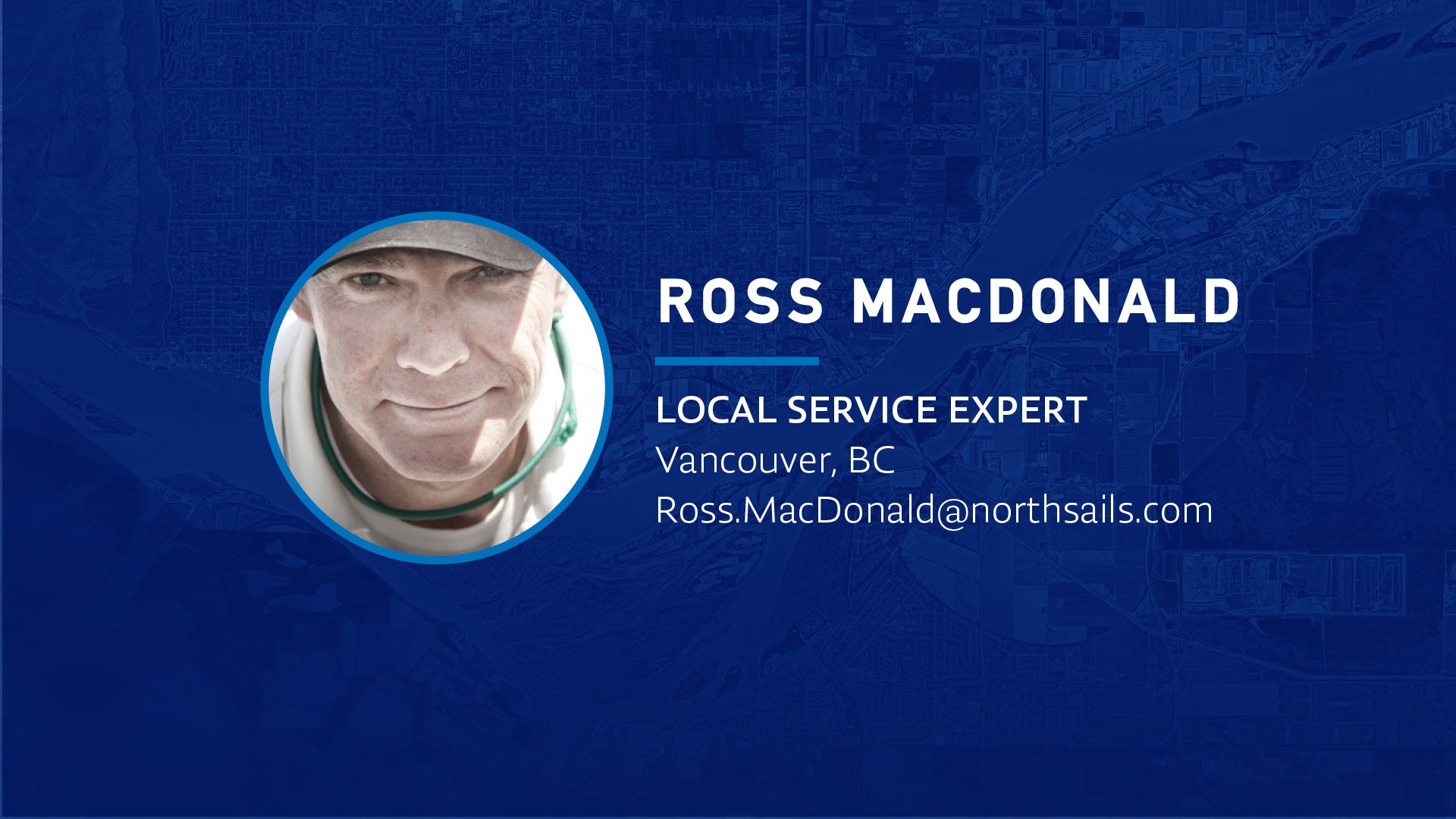
WHO WE ARE: ROSS MACDONALD
Get To Know Your Local Sales Expert
Ross in the Canadian flag bearing hat on the right.
Ross MacDonald has been with North Sails for 14 years; 4 years with One Design and 10 years with the team at the Vancouver loft. He is 55 years old and was born in Vancouver. The first boat he ever sail on was his family's boat in 1969, an Alberg 30.
What is your favourite local regatta/race and why?
Round The County is my favourite race. It's great to meet up with old friends from all over British Columbia and Washington State.
Where is your favourite spot to go cruising and why?
My favourite spot to go cruising is Manson's landing off Cortes Island; sunsets and great swimming!
What is your favourite design of boat and why?
The Star class. It's a timeless design that has its attributes such as bulb keep as well as chined, high righting moment hull shapes that are finally seen on cruising boats today - 100+ years later.
What is it about sailing that you enjoy the most?
Getting the most out of the rig and sails. Being out on the water as well with friends and family is a big plus.
What activities you enjoy outside of sailing?
I enjoy skiing and bike riding.
Tell us something interesting about yourself that most people would not know.
I use to have red hair!
How have you been keeping busy since all racing has been cancelled?
I've been working on our boat, an X-41, and tidying the house. There's also quite a bit of planning going on for when we are allowed to travel and compete again, which I'm looking forward to.
READ MORE
READ MORE
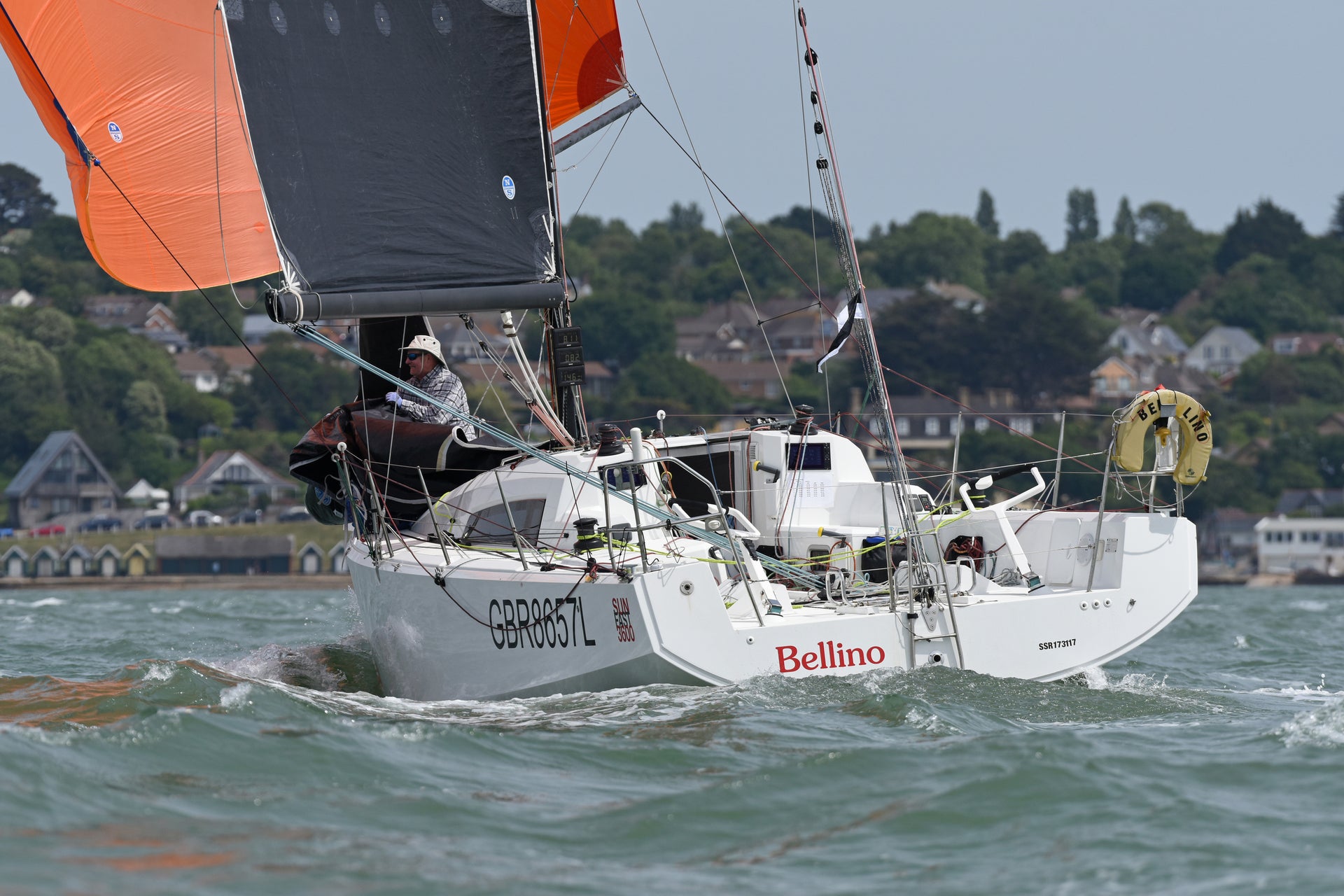
SHORTHAND SAILORS TAKE OVER THE SOLENT
SHORTHAND SAILORS TAKE OVER THE SOLENT
SORC Kicks Off with the Covid Shakedown Regatta
Peter and Duncan Bacon’s Sunfast 3300 Sea Bear 📸 Rick Tomlinson
Single and doublehanded sailors took to the water for the first time in months last weekend for the Solent Shakedown Race organized by the Solo Offshore Racing Club.
36 participants took to the Solent, welcomed by warm weather and a building sea breeze. Every sailor was happy to finally get out on the water to enjoy the sport they love.
With North clients claiming the top seven places in Class 1 Solo IRC, it was Richard Palmer’s JPK 1010 Jangada who took the overall win, made even sweeter as it was the boat’s first outing since returning from the Caribbean at the end of May. We spoke with Palmer to find out how it felt to return to racing on home waters:
“With winds building from 8 to 14 knots throughout the day, the conditions were ideal for checking the rig set-up. Starting with the J1.5 and staying in the tide off Gurnard, I had slightly over-stood the first layline, which actually put me in a position to control the fleet. I used the S2 to the next mark, soaking low to avoid having to jibe. I then took the call to hold onto the J1.5 in the building breeze, twisting the leech open slightly to help me depower. Despite many thousands of miles, my North sails are holding up well and I am still competitive. I am very pleased with the results.’’
North expert Ronan Grealish with Nick Lee’s Projection 920 Wee Bear
North expert Ronan Grealish was on the water in the North Sails RIB, offering coaching, sail trim tips, and support to all. Based on our experience last weekend, we’ve come up with three key tips for shorthanded sailing:
Sail Trim:
Optimize your sail controls so you can control the mainsail and headsail from the same position. Cross sheeting the headsails is a good option to allow both sails to be trimmed from the windward side. It is important to have your sheets marked for average upwind trim so you can quickly pull them to the mark before fine-tuning once settled on your new tack.
Planning Ahead:
Thinking two steps ahead will mean you are always ready and anticipating the next manoeuver, reducing the likelihood of sailing past a turning mark. Sailing the shortest distance will pay more than keeping the sail up until the last moment.
Having an Autopilot:
A good autopilot is crucial, allowing you to concentrate on sail trim which powers the boat and gives you the best speed. Keeping your head out of the boat to look for changing conditions and tactical decisions will pay dividends when paired with effective sail trimming.
Did you miss our doublehanded webinar with renowned offshore sailor Armel Le Cléac’h and phenom Clarisse sur l’Atlantique? The duo joined North Sails President Ken Read for an inside look into the trials of doublehanded sailing and the grit it takes to race shorthanded. Watch here.
Winner of Class 1 Solo IRC, Richard Palmer’s JPK 1010 Jangada 📸 Rick Tomlinson
Ole Bettum’s Grand Soleil 34 Almara IV sailing against an impressive backdrop 📸 Rick Tomlinson
The fleet of single and doublehanders on the downwind leg 📸 Rick Tomlinson
James and Charlie Owen’s J/99 Jet 📸 Rick Tomlinson
Sam Cooper sailing the J/88 Tigris 📸 Rick Tomlinson
Sign Up for North Sails News
READ MORE
READ MORE
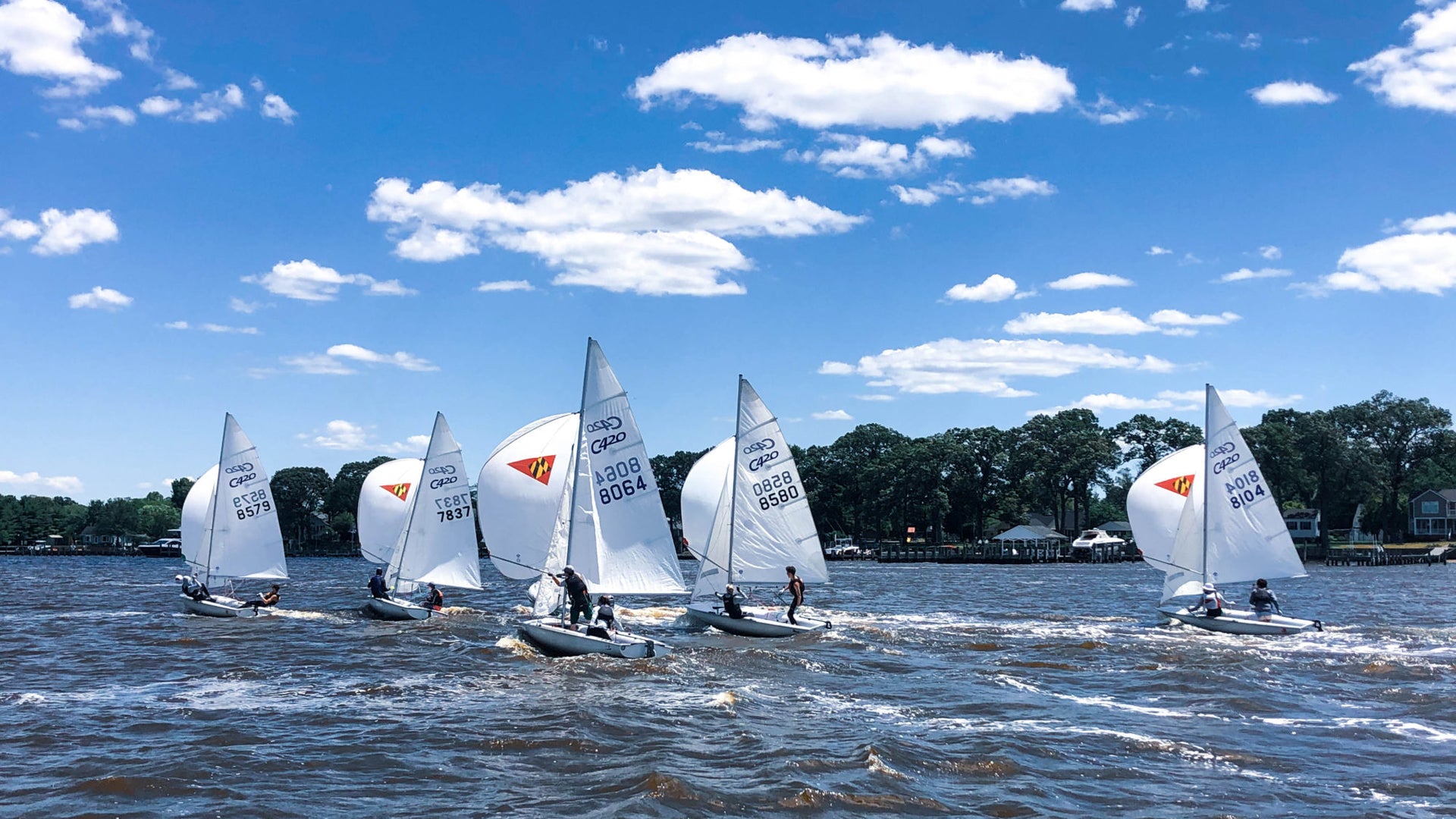
SAIL1DESIGN + NORTH SAILS C420 & I420 CLINIC
SAIL1DESIGN + NORTH SAILS 420 CLINIC
Sailors Joined S1D and North Experts in Maryland
📸 North Sails
Organized soon after the State of Maryland lifted boating/sailing restrictions and careful to mind all social distancing policies and procedures, the 29-31 May North Sails “C&I” 420 Clinic found some very eager participants, who could not wait to get out on the water and get back to sailing.
Limited to six top local teams, chosen by experience and resume, the clinic featured Coach Lior Lavie, an Olympic-level sailor and a highly experienced and successful coach, and North Sails rep Tom Sitzmann. The Clinic was held at Sail1Design, a private venue on the Magothy River, just north of Annapolis, MD.
📸 North Sails
As many know the 420 class sailboat has, in fact, two separate organizing classes, the International 420, and the Club 420. Coming soon will be a detailed article on these two classes, compared, so stay tuned. For now, and very briefly, here is a quick look:
International 420 Class
• Truly an international class, with fleets around the world
• Tapered spar, high performance foil and sailmaker options. The class maintains strict rules but does allow sailors to buy their own favorite brand of foils and sails.
• Rig tuning includes allowing spreader adjustment
• Minimum hull weight is 176.4 lbs.
• Boat will plane upwind and downwind in moderate wind conditions
• Class organization is very strong; USA class participation is good, attracting many of the most talented youth sailors in the country
• The choice for the US Youth double-handed championship
Club 420 Class
• USA only
• Non-tapered spar, can use only class foils and class sails (North Sails is the sailmaker for the C420 class). Hull must have rail bumper. Rules are designed to promote durability.
• Minimum hull weight is 230lbs.
• Boat will plane downwind, not nearly as much or as often upwind when compared to the i420
• Class organization is very strong, class participation is excellent, often with 60+ boats attending major National-level events.
📸 North Sails
One of the goals of this clinic was to expose sailors, first-hand, to the distinctions between the i420 and the C420. North Sails expert Tom Sitzmann, who is currently working on an all-new NS i420 tuning guide, shared some of the tips and tricks that make the North Sails i420 sails set up as they should be (for more information on North Sails i420 options, contact Tom) While both classes offer incredible opportunities for youth sailors, their tuning, trim, and focus points are distinct, and successful teams know these differences. Ultimately, the difference in each boat’s performance characteristics requires teams to dial in to the boat’s capabilities, and recognize tactics must change with boats that go different speeds.
On the first day, 2 i420’s rigged up along with three C420’s, and teams interested in trying out the i420 were able to do so. Coach Lior had both C and i420’s do the same drills, and it was really neat to see the boats out training together. One sailor commented “The i420 was planing upwind for us, almost right out of a tack; I was amazed at how that boat accelerated and seemed to lift up right away.”
Graeme Woodworth, whose son Luke participated in the clinic and was himself a top youth i420 and All-American collegiate sailor, noted that these two classes, back in the 1990’s, did have some overlap, and that the c420 National champion used to be given a spot at the i420 World Championship.
For the rest of the weekend the group all sailed C420’s to make things even, and Coach Lior had the group work relentlessly on boat-handling, and spinnaker sets, jibes, and take-downs. It’s quite likely that the teams did more spinnaker work in these three days than at any other time in their lives, and the improvements were noticeable and impressive. In the end, the group had three days of near perfect weather conditions, and all learned a great deal.
For more information on 420 sailing and i420 sails, contact North Sails today!
420 Tuning Guide Contact Tom
📸 North Sails
READ MORE
READ MORE
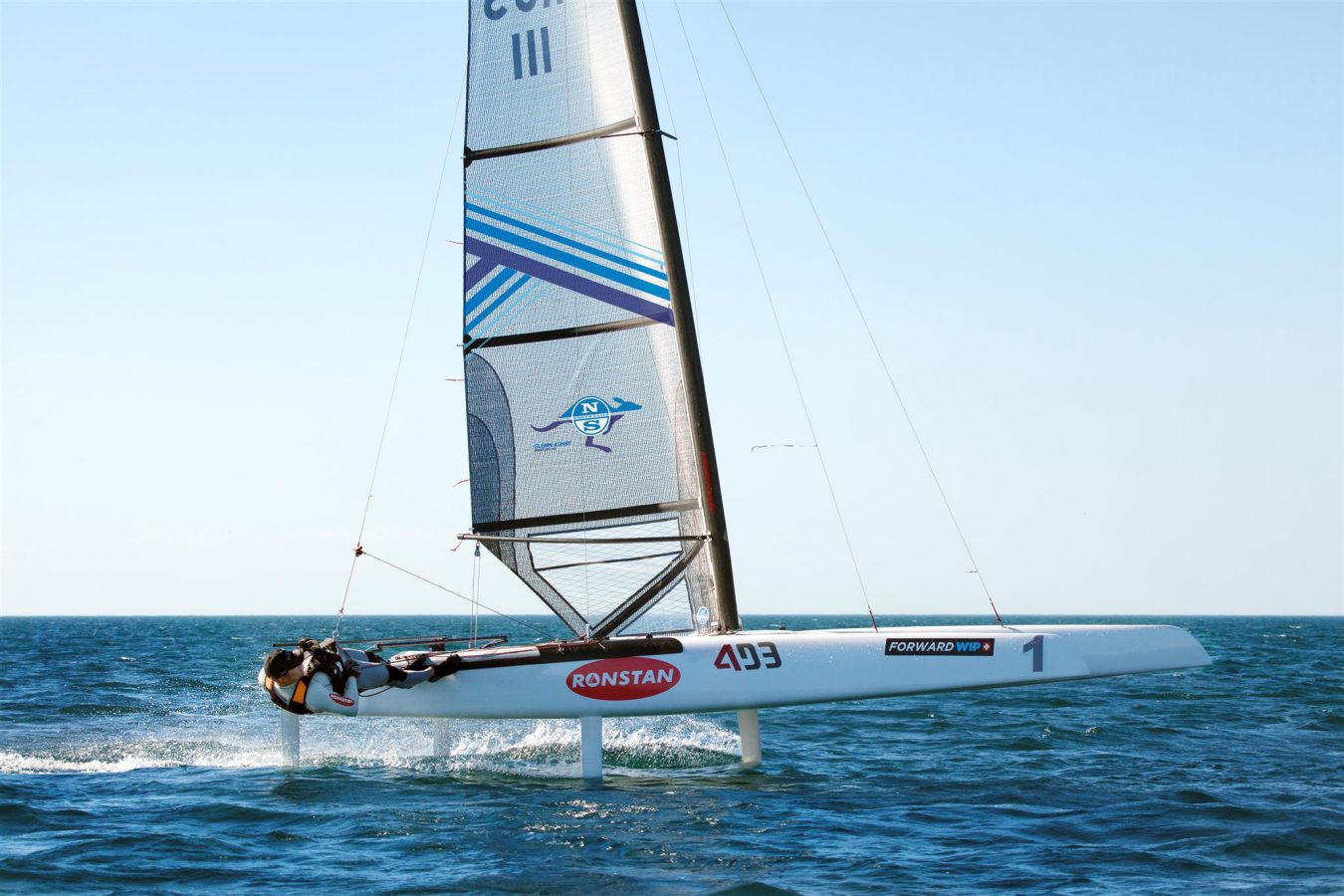
2020 NORTH A-CLASS INVENTORY
2020 NORTH A-CLASS INVENTORY
Optimized Designs for Boat Types, Masts and Sailor Weight
The North A-Class Catamaran inventory is customized to complement your gear. Find below our sail selection charts which shows the sail that best suits your weight, mast and sailing conditions.
Foiling Boats
SAILOR WEIGHT
All 14 & 15 Untapered Fibrefoam
DNA Tapered Fibrefoam 6.3 to 6.5 Hounds Height
Saarberg Mast
Above 78 kg
Decksweeper 2F
Decksweeper 2
Decksweeper 2
Below 78 kg
Decksweeper 2F
Decksweeper 2F
Decksweeper 2F
Classic Boats
SAILOR WEIGHT
All 14 & 15 Untapered Fibrefoam
DNA Tapered Fibrefoam 6.3 to 6.5 Hounds Height
Saarberg Mast
Above 78 kg
Classic Decksweeper 1F
Classic Decksweeper 1
Classic Decksweeper 1
Below 78 kg
Classic Decksweeper 1F
Classic Decksweeper 1F
Classic Decksweeper 1F
SAIL MODEL
BOAT TYPE
Classic Decksweeper 1
Classic
Classic Decksweeper 1F
Classic
Classic Decksweeper 2
Foiling
Classic Decksweeper 2F
Foiling
SHOP SAILS
READ MORE
READ MORE
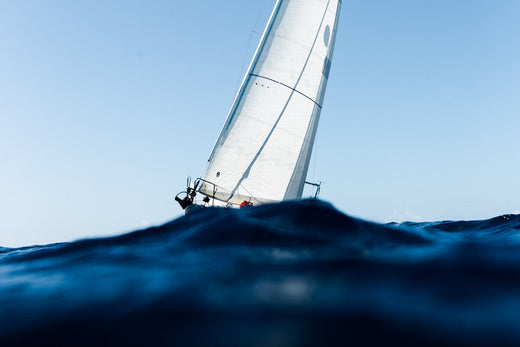
INTRODUCING THE 3Di OCEAN LINE UP
After an exhaustive research and development program, North Sails is thrilled to launch 3Di OCEAN 370, our latest innovative sail product that completes a line-up of 3D molded sails dedicated to cruising.
READ MORE
READ MORE
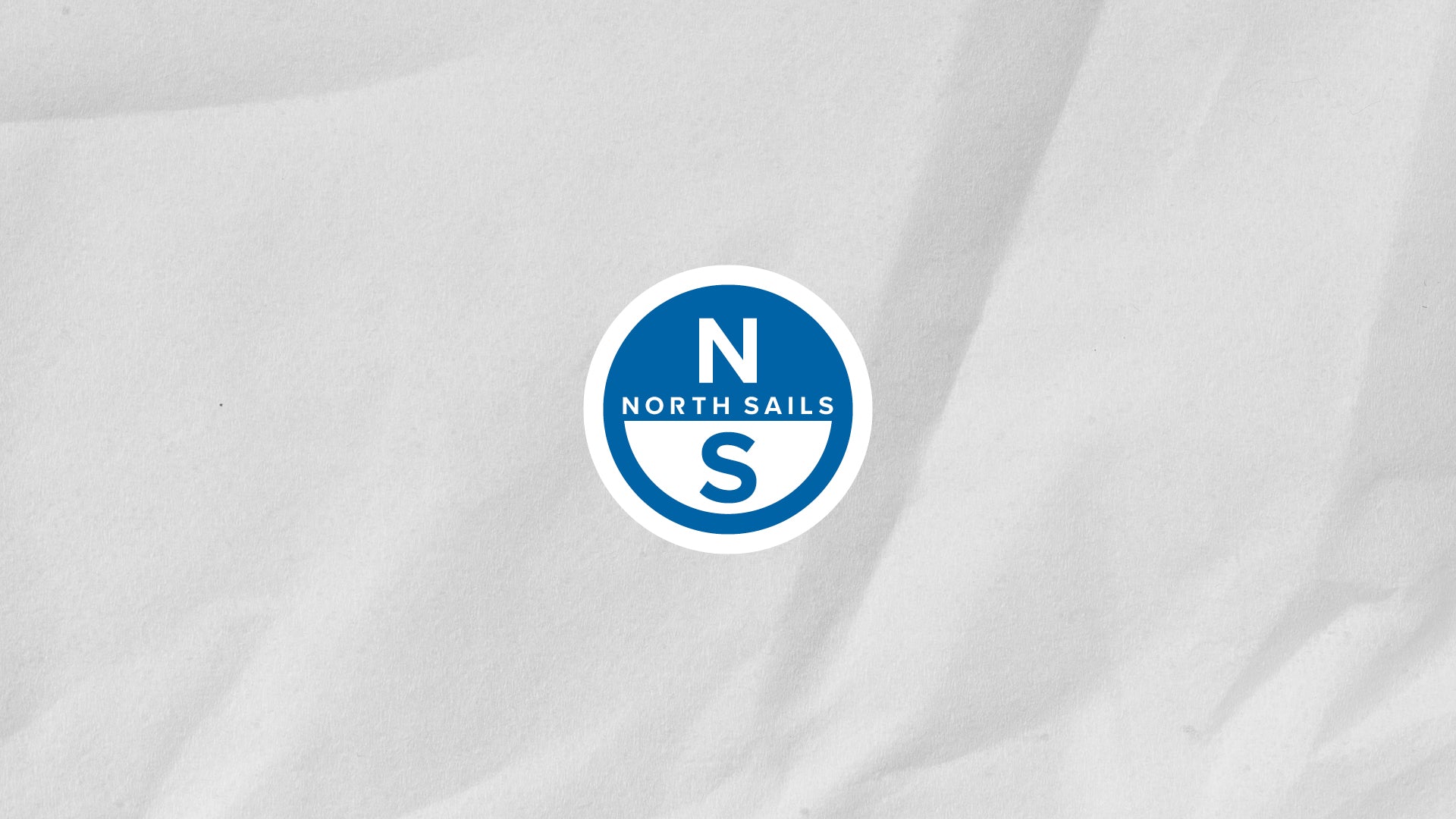
BENETEAU FIRST 18 SE & SEASCAPE 18 TUNING GUIDE
Beneteau First 18 SE & Seascape 18 Quick Tuning Guide.
QUICK TUNING NOTES
TWS
0-4
4-8
8-12
12-16
18+
Mast Rake
8,64m
Shrouds Tension
Loos Tension Gauge 91 Model A
34
36 Base Setting
38-40
42-44
45-46
Shroud Turnbuckles
(Full Turns)
-1
0
+1 to +2
+3 to +4
+5 to +6
JIB
Cunningham
Light
Light/Medium
Medium
Medium/Tight
Tight
Clew
(Older option)
Upper
Upper
Upper
Upper
Upper
Traveler
(New option)
Middle
Middle
Middle
Middle
Middle
Twist
Medium
Minimum
Minimum/Medium
Medium
Medium
Cross Sheeting
No
No
No
No
No
MAINSAIL
A-Frame (distance - blocks)
5-10 cm
1-3 cm
1-3 cm
3 cm
Play in puffs
Outhaul (mid-foot from boom)
8-10 cm
8-10 cm
5-8 cm
Tight
Tight
Vang (Kicker)
Snug
Snug
Medium
Hard
Hard
Cunningham
No
Light
Light/Medium
Medium/Max
Max
Twist
Medium
Minimum
Minimum
Minimum/Medium
Lots
Keel Position
88° - 85°
85°
85°
85°
85°
Downwind
(App. Wind Angle)
85° - 100° Speed
90° - 130° Speed & Soaking
110° - 140° Speed & Soaking
120° - 150° Speed & Soaking
100° - 130° Speed & Soaking
Seascape 18 Speed Guide
UPWIND
TWS
BS
VMG
HEEL
AWA
AWS
TWA
TACK
6
3.9
2.9
9°
25°
9.3
42
90
8
4.7
3.5
10°
25°
12
40
86
10
5.1
4.0
12°
25°
14.4
38
84
12
5.2
4.2
15°
25°
16.5
36
80
14
5.3
4.3
16°
26°
18.5
36
75
16
5.3
4.3
16°
27°
20.6
35
75
20
5.4
4.4
18°
28°
24.6
35
75
DOWNWIND
TWS
BS
VMG
HEEL
AWA
AWS
TWA
JIBE
6
3.9
3.2
5°
109°
3.5
147
85
8
4.8
4.1
5°
115°
4.7
148
80
10
5.4
4.7
6°
122°
6
150
70
12
5.8
5.0
6°
128°
7.5
150
65
14
6.2
5.4
6°
130°
9.1
150
65
16
7.6
6.1
7°
118°
11
143
75
20
12.1
8.8
10°
100°
14
137
80
READ MORE
READ MORE

WHO WE ARE: CHRIS WALTER
WHO WE ARE: CHRIS WALTER
Get To Know Your Local Service Expert
Chris Walter is part of the service team at the Vancouver loft and has been with North Sails for seven years. He is 34 years old from Vancouver and the first boat he sailed on was a Cooper 353.
What is your favourite local regatta/race and why?
Too many to choose from, I love them all. The top would be the Columbia Gorge One Design Regatta (CGOD). Who doesn't love 20 knts, temp in the mid 30s and bathtub warm water? All in a spectacular Venue. The Vanisle 360 is also a favourite. The scenery is amazing and it's a real challenge both physically and mentally.
Where is your favourite spot to go cruising and why?
Anywhere I can get to. The whole coast of B.C. is beautiful.
What is your favourite design of boat and why?
The IMOCA 60 is my favourite design because of the forefront of design in ocean racing; plus the crazy people who sail them!
What is it about sailing that you enjoy the most?
I enjoy being outside and enjoying nature in addition to the power of the elements.
What activities you enjoy outside of sailing?
I enjoy skiing. I've been skiing since I was a kid at various resorts. Now a days, I ski with my brother at Sun Peaks.
Tell us something interesting about yourself that most people would not know.
I have never lived on land. I was born and have lived on a sailboat my entire life. First we lived on a Cooper 353 them a Brandlmayr 48. We had a dog growing up who lived on the boat with us, a schipperke, as well as a couple of hamsters.
How have you been keeping busy since all racing has been cancelled?
I've been fixing up my old boat, a C&C 32, mostly replacing all the things that slowly break on a nearly 40 year old boat. I added lazyjacks and sail bag, similar to what boats in ocean races use. I still have a regular sail cover for when I'm not sailing but this new one will contain the sail better while I'm out sailing. I've never raced the boat however was planning to do the Round Bowen race this year and perhaps a single handed race; we'll see what happens.
READ MORE
READ MORE
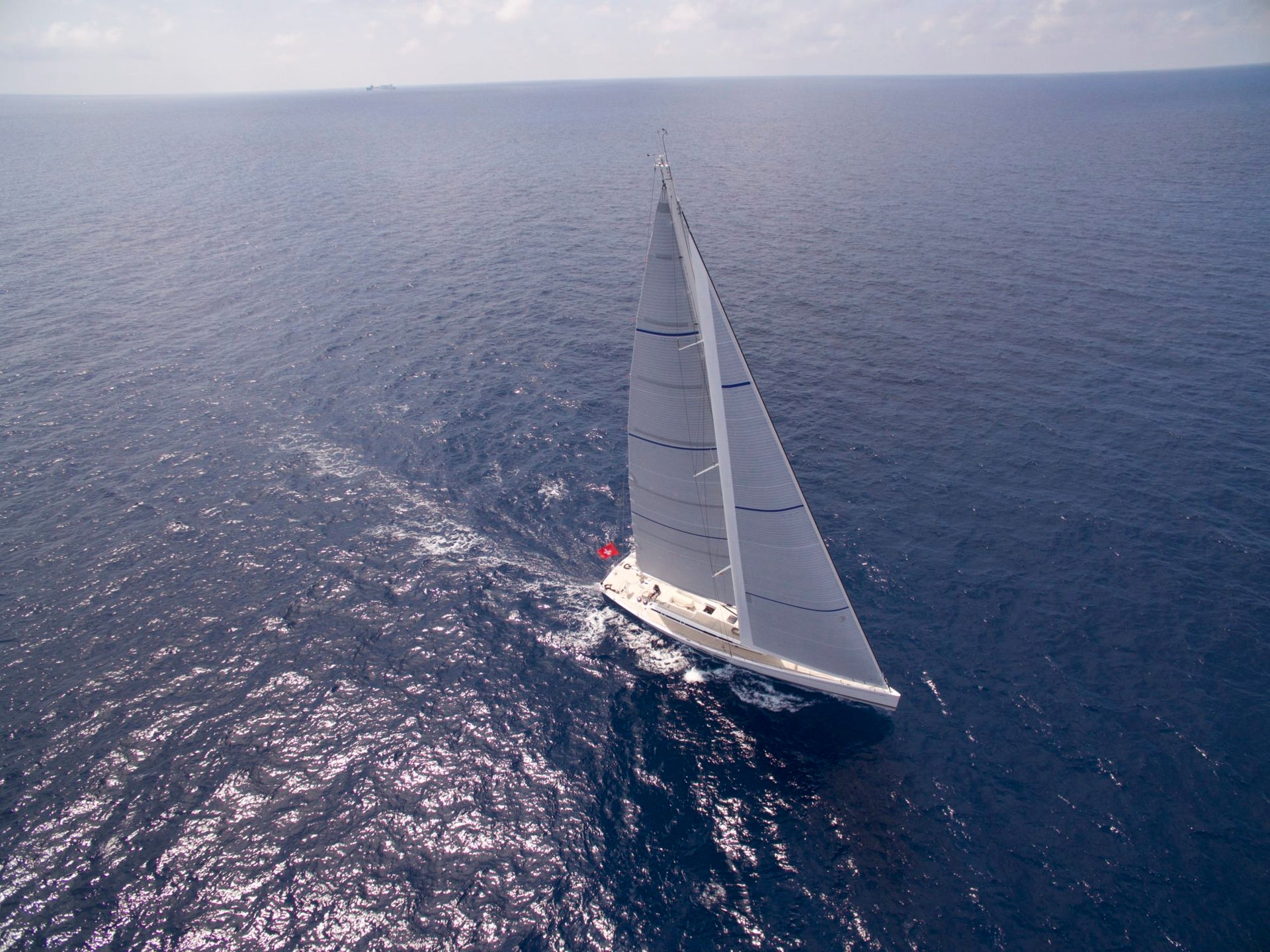
NEW SAILS FOR SUMMER
NEW SAILS FOR SUMMER ON A SWAN 80
Sail Expert Brad Favelle Shares His First Impressions
Brad Favelle, North sail expert based in Palma de Mallorca runs us through the delivery of some new sails which is always a refreshing experience. We met with Brad after installing a set of Swan 80 sails ready for summer cruising. He provides us with an on-the-ground view and shares his first impressions.
Explain the sail installation process. Once the client picked the sails, what was the first step to getting them on the boat once production concluded?
The sails are quite large on an 80-footer, so there was a fair amount of planning to get the sails to the boat and loaded on board. With the help of a forklift and the North Sails crane we lowered the sails onto the deck as the boat hit the water. Once the sails were safely on deck we started with the preparations of un-rolling in the correct position, then we used shackles and lashings to ensure the attachment points were set up correctly. Afterwards we loaded battens and applied the correct tension along with halyards to ensure all were hoisted ready for furling and boom reefing systems.This time is well spent along with the fine-tuning, which allowed us to create the best loading profiles for the sail and usability for the rig and deck systems onboard.
We can assess the results of the product and sail setup by conducting sea trials, which are beneficial to us as sail designers and experts, and to the crew. We enjoy sharing our expertise with the crew so they can help make their owner’s experience even more enjoyable whilst onboard.
What was it like seeing the new sails hoisted for the first time?
To see the sails hoisted for the first time was not only rewarding but highly pleasing from a sail design and production point. Making sure the design was optimal and that the sails fit perfectly was one of my main goals when taking on this project.
What were the client’s first remarks once they saw the sail up?
As any sailor knows, the best way to judge the result is through the enjoyment of a balanced helm and smiles as we powered through the perfect sea conditions. As we trimmed in the sails, we quickly picked up speed and the level of enjoyment set in for all on board. We were all delighted to be out on the water again.
What kind of conditions did you have for the first sail?
For our first sail, we had roughly 14-16 knots with a slight sea state. We had two crew: two North Sails Experts and an additional Industry professional. We couldn’t have asked for better conditions, which helped to make the entire experience productive and fun for the captain and crew.
Why is 3Di OCEAN 700 best for this type of yacht? Explain the features and benefits.
3Di OCEAN 700 is optimized for this size yacht as it delivers an exceptional level of modern cloth engineering. The blend of the internal tapes uses custom layouts and the chafe resistant surfaces provides the balance between durability and performance.
I feel that OCEAN 700 is a great package for the client because of its user-friendly handling and trim characteristics. Also, its color looks particularly great against the white hull. 3Di OCEAN 700 is the right choice for blue-water superyachts, with aramid and UltraPE filament tapes, making her highly durable and strong. Everything about 3Di OCEAN 700 is for cruising performance perfection.
What was the total production time once the order was placed to when they arrived on the scene?
SY Swan 80’s sails were ordered in mid-December of 2019. Once the new year arrived, North sail designers Flavia Tomaselli, Heine Sorensen and myself went through the details with the boat captain Kelsey, allowing us to configure the sail design and specification in January of 2020. In May, the sails were delivered to the boat.We’ve built a positive relationship with the boat captain, through our after-sales care and service team approach which helped confirm the order.
How long did it take to install the new sails once delivered?
Once the sails were delivered 3 North Sails Representatives help make short work of this process. The headsail did not contain battens, so that was straightforward. We attached a hoisting halyard and adjusted the halyard while attaching the sheets. The mainsail required the battens and cars to be fitted, and then we got the foot lashed on. The cars are then attached to the rig one at a time, then the reef lines which completes the loading onto the boom. All in all, the entire process took roughly five hours. Our external team delivers the onboard support to ensure this is a fluid process for the crew and captain.
Describe your first sail. What were the three main things you noticed?
Our first sail went great, 3Di will look good on any Swan. The finishing points on the sail were perfected with utmost detail and care. The flying shape of the new sails works in hand with the balance, feel and characteristics of the boat.
How long have you been working with the Swan 80 client?
I’ve been working with the boat captain for eight years. Kelsey and I have worked together on multiple projects for different boats, so it was a natural fit for him to continue his relationship working with North Sails here in Palma.
Through the industry-leading local port facilities and superyacht sail service hub, we are positioned perfectly to support all of the client needs for many years to come after the sails are delivered. Meeting the local demands, along with the high expectations of every client we see passing through the island, is our primary goal.
We have a passionate team that works hard to achieve these types of results. Delivering new sails is always a great way to spend a day in Mallorca! As sailmakers, we are ever-evolving the ways we provide the best for our clients.
READ MORE
READ MORE
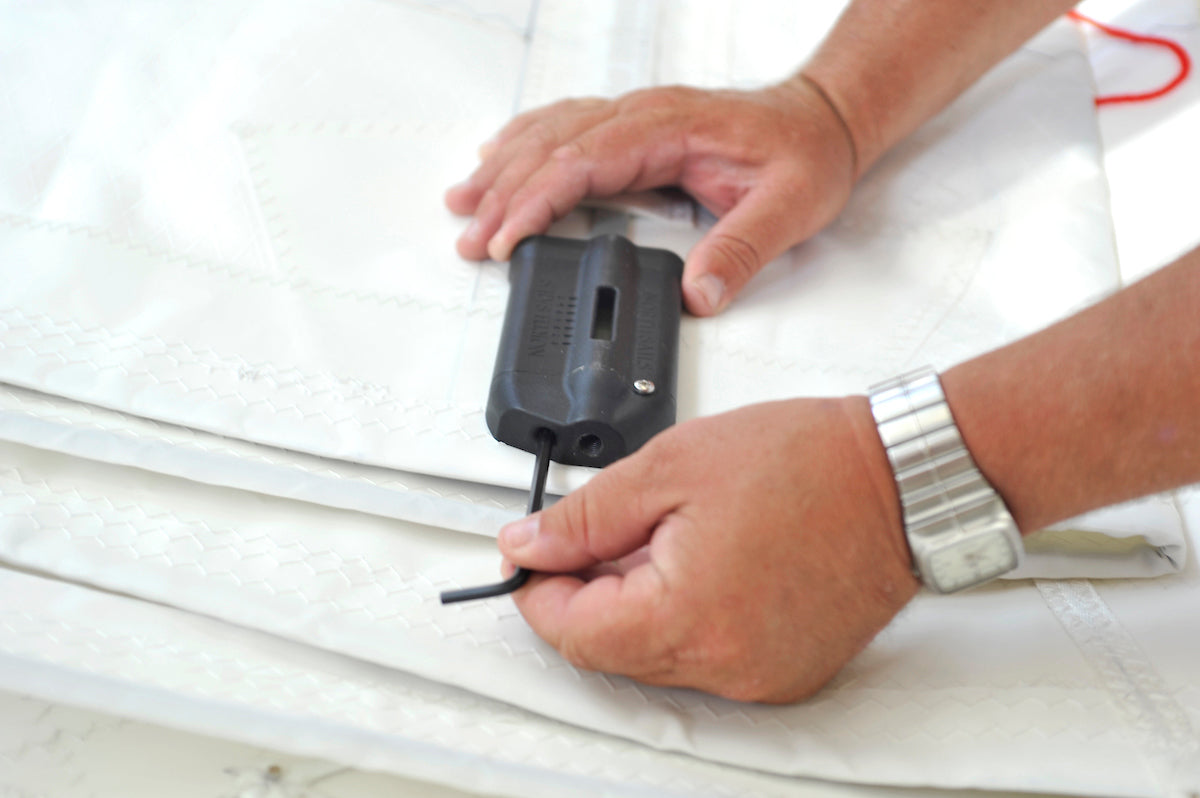
BATTENS 101
BATTENS 101
How To Install Three Common Batten Types
North Sails expert Tom Pease of North Sails in Milwaukee shows us how to use the three most common types of batten closures: velcro stuff, lace in and wing tip. To learn more about tensioning and installing battens for cruisers, see here.
READ MORE
READ MORE


